Inbox and environment news: Issue 613
February 11 - 17, 2024: Issue 613
Historic 100-Year-Old Mona Vale Tree To Be Replaced
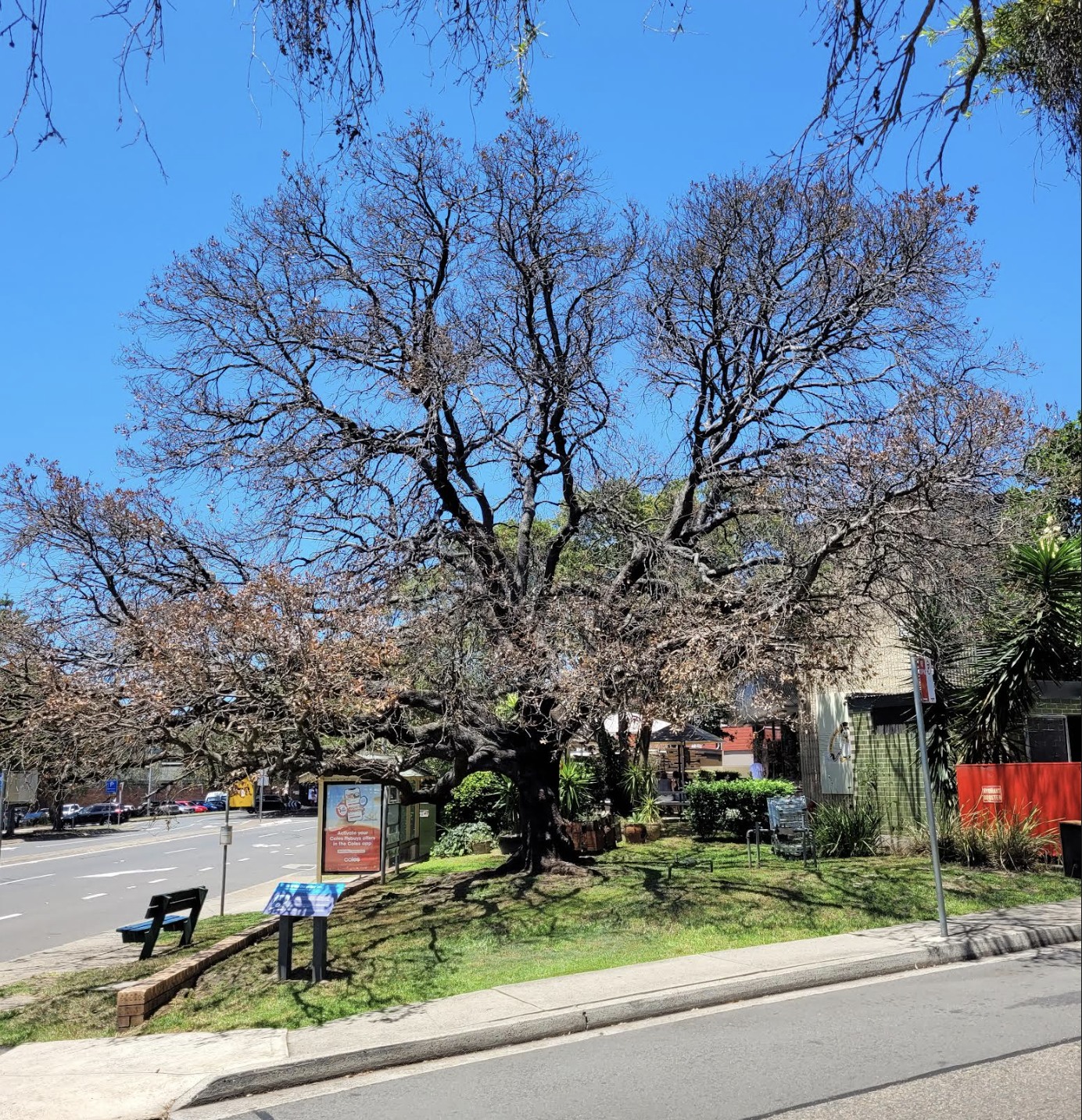
For over 100 years the Mona Vale Victory Tree has stood sentry at the site of the original local Methodist Church on Pittwater Road.
Planted to commemorate the end of World War I and in honour of the many fallen soldiers, the tree has succumbed to Armillaria Root Rot disease.
Armillaria root rot is a disease of trees and woody plants, although it also affects palms, succulents, ferns and other herbaceous plants. This disease is caused by fungi in the genus Armillaria, also known as “oak root fungus,” although the fungus has no specificity for oaks.
Overseas, the disease is reported to be caused by Armillaria mellea. But in Australia a related indigenous fungus Armillaria luteobubalina is the most common cause of Armillaria root rot.
The fungus can spread in several ways, but usually spread is from a woody food base such as an infected tree or stump, or a small piece of infected root.
Most spread is by root contact: the fungus grows from a diseased root into a healthy root via the point of contact of the roots. Rhizomorphs can grow from infected roots through the soil to roots of a nearby plant.
Occasionally, after an infected tree has died, honey-coloured clusters of toadstools grow from the base of the tree. These usually appear from May to July. The toadstools (the fruiting bodies of the fungus) have honey-coloured to deep brown caps covered with scales, whitish gills and yellow to brown stems with a pronounced ring or collar around the upper part of the stem
Airborne spores produced by the toadstools can be another method of spread, although these spores can only infect dead or injured wood.
Situated on private property, Council states it has worked with the property owner trying several treatments to save the tree. Over an eight-month period these treatments, recommended by Sydney’s Royal Botanic Gardens PlantClinic, were tested on the tree without success.
Council announced on Thursday February 8 it is now planning to plant another symbolic tree nearby as they are unable to plant in the same location due to soil contamination.
The century-old Holly Oak (Quercus ilex), an evergreen oak, was one of the remaining few of the original 200 trees planted across NSW under a Methodist Youth program, supplied with the assistance of Mr J H Maiden, Chief Botanist at Sydney Botanical Gardens.
The aim of the planting was for the relatives and friends of those who died to have a place to leave flowers and acknowledge their loved ones in the absence of a grave site.
Council’s Heritage Officer is assisting with guidance on preserving the tree’s heritage value.
The Mona Vale tree was planted in 1920 and became the first place Mona Vale ANZAC Day ceremonies were conducted by students and the community:
The Victory Tree.
To stand as a living expression of gratitude to God for victory in the great war, and to continually remind the youth of Methodism of the ideals for which our soldiers so nobly fought,' the Young People 's Department recently offered to present and forward to every Sunday School in the State a 'Victory Tree,' for planting in school or church grounds. The Department stipulated that applications should be made upon a prescribed form, which stated the conditions of gift, and a copy of which was forwarded to every Sunday School.
Below is a list of the schools ' that have made application for a tree, and to many of these the trees have already been forwarded. Superintendents and teachers are requested to scan the list, and if the name of their school does not appear thereon, to take steps to have an application lodged at the Y.P. Department's Office at an early date.
The trees are beautiful specimens of the kind most suit-able for the districts concerned, and the presentation of them is made possible by the kindness of Mr. Maiden, the Government Botanist: —
SYDNEY DISTRICT.— Rockdale, French's Forest, West Bexley, St. Ives, Bexley, Pymble, Turramurra, Wahroonga, Willoughby, Tempe Park, Bondi, Waverley, Malvern Hill, Chatswood (Central), Mona Vale...The Victory Tree. (1920, June 19). The Methodist (Sydney, NSW : 1892 - 1954), p. 4. Retrieved from http://nla.gov.au/nla.news-article155274628
Narrabeen Lagoon Entrance Blocked Again
Narrabeen lagoon entrance is blocked again, after recent storm swells, and Council spending $1.5. million on moving the sand south to Collaroy for weeks.
Council announced on Tuesday, 12 September 2023 work to clear Narrabeen Lagoon entrance to reduce the risk of flooding to local homes and businesses.
''Council contractors will excavate more than 20,000 cubic metres (40,000 tonnes) of sand – equivalent to the weight of 100 jumbo jets – to the east and west of Ocean Street Bridge.'' it was stated
The sand is to be deposited at Collaroy-Narrabeen Beach between Goodwin and Stuart Streets.
Works were expected to start in the coming weeks, although the above photo shows they were commenced immediately, and were completed in time for the Summer school holidays, which commenced on December 19 2023. This means the lagoon entrance was open for around 6.5 weeks prior to the big seas which moved so much sand over the past few days of weather conditions as the tail end of Cyclone Kirrily moved south.
After impacting Queensland, ex-Tropical Cyclone Kirrily crossed the border into western NSW on Monday afternoon, February 5, bringing heavy rainfall and flash flooding to inland communities, before reaching Sydney early the next day bringing 21mm of rain and localised flash flooding, along with strong winds.
This had preceded by swell set to peak at 4 to 4.5 metres in Sydney over the weekend of February 3-4.
However, at high tide about 6 inches of water still goes over the top of the entrance and into the lagoon. Joe Mills' (Turimetta Moods) sent in pictures this week of Pelicans standing in the shallow overflow at high tide - see below.
Joe said; ''They are waiting (with the Cormorants and Seagulls as well) for the small fish brought in by the waves.''
So - good for some residents of the lagoon.
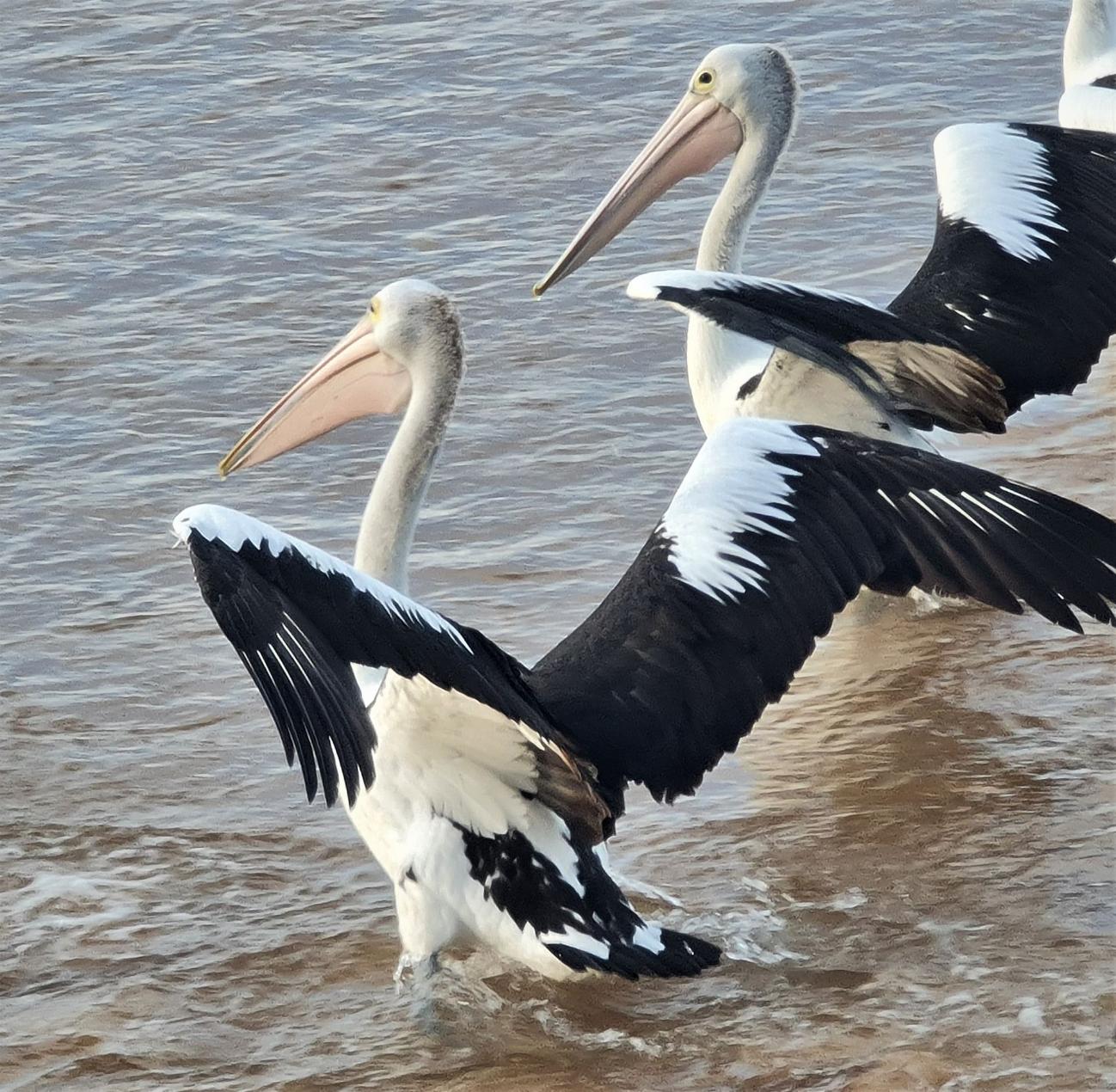
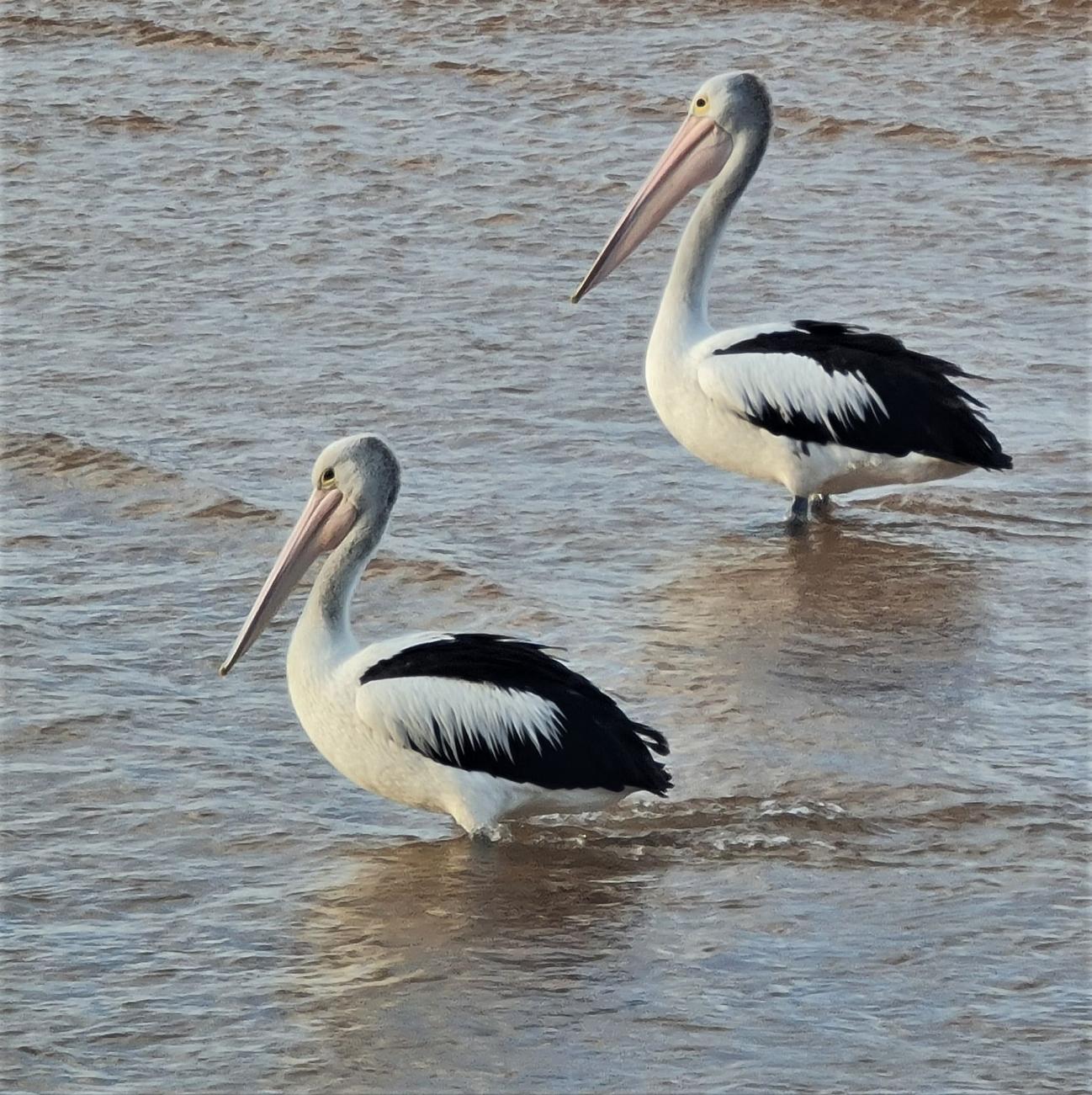
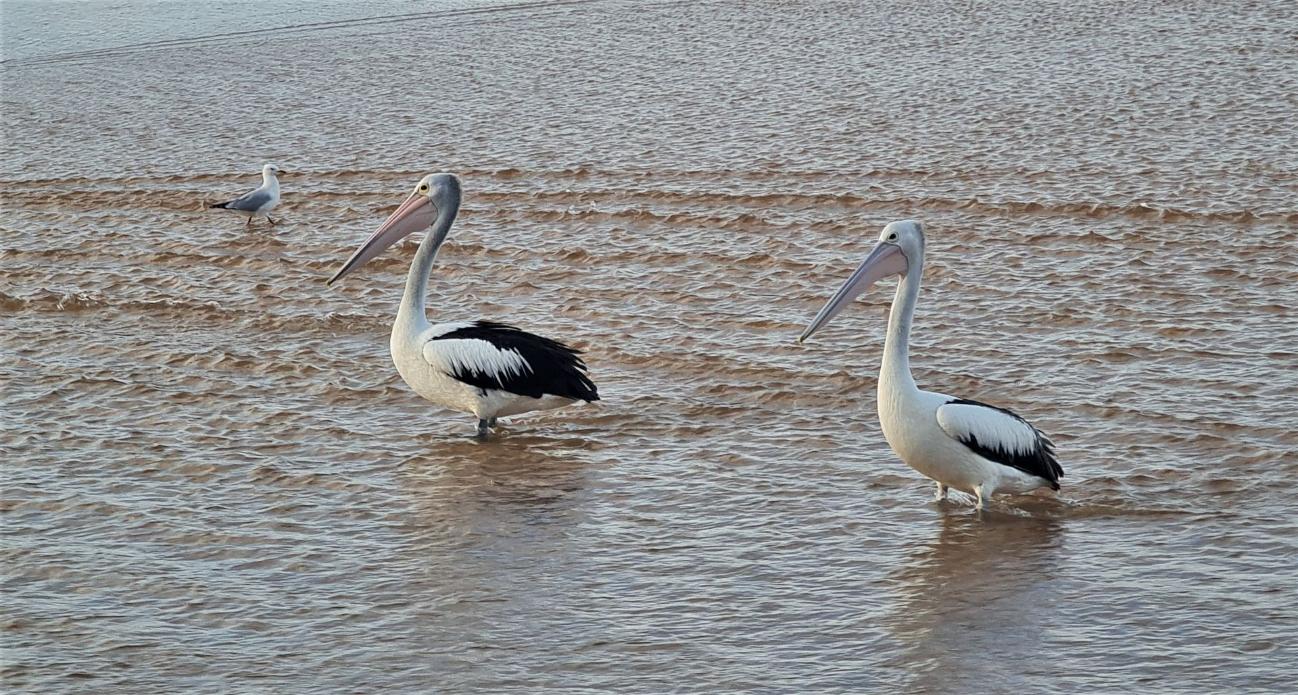

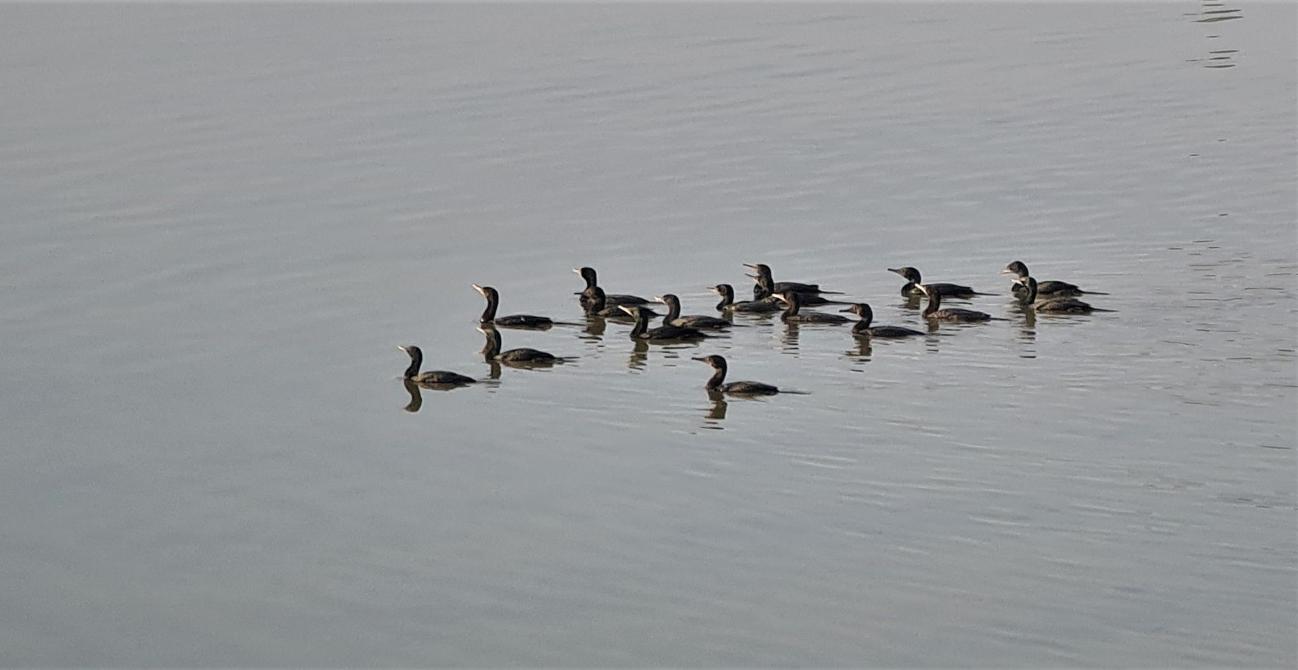
The Wonderful Songs Of The Butcher Bird - Summer In Pittwater: 15
Stinky Mushroom Worth Keeping Around
Australia's Climate In 2023: Warmer With Contrasting Rainfall - BOM
- Winter 2023 was Australia's warmest on record, with the national mean temperature 1.53C above the 1961–1990 average.
- September 2023 was Australia’s driest September on record with total rainfall around 70% below the 1961–1990 average, and the second driest month since national rainfall records began in 1900, behind April 1902.
- August to October 2023 was Australia's driest three month period since rainfall records began in 1900.
- Sea surface temperatures for the Australian region were the seventh-highest on record since 1900 at 0.54°C above the 1961–1990 average.
- Globally, sea surface temperatures were the highest on record – and each of the past 10 years have been among the 10 warmest on record.
- The state-averaged annual rainfall was 428.9 mm, which was 22.9% below the 1961–1990 average.
- Rainfall was above average over small parts of the state's south, west of the Great Dividing Range, while being below average over most of the northern half of the state, especially over parts of the Northern Tablelands, Northern Rivers, Mid-North Coast, and Upper Hunter, where annual rainfall was in the lowest 10% of historical records (since records began in 1900).
- A number of sites had their highest daily rainfall on record.
- Moruya (Kiora) had its highest total rainfall on record.
- The state-averaged annual maximum temperature was 1.96 °C above the 1961–1990 average, which is the third-highest on record (since records began in 1910) and the highest since 2019.
- Maximum temperatures for March, June, August, September and December were in the top ten warmest on record for their respective months.
- Maximum temperatures were very much above average over most of the state, with north-west parts of the state being highest on record.
- The state-averaged annual minimum temperature was 0.63 °C above the 1961–1990 average.
- Minimum temperatures were above average over northern and south-eastern parts of the state, as well as over central parts of the coast, while being below average over parts of the Riverina and the Central Tablelands.
- The state-averaged annual mean temperature was 1.30 °C above the 1961–1990 average, which is the equal sixth-highest on record.
- A number of sites had their highest mean daily maximum temperature on record.
- Scone Airport AWS and Mangrove Mountain AWS had their lowest temperature on record.
- A few sites along the South Coast had their warmest night (highest daily minimum temperature) on record.
- Ulladulla AWS had its highest mean daily minimum temperature on record.
- Mangrove Mountain AWS and Lismore Airport AWS had their lowest mean daily minimum temperature on record while a few sites had their lowest mean daily minimum temperature for at least 20 years.
- A few sites had their equal-highest mean temperature on record.
Harvest Seeds & Native Plants: Education Sessions 2024 - "The Harvest Huddle"
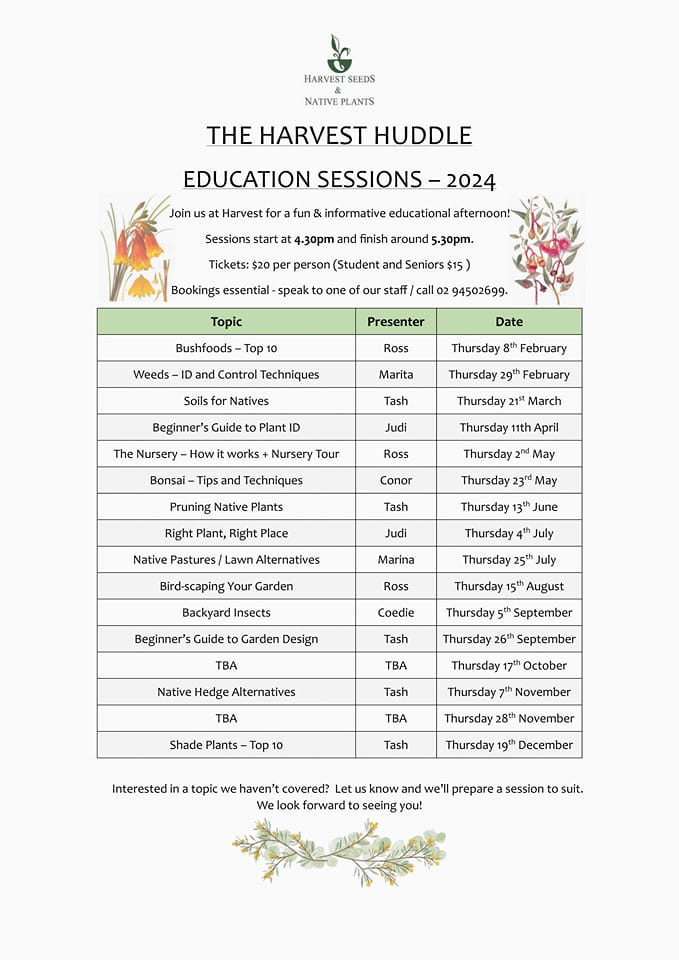
Notice Of 1080 Baiting: February 1 - July 31 2024
Please note the following notification of continuous and ongoing fox control using 1080 POISON with ground baits and canid pest ejectors (CPE’s) in Sydney Harbour National Park, Garigal National Park, Ku-ring-gai Chase National Park, and Lane Cove National Park. As part of this program, baiting also occurs on North Head Sanctuary managed by Sydney Harbour Federation Trust and the Australian Institute of Police Management facility at North Head.
This provides notification for the 6 monthly period of 1 February 2024 – 31 July 2024.
Warning signs are displayed at park entrances and other entrances to the baiting location to inform the public of 1080 baiting.
1080 Poison for fox control is used in these reserves in a continuous and ongoing manner. This means that baits and ejectors (CPE’s) remain in the reserves and are checked/replaced every 6 – 8 weeks.
1080 use at these locations is in accordance with NSW pesticides legislation, relevant 1080 Pesticide Control Orders and the NPWS Vertebrate Pesticides Standard Operating Procedures.
A series of public notifications occur on a 6 monthly basis including; alerts on the NPWS website, public notices in local papers, Area pesticide use notification registers and to the NPWS call centre.
If you have any further general enquiries about 1080, or for specific program enquiries please contact the local NPWS Area office:
For further information please call the local NPWS office on:
NPWS Sydney North (Middle Head) Area office: 9960 6266
NPWS Sydney North (Forestville) Area office: 9451 3479
NPWS North West Sydney (Lane Cove NP) Area office: 8448 0400
NPWS after-hours Duty officer service: 1300 056 294
Sydney Harbour Federation Trust: 8969 2128
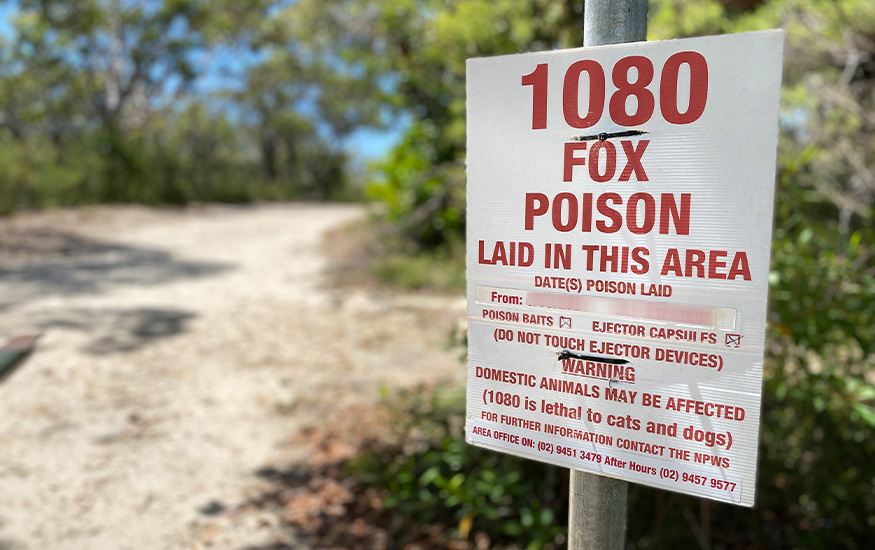
Pittwater Natural Heritage Association: First PNHA Nature Event 2024
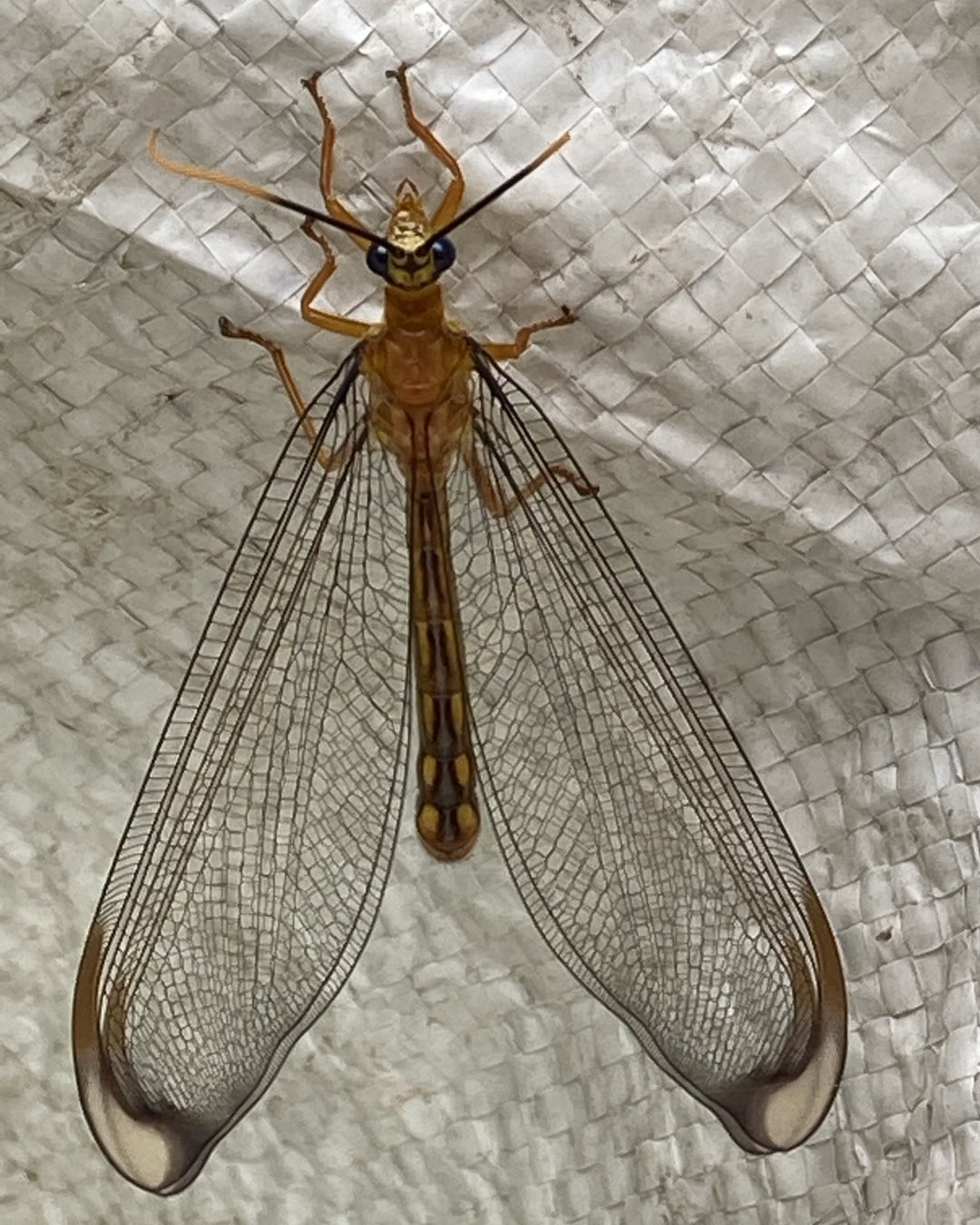
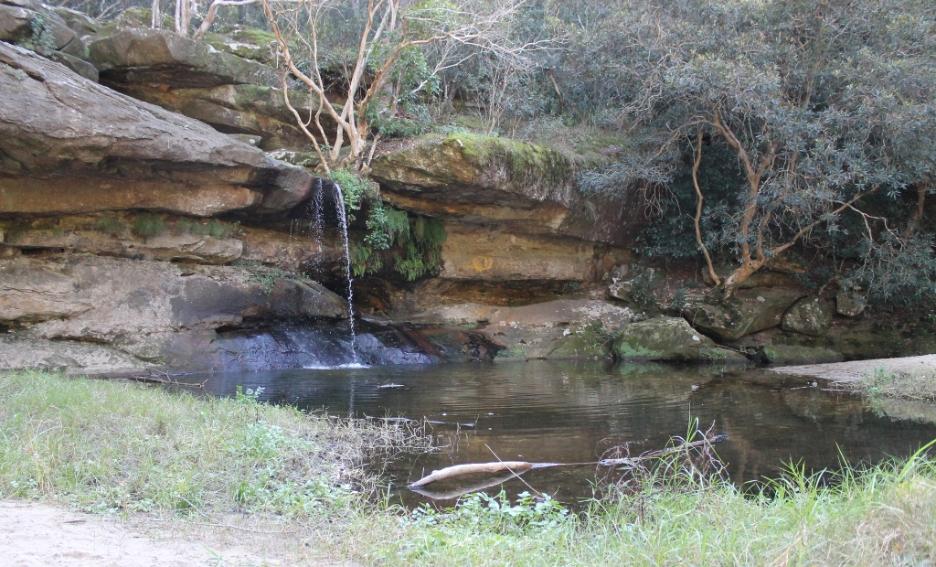
Northern Beaches Clean Up Crew: Bilgola Beach Clean - February 25
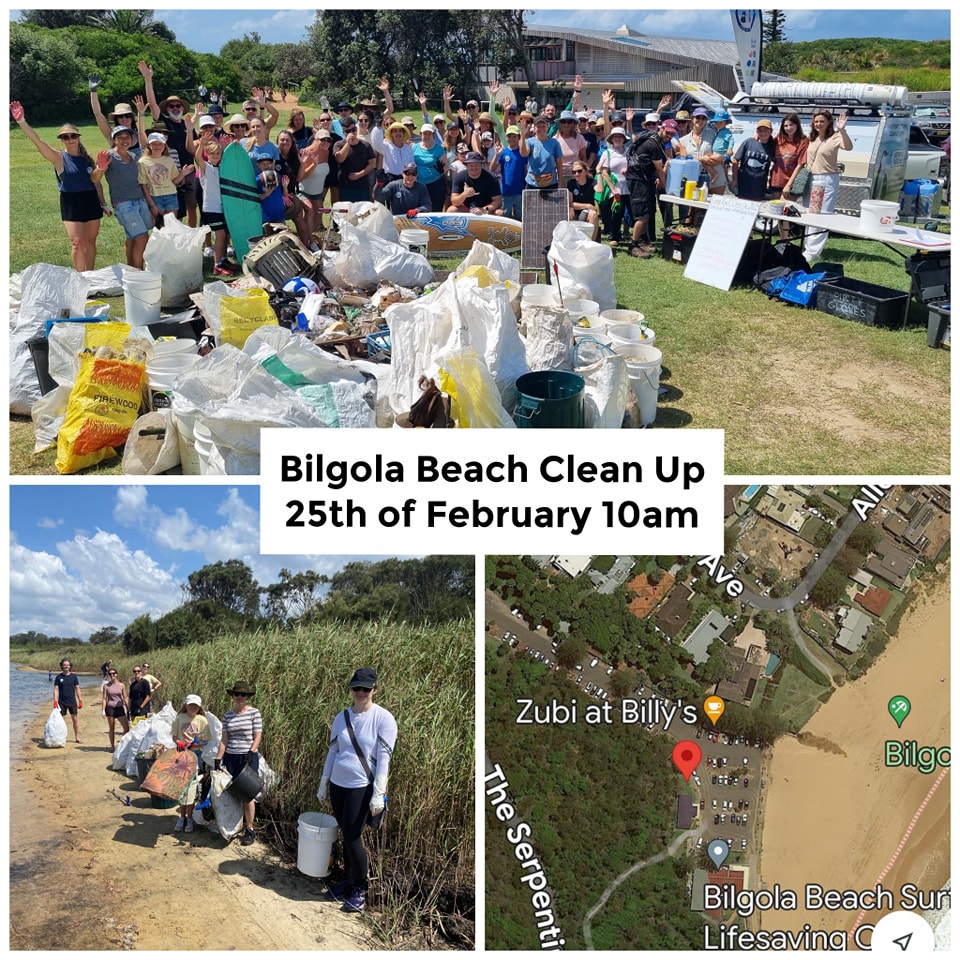
Clean Up Australia Day 2024 Registrations Are Now Open
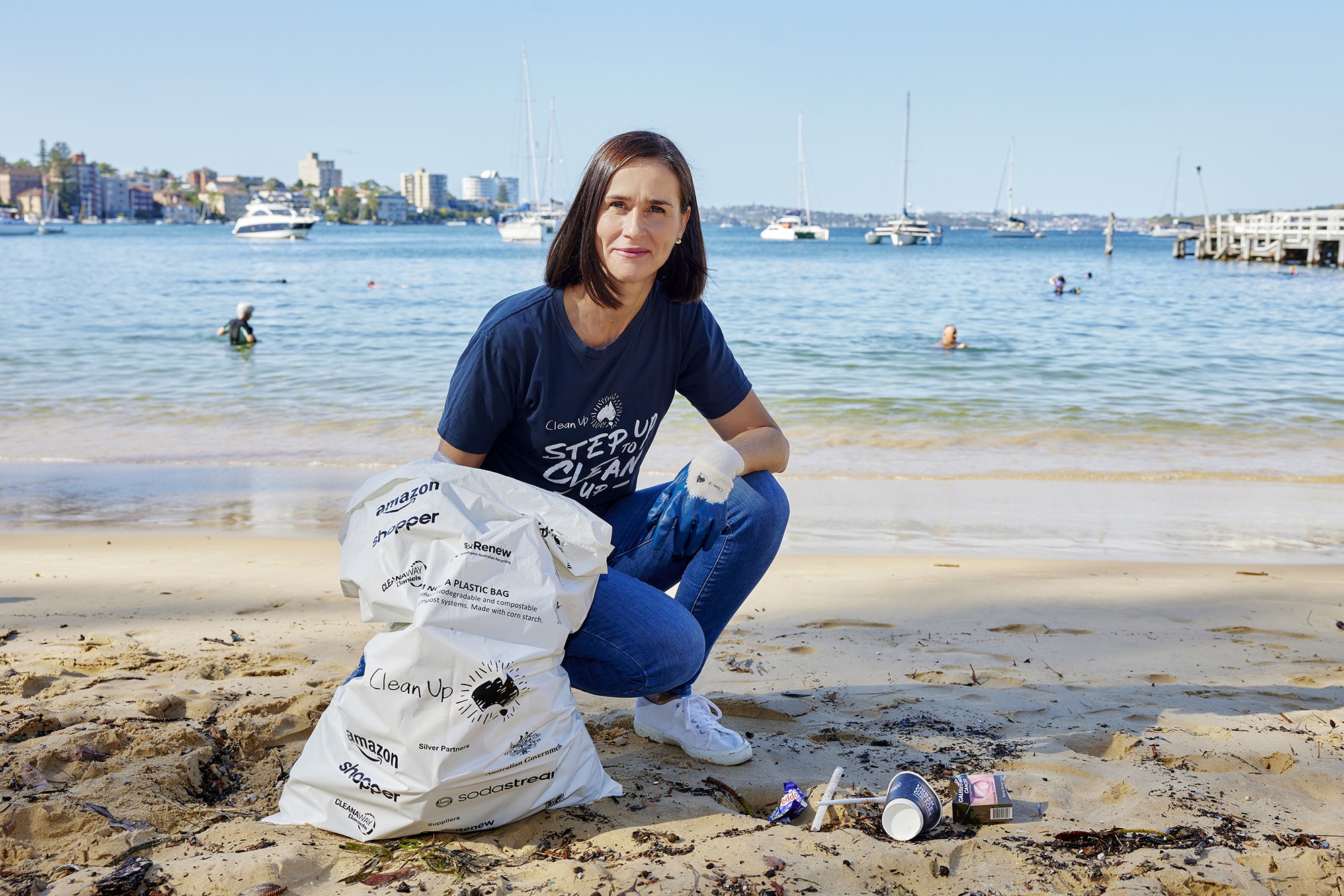
NEW At Eco House & Garden(At Kimbriki): 'Supporting School & Community Composts Workshop'
Where you can become part of the (waste) solution in our 3-hour workshop.
See below for more details and for bookings go to 👉https://www.trybooking.com/events/landing/1162545
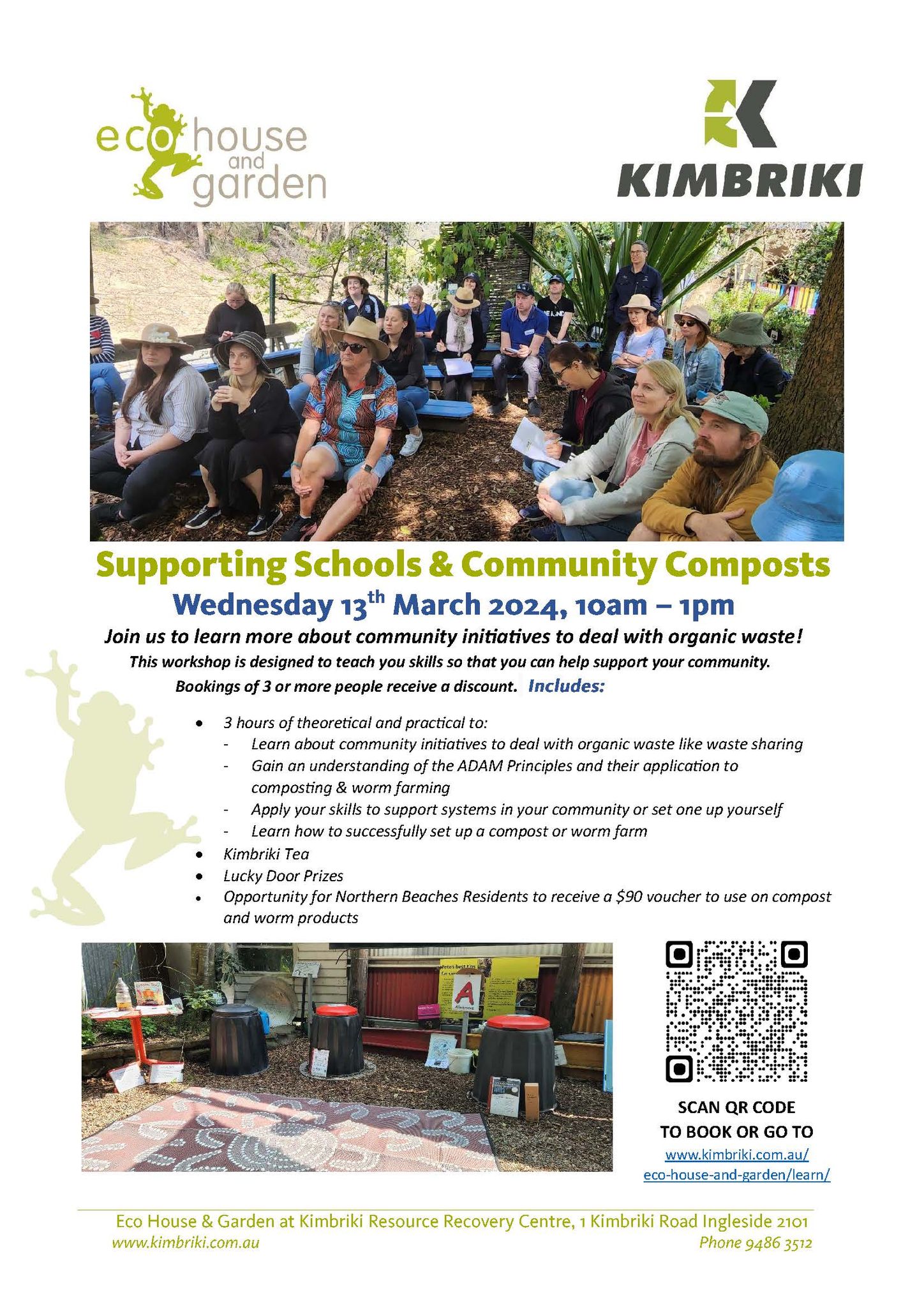
Kimbriki Resource Recovery Centre: Early Childhood Educators Professional Development Day
As part of Kimbriki's 2024 Eco House & Garden Educational Calendar, this year we introduce the Early Childhood Educators Professional Development Day on Friday 22nd March. For more details and bookings 👉 https://www.trybooking.com/events/landing/1162305
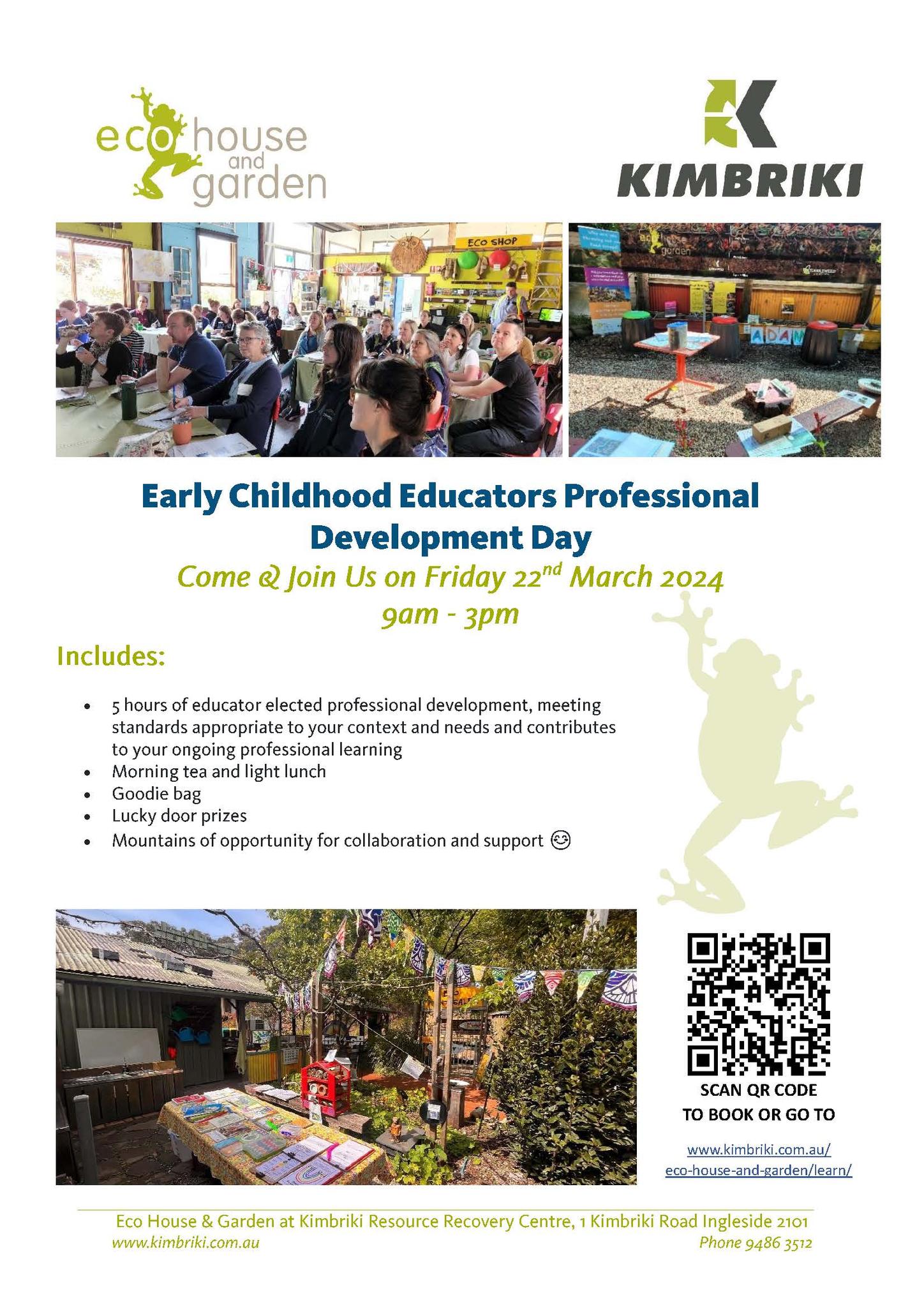
Coastal IFOA Forest Monitoring Review
Consultation period
From: 22 January 2024
To: 18 February 2024
The Natural Resources Commission is seeking your feedback on monitoring in NSW’s coastal state forests. The Coastal Integrated Forestry Operations Approval (Coastal IFOA) sets out the rules for native timber harvesting in NSW coastal state forests. These rules have been in place since November 2019.
A monitoring program has been established to assess the ongoing effectiveness of the Coastal IFOA in delivering its objectives and outcomes. The first program framework was approved in March 2020 and extends to 2024.
Get more information on the Coastal IFOA monitoring program.
The monitoring program must have a major review every five years, the first of which is due in 2024. This first review will focus on program progress and results, including trends. It will also assess the adequacy of the program and how it can be improved.
This review must include:
- detailed reporting of monitoring program progress and all results
- detailed analysis of trends
- an assessment of the adequacy of the monitoring program.
The Natural Resources Commission is undertaking the review as part of its role as the independent chair of a cross-agency Steering Committee that oversees the monitoring program.
To inform the review, we are seeking your thoughts on the first five years of the Coastal IFOA monitoring program, including any feedback on:
- Does the monitoring program provide useful information and insights that meet your needs? If not, what are the key gaps?
- Is the monitoring program and its findings clear and easy to understand, or can this be improved?
- Any other ways we can improve the monitoring program?
Have your say by Sunday 18 February 2024 via:
Email: nrc@nrc.nsw.gov.au
Mail: Address - Natural Resources Commission, GPO Box 5341, Sydney, NSW, 2001.
More information
Email: Project team
Phone: 02 9228 4844
Documents
Coastal Integrated Forestry Operations Approval Approved Monitoring Program 2019-2024 (PDF 2.38MB)
Stay Safe From Mosquitoes
- Applying repellent to exposed skin. Use repellents that contain DEET, picaridin, or oil of lemon eucalyptus. Check the label for reapplication times.
- Re-applying repellent regularly, particularly after swimming. Be sure to apply sunscreen first and then apply repellent.
- Wearing light, loose-fitting long-sleeve shirts, long pants and covered footwear and socks.
- Avoiding going outdoors during peak mosquito times, especially at dawn and dusk.
- Using insecticide sprays, vapour dispensing units and mosquito coils to repel mosquitoes (mosquito coils should only be used outdoors in well-ventilated areas)
- Covering windows and doors with insect screens and checking there are no gaps.
- Removing items that may collect water such as old tyres and empty pots from around your home to reduce the places where mosquitoes can breed.
- Using repellents that are safe for children. Most skin repellents are safe for use on children aged three months and older. Always check the label for instructions. Protecting infants aged less than three months by using an infant carrier draped with mosquito netting, secured along the edges.
- While camping, use a tent that has fly screens to prevent mosquitoes entering or sleep under a mosquito net.
Mountain Bike Incidents On Public Land: Survey
- Mountain Bike Incidents On Public Land: Survey Launched To Gather Data On What's Happening To Public Parks - Community Land - Bush Reserves In Pittwater
- Mother Brushtail Killed On Barrenjoey Road: Baby Cried All Night - Powerful Owl Struck At Same Time At Careel Bay During Owlet Fledgling Season: calls for mitigation measures - The List of 'What You can Do' as requested
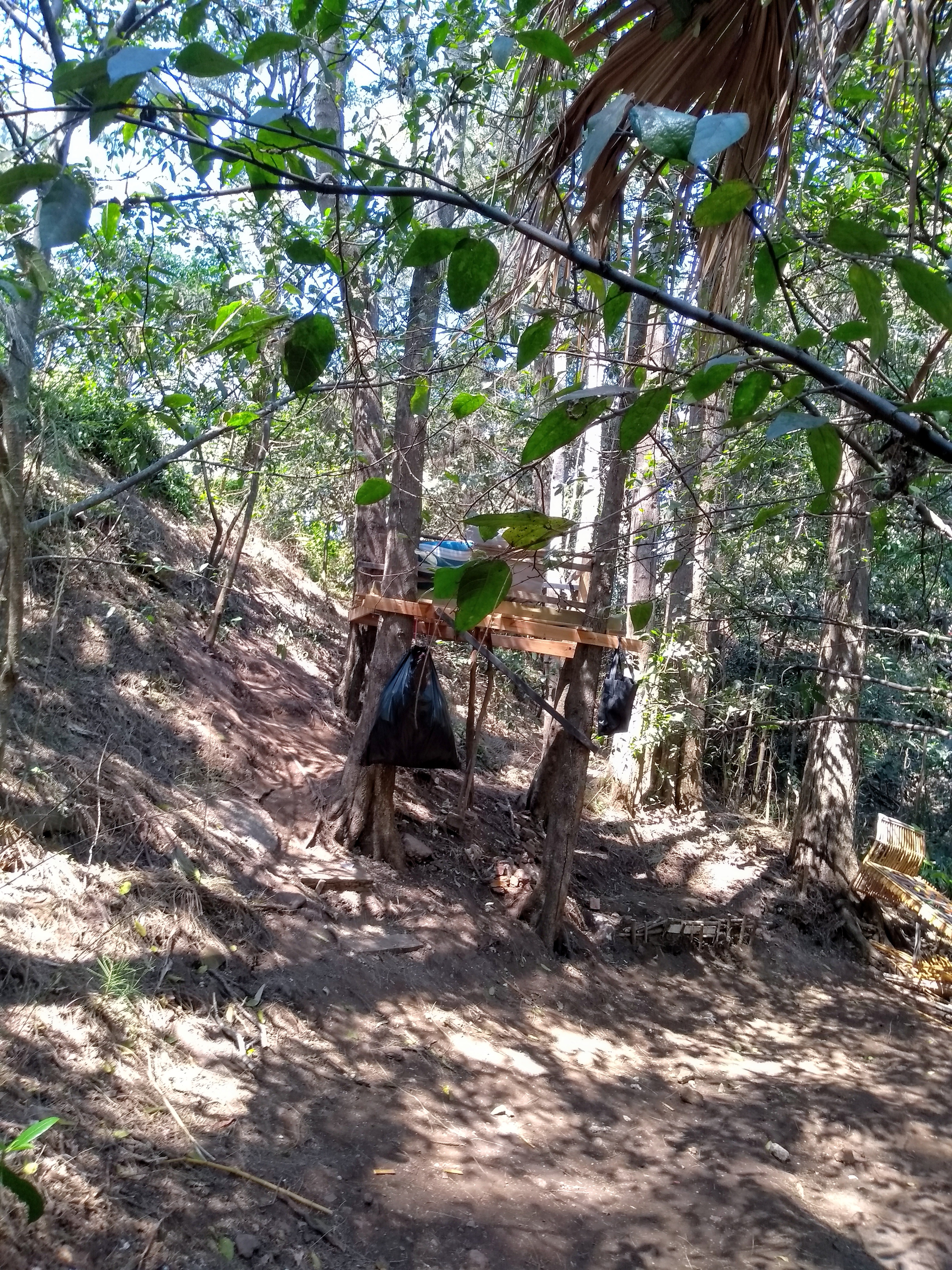
Please Look Out For Wildlife During Heatwave Events

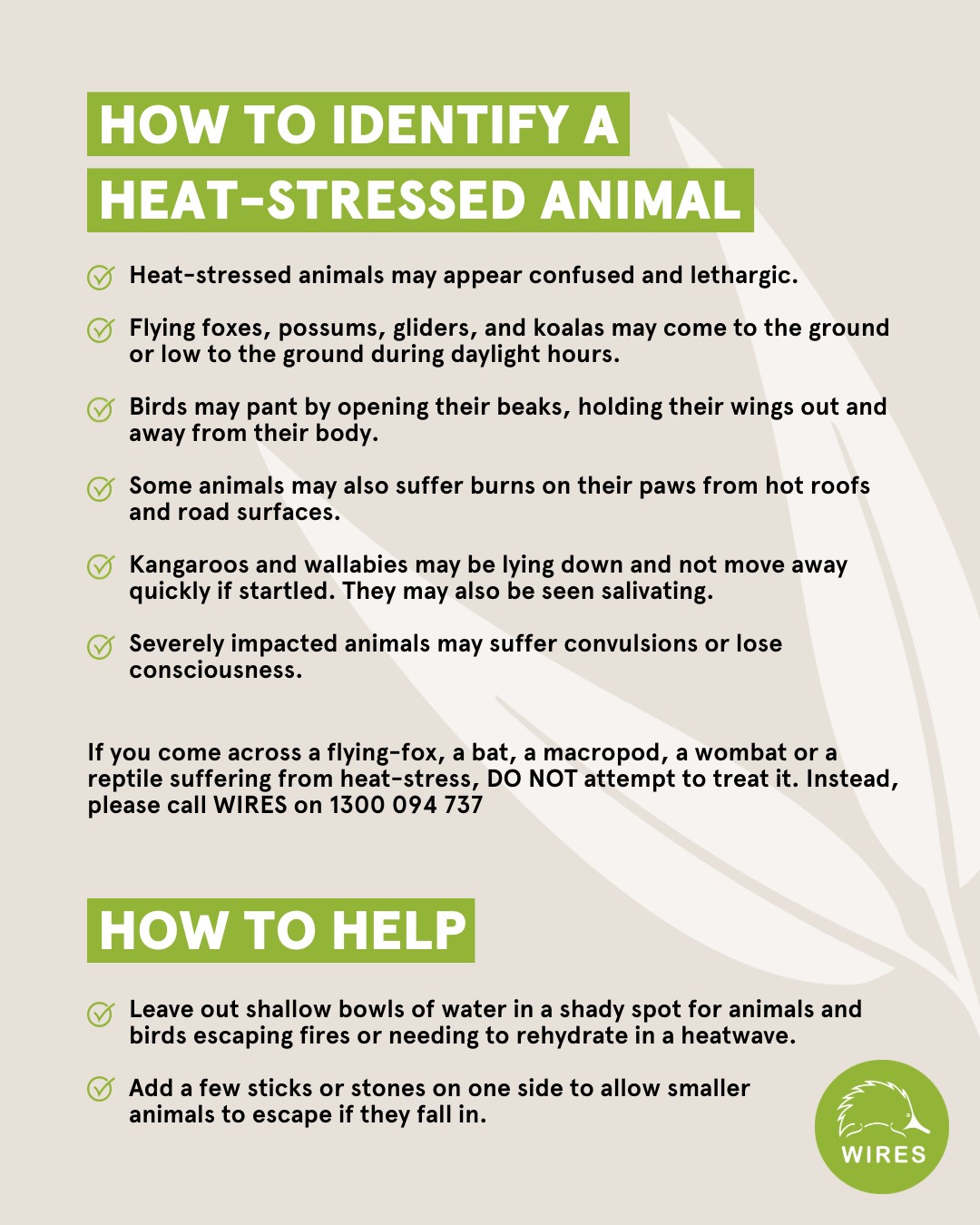
Palmgrove Park Avalon: New Bushcare Group
 Palmgrove Park Avalon is a remnant of the Spotted Gum forest that was once widespread on the lower slopes of the Pittwater peninsula. This bushland’s official name and forest type is Pittwater and Wagstaffe Endangered Ecological Community, endangered because so much has been cleared for suburban development. Canopy trees, smaller trees and shrubs, and ground layer plants make up this community. Though scattered remnant Spotted Gums remain on private land, there is little chance of seedlings surviving in gardens and lawns. More information HERE
Palmgrove Park Avalon is a remnant of the Spotted Gum forest that was once widespread on the lower slopes of the Pittwater peninsula. This bushland’s official name and forest type is Pittwater and Wagstaffe Endangered Ecological Community, endangered because so much has been cleared for suburban development. Canopy trees, smaller trees and shrubs, and ground layer plants make up this community. Though scattered remnant Spotted Gums remain on private land, there is little chance of seedlings surviving in gardens and lawns. More information HERE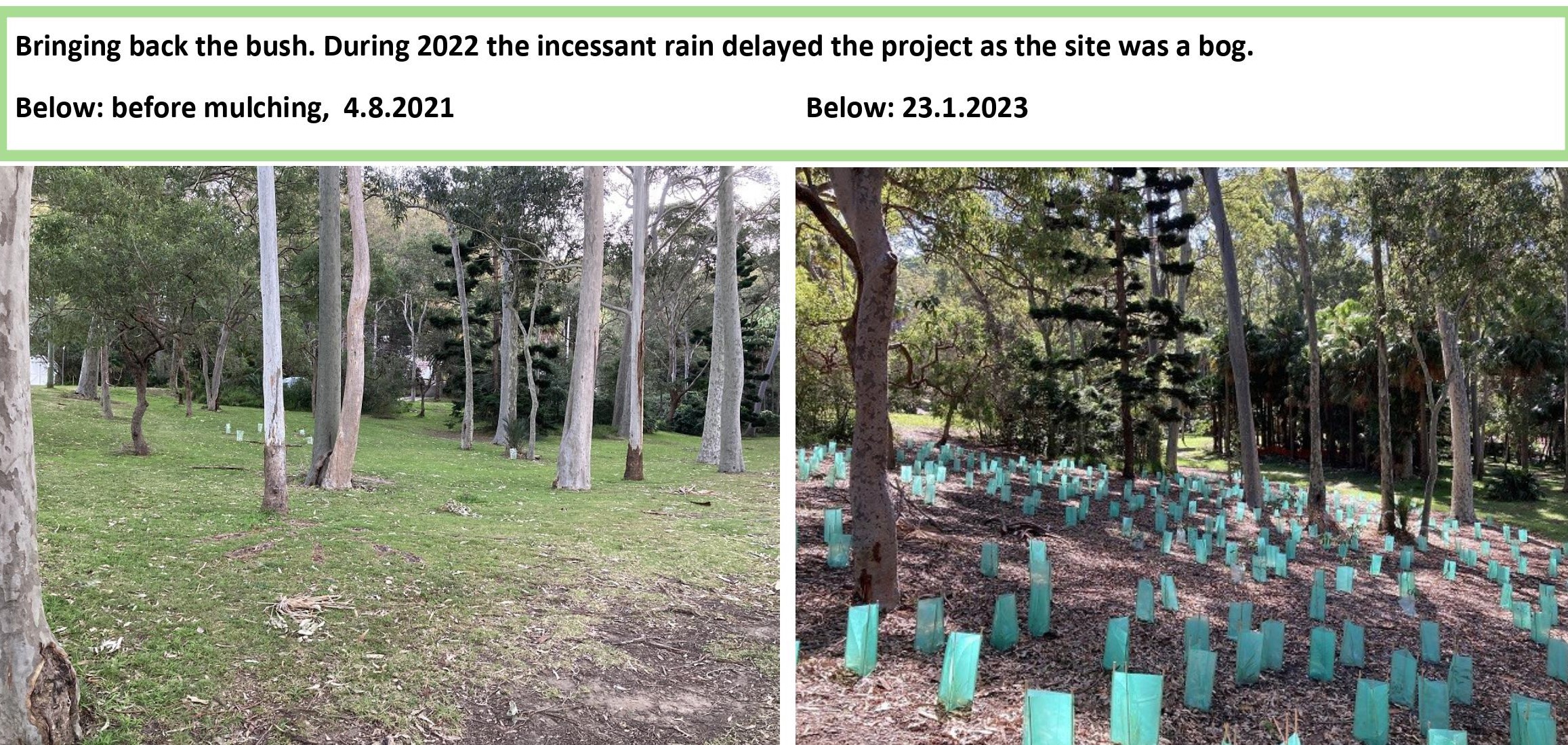
Report Fox Sightings
%20(1).jpg?timestamp=1675893929686)
Marine Wildlife Rescue Group On The Central Coast
A new wildlife group was launched on the Central Coast on Saturday, December 10, 2022.
Marine Wildlife Rescue Central Coast (MWRCC) had its official launch at The Entrance Boat Shed at 10am.
The group comprises current and former members of ASTR, ORRCA, Sea Shepherd, Greenpeace, WIRES and Wildlife ARC, as well as vets, academics, and people from all walks of life.
Well known marine wildlife advocate and activist Cathy Gilmore is spearheading the organisation.
“We believe that it is time the Central Coast looked after its own marine wildlife, and not be under the control or directed by groups that aren’t based locally,” Gilmore said.
“We have the local knowledge and are set up to respond and help injured animals more quickly.
“This also means that donations and money fundraised will go directly into helping our local marine creatures, and not get tied up elsewhere in the state.”
The organisation plans to have rehabilitation facilities and rescue kits placed in strategic locations around the region.
MWRCC will also be in touch with Indigenous groups to learn the traditional importance of the local marine environment and its inhabitants.
“We want to work with these groups and share knowledge between us,” Gilmore said.
“This is an opportunity to help save and protect our local marine wildlife, so if you have passion and commitment, then you are more than welcome to join us.”
Marine Wildlife Rescue Central Coast has a Facebook page where you may contact members. Visit: https://www.facebook.com/profile.php?id=100076317431064
- Ph: 0478 439 965
- Email: marinewildlifecc@gmail.com
- Instagram: marinewildliferescuecc

Watch Out - Shorebirds About
.JPG.opt1460x973o0,0s1460x973.jpg?timestamp=1663629195339)
Possums In Your Roof?: Do The Right Thing

Aviaries + Possum Release Sites Needed

Bushcare In Pittwater
Where we work Which day What time
Avalon
Angophora Reserve 3rd Sunday 8:30 - 11:30am
Avalon Dunes 1st Sunday 8:30 - 11:30am
Avalon Golf Course 2nd Wednesday 3 - 5:30pm
Careel Creek 4th Saturday 8:30 - 11:30am
Toongari Reserve 3rd Saturday 9 - 12noon (8 - 11am in summer)
Bangalley Headland 2nd Sunday 9 to 12noon
Bayview
Winnererremy Bay 4th Sunday 9 to 12noon
Bilgola
North Bilgola Beach 3rd Monday 9 - 12noon
Algona Reserve 1st Saturday 9 - 12noon
Plateau Park 1st Friday 8:30 - 11:30am
Church Point
Browns Bay Reserve 1st Tuesday 9 - 12noon
McCarrs Creek Reserve Contact Bushcare Officer To be confirmed
Clareville
Old Wharf Reserve 3rd Saturday 8 - 11am
Elanora
Kundibah Reserve 4th Sunday 8:30 - 11:30am
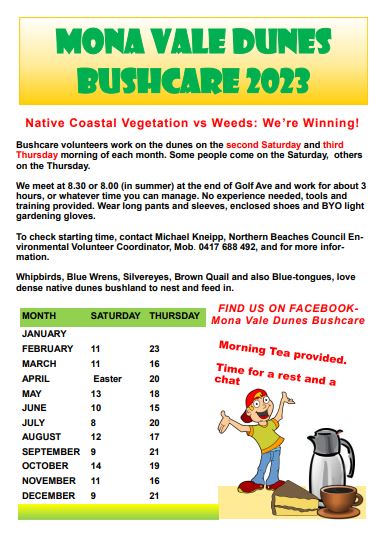 Mona Vale
Mona Vale Mona Vale Beach Basin 1st Saturday 8 - 11am
Mona Vale Dunes 2nd Saturday +3rd Thursday 8:30 - 11:30am
Newport
Bungan Beach 4th Sunday 9 - 12noon
Crescent Reserve 3rd Sunday 9 - 12noon
North Newport Beach 4th Saturday 8:30 - 11:30am
Porter Reserve 2nd Saturday 8 - 11am
North Narrabeen
Irrawong Reserve 2nd Saturday 2 - 5pm
Palm Beach
North Palm Beach Dunes 3rd Saturday 9 - 12noon
Scotland Island
Catherine Park 2nd Sunday 10 - 12:30pm
Elizabeth Park 1st Saturday 9 - 12noon
Pathilda Reserve 3rd Saturday 9 - 12noon
Warriewood
Warriewood Wetlands 1st Sunday 8:30 - 11:30am
Whale Beach
Norma Park 1st Friday 9 - 12noon
Western Foreshores
Coopers Point, Elvina Bay 2nd Sunday 10 - 1pm
Rocky Point, Elvina Bay 1st Monday 9 - 12noon
Friends Of Narrabeen Lagoon Catchment Activities

Gardens And Environment Groups And Organisations In Pittwater
- Ringtail Posse: 1 – February 2023; Anna Maria Monticelli: King Parrots/Water Dragons - Jacqui Scruby: Loggerhead Turtle - Lyn Millett OAM: Flying-Foxes - Kevin Murray: Our Backyard Frogs - Miranda Korzy: Brushtail Possums
- Ringtail Posse: 2 - March 2023; Kevin Murray: Tawny Frogmouth - Kayleigh Greig: Red-Bellied Black Snake - Bec Woods: Australian Water Dragon - Margaret Woods: Owlet-Nightjar - Hilary Green: Butcher Bird - Susan Sorensen: Wallaby
- Ringtail Posse 3 - April 2023: Jeffrey Quinn: Kookaburra, Tom Borg McGee: Kookaburra, Stephanie Galloway-Brown: Bandicoot, Joe Mills: Noisy Miner
- Ringtail Posse 4 May 2023 - Andrew Gregory: Powerful Owl, Marita Macrae: Pale-Lipped Or Gully Shadeskink, Jools Farrell: Whales & Seals, Nicole Romain: Yellow-Tailed Black Cockatoo
- Ringtail Posse 5: June 2023 - Lynleigh Greig OAM: Snakes, Dick Clarke: Diamond Python, Selena Griffith: Glossy Black-Cockatoo, Eric Gumley: Bandicoot
- Ringtail Posse 6: July 2023 - Sonja Elwood: Long-Nosed Bandicoot, Dr. Conny Harris: Swamp Wallaby, Neil Evers: Bandicoot, Bill Goddard: Bandicoot
- Ringtail Posse 7: August 2023 - Geoff Searl OAM: Tawny Frogmouth, Peter Macinnis: Echidna, Peter Carter: Ringtail Possum, Nathan Wellings; Kookaburra
- Ringtail Posse 8: September 2023 - Saving Sydney's Last Koalas; Logging Now Stopped In Future Koala Park By Minns Government - ''Is There Time To Save Sydney's Last Koalas Too?'' Asks: John Illingsworth, WIRES, Sydney Wildlife Rescue, Save Sydney Koalas, The Sydney Basin Koala Network, The Help Save The Wildlife & Bushlands In Campbelltown Group, Appin Koalas Animal Rescue Service, Patricia and Barry Durham, Sue Gay, Save Mt. Gilead, Paola Torti Of The International Koala Intervention Group
- Ringtail Posse 9: October 2023 - David Palmer OAM: Bandicoots, Helen Pearce: Brushtail Possum, Amina Kitching: Goanna, David Goudie: Ringtails Possums + Bandicoots + Owls
- Mother Brushtail Killed On Barrenjoey Road: Baby Cried All Night - Powerful Owl Struck At Same Time At Careel Bay During Owlet Fledgling Season: calls for mitigation measures - The List of what you can do for those who ask 'What You I Do' as requested
- Ringtail Posse 10: November 2023 - Stop Wildlife Roadkill Group: You Can Help By Using The Wildlife Incident Mapping Website
Harry Potter and the Disenchanted Wildlife: how light and sound shows can harm nocturnal animals
Jaana Dielenberg, Charles Darwin University; Euan Ritchie, Deakin University; Loren Fardell, The University of Queensland, and Therésa Jones, The University of MelbourneLight and sound shows in parks can enthral crowds with their colour, music and storytelling. Lasting for weeks to months, the shows provide entertainment and can boost local economies. But unless they are well-located, the shows can also harm wildlife.
A planned production at a wildlife sanctuary in outer Melbourne has brought these concerns to the fore. In April and May this year, a wildlife reserve on the Mornington Peninsula will host Harry Potter: A Forbidden Forest Experience. The event involves a two-kilometre night walk where, according to organisers, characters from the film are “brought to life”.
The event has prompted an outcry from people worried about the effect on the reserve’s vulnerable wildlife. The sanctuary, known as The Briars, is home to native animals including powerful and boobook owls, owlet-nightjars, koalas, wallabies, Krefft’s gliders, lizards, frogs, moths and spiders. A petition calling for the event to be relocated has attracted more than 21,000 signatures.
Research shows artificial light, sound and the presence of lots of people at night can harm wildlife. It’s not hard to see why. Imagine if a music and light show, and thousands of people, turned up at your house every night for weeks on end. How would you feel?
A History Of Community Opposition
In addition to the lights and sounds, these shows can involve artificial smoke and animated sculptures. While they often take place along existing walking trails, they attract huge crowds at a time when animals usually have the place to themselves.
Most of Australia’s mammals and frogs and many bird and reptile species are nocturnal, or active at night. They have adapted to the natural darkness, sounds and smells of the night.
The Harry Potter experience planned for The Briars has taken place elsewhere around the world, including at a nature area near the Belgian capital of Brussels. That event, in February last year, was also opposed by locals on ecological grounds. Belgian Minister for Nature Zuhal Demir has reportedly said the show would not return this year due to concern for wildlife.
Light shows proposed for other wildlife conservation areas have also faced community opposition. In Australia, there were calls to halt the Parrtjima light festival in the Alice Springs Desert Park over potential harm to the threatened black-footed rock wallabies. The Lumina light show proposed for Mount Coot-tha in Brisbane has also attracted concern for wildlife.
Light, Sounds, Action!
Research shows artificial light affects wildlife in many ways. For example, it can change their hormone levels, and the numbers and health of their offspring.
Light also interferes with the ability of many species to navigate. This can cause birds to become disorientated and crash. It can also prevent baby turtles from finding the sea.
Some animals will forgo feeding or drinking and attracting mates. Other animals will try to move to a darker location. In the Belgian case, locals claimed owls left the park to avoid the lights.
Studies of small mammals such as bats, micro-bats, possums and bandicoots have shown many will avoid using habitat that is artificially lit. When there is no alternative dark habitat, species forced to deal with bright conditions – whether natural or artificial – have been found to reduce their activity.
Conversely, some animals are attracted to light. Insects such as moths will cluster around the artificial light source, unable to leave. Some will become so exhausted they will become easy prey.
What’s more, human-caused noise also stresses animals and changes animal behaviour. It masks the natural soundscape, making it harder for animals to find mates or hear the calls of their young. It can also mean animals can’t hear predators or their prey.
When thousands of humans travel through an area they leave strong predator-like smells. This can be stressful for wildlife. It can also mask smells vital for an animal’s survival, such as that of food and predators.
Long-Term Harm
When faced with all this disruption, many nocturnal animals will hide until a site returns to normal, which in the case of light shows is often close to midnight. This cuts in half the time animals have to go about their life-sustaining activities and exposes them to greater risks when they do go out.
Light and sound shows are usually temporary – but can have major long-term impacts.
In species with low birth rates and short lifespans, a disturbance to breeding can be catastrophic. For example, males of the genus Antechinus (small marsupials) live long enough for just one short breeding season. If they are disrupted, there are no second chances.
The stress of human lights, sounds, smells and disturbance can shorten an animal’s life. Stress can make them more prone to illness and create problems with sleeping, reproduction, development and growth that can last for multiple generations.
Find A Better Location
The Mornington Peninsula Shire Council has defended the Harry Potter event, saying the placement of props, lights and sounds has been carefully considered.
Organisers may have minimised impacts where they can, but evidence suggests the impact on wildlife will still be extensive.
The sanctuary where the event will be held is billed as “an ark – a place which nurtures, protects and celebrates the unique flora and fauna of the peninsula, now rare but not lost”. Deliberately locating a light and sound show at the reserve seems at odds with this mission.
Events such as this clearly affect wildlife. Finding genuinely suitable locations should be done with care – and should avoid wildlife conservation areas altogether.![]()
Jaana Dielenberg, University Fellow, Charles Darwin University; Euan Ritchie, Professor in Wildlife Ecology and Conservation, School of Life & Environmental Sciences, Deakin University; Loren Fardell, Research Fellow, The University of Queensland, and Therésa Jones, Professor in Evolution and Behaviour, The University of Melbourne
This article is republished from The Conversation under a Creative Commons license. Read the original article.
Wholesale power prices are falling fast – but consumers will have to wait for relief. Here’s why
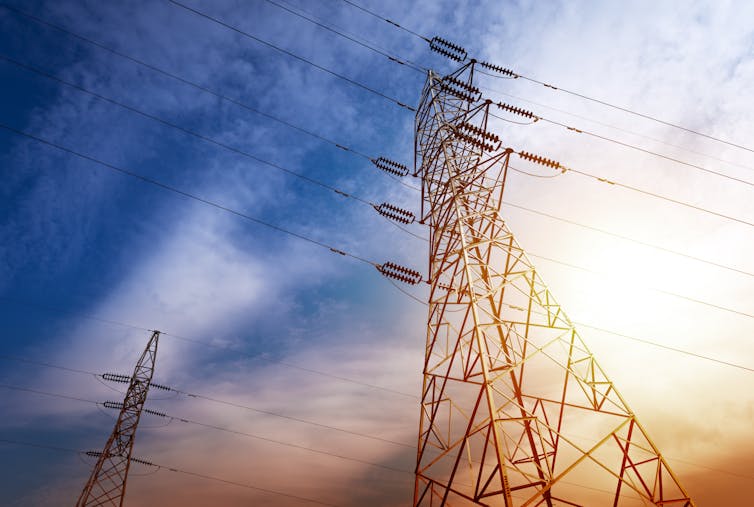
Wholesale power prices are falling steeply in Australia, following two years of surging prices after the Ukraine war triggered an energy crisis. New data shows annualised spot prices for power in Australia’s main grid fell by about 50% in 2023. That brings the cost of wholesale power down towards the levels seen in 2021.
Is that good news for consumers? It will be – but not yet. Energy retailers buy most of their power in advance at set prices, accepting higher average prices for less volatility. That means the cheaper spot prices won’t flow through to you for a while. But they will.
Here’s how the system works.
How Is Power Priced?
The way we price electricity will be different depending where you live in Australia.
If you live in Tasmania, Western Australia, regional Queensland or in the Northern Territory, there’s no competition. The state or territory government runs the power system, and prices are set by a regulator.
In South Australia, Victoria, New South Wales, and south-east Queensland, the competitive National Energy Market applies. Here, retailers buy power on the wholesale spot market from generators and compete for your business by offering different prices and bundling electricity with other services such as gas or broadband. (Some energy companies are both generators and retailers.)
While the federal government doesn’t set prices in the market, it does have some involvement. In 2019, it introduced a mandatory default market offer, effectively setting a maximum price a retailer can charge customers. Victoria also implemented its own default offer. These changes stemmed from concerns retail competition was overly complicated and not delivering benefits to all electricity consumers.
Default offers were intended as a fair price for power and to work as a safety net so consumers weren’t overcharged.
Retailers compete in part by offering deals set below the default price. Nearly all of us have now signed up for market offers, leaving fewer than 10% of consumers still on a default offer.
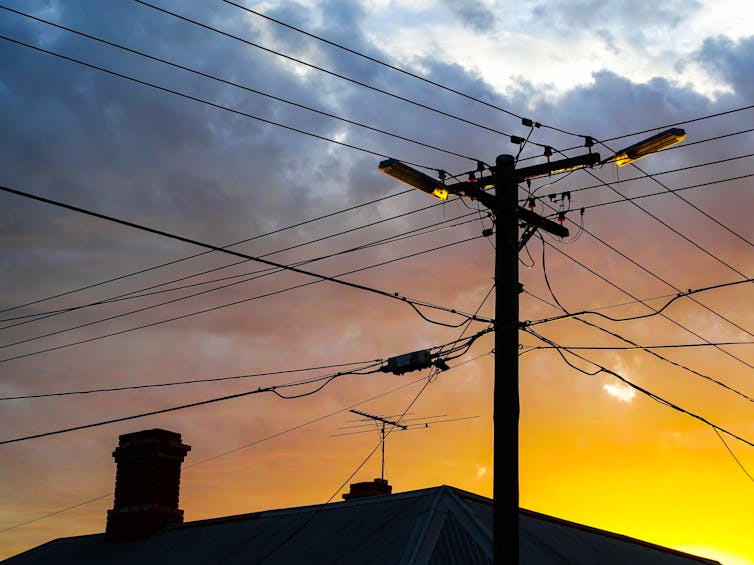
The price of electricity in default offers is set by energy regulators, usually on 1 July each year. Competing retailers tend to mirror changes to the default offers in their market offers. That means most, if not all, consumers should start seeing lower default prices reflected in their bills from this date onwards.
But don’t expect falling wholesale prices to be passed on immediately or in full. Buying electricity wholesale is only around 40% of a retailer’s total cost. Retailers also pass through the costs of transmission and distribution.
Ironing Out Fluctuations
In the National Energy Market, the spot price of power changes every five minutes – often drastically. Prices can be as low as negative A$1,000 per megawatt hour or as high as +$16,000 a megawatt hour if there are outages or intense demand during a heatwave. (Prices can turn negative if there’s an oversupply of power, such as when millions of rooftop solar arrays are putting energy into the grid in the middle of the day, and act as an incentive to boost demand or cut supply.)
You and I don’t want to be exposed to such price volatility. We rely on our retailers to do it, and they do so by taking out multi-year contracts to smooth out the price of power.
That means we are not exposed immediately to sudden increases in price, but it also means we do not benefit from rapid falls. Retail prices, including default offers, will respond to changes in wholesale prices when those changes are reflected in the retailers’ contract prices.
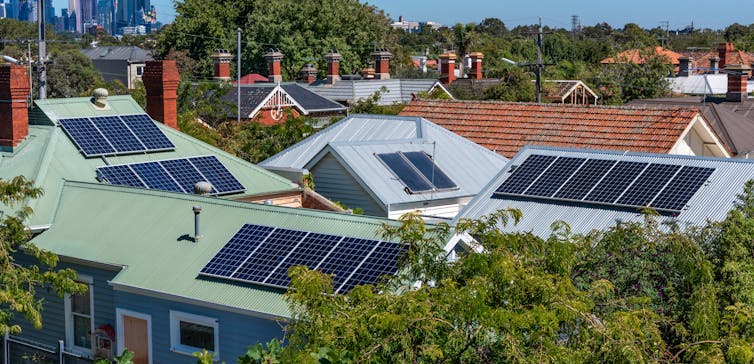
What About Politics?
Power prices are political. Everyone uses electricity and bill shock hurts.
At present, the Albanese government is under real pressure over the cost of living. Successive interest rate rises and more expensive petrol and groceries have left many of us feeling poorer.
Could there be direct intervention? Unlikely. Since the National Electricity Market was introduced in 1998, governments have avoided directly regulating prices.
When partial interventions are tried, they tend to have little impact. When the Coalition was in office federally, they introduced the so-called Big Stick laws, aimed at forcing energy retailers to pass on cost savings. To date, the laws have gathered dust.
What we can expect to see are calls to action. For instance, South Australia’s energy minister recently called on retailers to pass on price falls as quickly as possible.
This makes headlines and can put pressure on regulators such as the Australian Energy Regulator. We can expect the pressure of the election cycle to lead to even more calls for regulators to act.
But regulators should respond in line with their clear guidelines, rather than in response to political pressure. After all, governments have given regulators a difficult job to do: deliver fair prices in a rapidly evolving electricity market.
It would be better for the long-term interests of consumers and energy suppliers if they were allowed to get on with it.
What’s Next?
As more clean energy comes into the grid, it should push wholesale prices still lower. But the energy transition isn’t as simple as substituting solar and wind for coal. Big investments in transmission and energy storage are needed to connect more renewables and maintain a reliable system. Prices could once again rise sharply if our ageing coal plants give up the ghost before there’s enough renewable generation and storage to take up the slack.
These challenges and risks were inevitable given the scale of our net-zero transition. But the recent trend towards lower prices should give us confidence that more investment in renewables and storage can cover the closure of coal to deliver a reliable, low-emissions future – without threatening affordability. ![]()
Tony Wood, Program Director, Energy, Grattan Institute
This article is republished from The Conversation under a Creative Commons license. Read the original article.
First Nations people must be at the forefront of Australia’s renewable energy revolution
Adam Fish, UNSW Sydney and Heidi Norman, UNSW SydneyAustralia’s plentiful solar and wind resources and proximity to Asia means it can become a renewable energy superpower. But as the renewable energy rollout continues, Aboriginal and Torres Strait Islander people must benefit.
Renewables projects can provide income and jobs to Aboriginal land owners. Access to clean energy can also help First Nations people protect their culture and heritage, and remain on Country.
This is not a new idea. Policies in the United States and Canada, for example, actively seek to ensure the energy transition delivers opportunities to Indigenous people.
The Australian government is developing a First Nations Clean Energy Strategy and is seeking comment on a consultation paper. Submissions close tomorrow, February 9. If you feel strongly about the issue, we urge you to have your say.
We must get this policy right. Investing meaningfully in First Nations-led clean energy projects makes the transition more likely to succeed. What’s more, recognising the rights and interests of First Nations people is vital to ensuring injustices of the past are not repeated.
Good For Business, And People
Indigenous peoples have recognised land interests covering around 26% of Australia’s landmass. Research shows Aboriginal land holders want to be part of the energy transition. But they need support and resources.
This could take the form of federal grants to make communities more energy-efficient or less reliant on expensive, polluting diesel generators. Funding could also be spent on workforce training to ensure First Nations people have the skills to take part in the transition. Federal agencies could be funded to support grants for First Nations feasibility studies of renewable energy industry on their land.
As well as proper investment, governments must also ensure First Nations people are engaged early in the planning of renewable projects and that the practice of free prior and informed consent is followed. And renewable energy operators will also need to ensure they have capability to work with First peoples.
The First Nations Clean Energy Network – of which one author, Heidi Norman, is part – is a network of First Nations people, community organisations, land councils, unions, academics, industry groups and others. It is working to ensure First Nations communities share the benefits of the clean energy boom.
The network is among a group of organisations calling on the federal government to invest an additional A$100 billion into the Australian renewables industry. The investment should be designed to benefit all Australians, including First Nations people.
In Australia, the Albanese government has set an emissions-reduction goal of a 43% by 2030, based on 2005 levels. But Australia’s renewable energy rollout is not happening fast enough to meet this goal. Climate Change Minister Chris Bowen has called for faster planning decisions on renewable energy projects.
To achieve the targets, however, the federal government must bring communities along with them – including First Nations people.
As demonstrated by the US and Canada, investing meaningfully and at scale in First Nations-led clean energy projects is not just equitable, it makes good business sense.
Follow The Leaders
The US Inflation Reduction Act of 2022 made A$520 billion in investments to accelerate the transition to net zero. Native Americans stand to receive hundreds of billions of dollars from the laws. This includes funding set aside for Tribal-specific programs.
Canada is even further ahead in this policy space. In fact, analysis shows First Nations, Métis and Inuit entities are partners or beneficiaries of almost 20% of Canada’s electricity-generating infrastructure, almost all of which is producing renewable energy. In one of the most recent investments, the Canadian government in 2022 invested C$300 million to help First Nations, Inuit and Métis Peoples launch clean energy projects.
Policymakers in both countries increasingly realise that a just transition from fossil fuels requires addressing the priorities of First Nations communities. These investments are a starting point for building sustainable, globally competitive economies that work for everyone.
As the US and Canada examples demonstrate, the right scale of investment in First Nations-led projects can mean fewer legal delays and a much-needed social licence to operate.
Dealing With The Climate Risk
First Nations people around the world are on the frontline of climate change. It threatens their homelands, food sources, cultural resources and ways of life.
First Nations have also experienced chronic under-investment in their energy infrastructure by governments over generations, both in Australia and abroad.
Investing in First Nations-led clean energy projects builds climate resilience. This was demonstrated by the federal government’s Bushlight program, which ran from 2002 to 2013. It involved renewable energy systems installed in remote communities in the Northern Territory, Western Australia and Queensland.
Bushlight’s solar power meant that communities were not dependent on the delivery of diesel. So they still had power if roads were closed by flooding or other climate disasters.
Australia Must Get Moving
The Biden government’s Inflation Reduction Act prompted a swift reaction from governments around the world. But after 15 months, Australia is yet to respond or develop equivalent legislation.
We must urgently develop our response and seize this unique opportunity to become world leaders in the global renewables race. That includes ensuring First Nations participate in and benefit from these developments.
The First Nations Clean Energy Strategy consultation paper can be found here. Feedback can be provided here.![]()
Adam Fish, Associate Professor, School of Arts and Media, UNSW Sydney and Heidi Norman, Professor, Faculty of Arts, Design and Architecture, UNSW Sydney
This article is republished from The Conversation under a Creative Commons license. Read the original article.
El Niño is starting to lose strength after fueling a hot, stormy year, but it’s still powerful − an atmospheric scientist explains what’s ahead for 2024
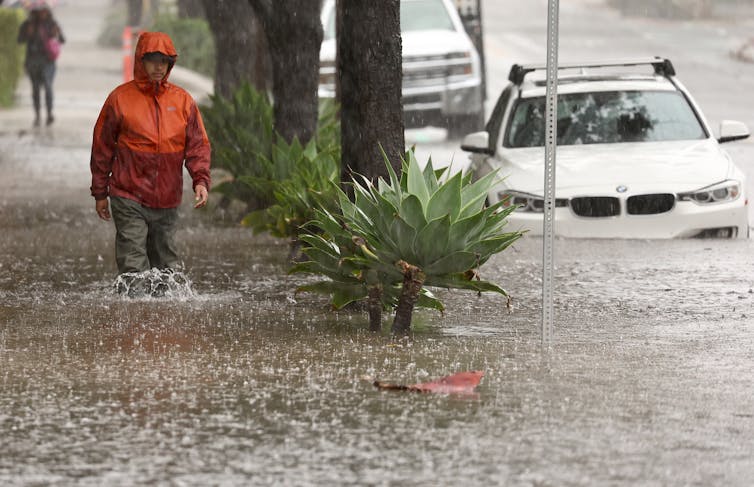
Wild weather has been roiling North America for the past few months, thanks in part to a strong El Niño that sent temperatures surging in 2023. The climate phenomenon fed atmospheric rivers drenching the West Coast and contributed to summer’s extreme heat in the South and Midwest and fall’s wet storms across the East.
That strong El Niño is now starting to weaken and will likely be gone by late spring 2024.
So, what does that mean for the months ahead – and for the 2024 hurricane season?
What Is El Niño?
Let’s start with a quick look at what an El Niño is.
El Niño and its opposite, La Niña, are climate patterns that influence weather around the world. El Niño tends to raise global temperatures, as we saw in 2023, while La Niña events tend to be slightly cooler. The two result in global temperatures fluctuating above and below the warming trend set by climate change.
El Niño starts as warm water builds up along the equator in the eastern tropical Pacific Ocean, off South America.

Typically, tropical Pacific winds blow from the east, exposing cold water along the equator and building up warm water in the western Pacific. Every three to seven years or so, however, these winds relax or turn to blow from the west. When that happens, warm water rushes to the east. The warmer-than-normal water drives more rainfall and alters winds around the world. This is El Niño.
The water stays warm for several months until, ultimately, it cools or is driven away from the equator by the return of the trade winds.
When the eastern Pacific region along the equator becomes abnormally cold, La Niña has emerged, and global weather patterns change again.
What To Expect From El Niño In 2024
While the 2023-24 El Niño event likely peaked in December, it is still strong.
For the rest of winter, forecasts suggest that strong El Niño conditions will likely continue to favor unusual warmth in Canada and the northern United States and occasional stormy conditions across the southern states.
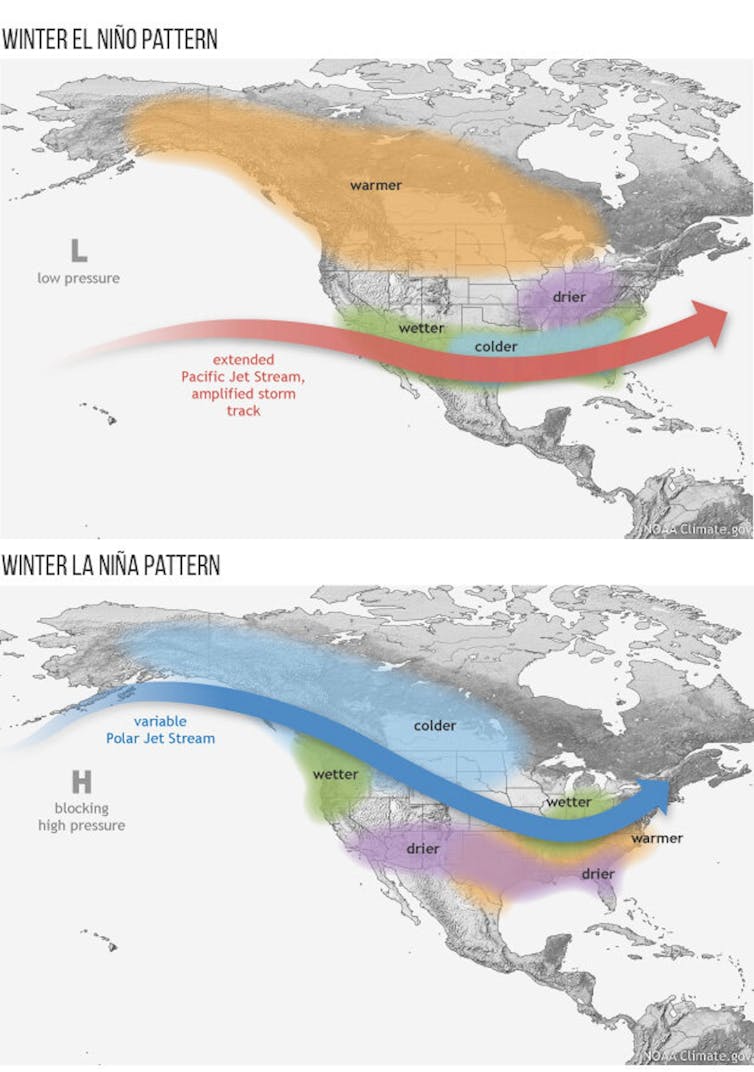
El Niño is likely to end in late spring or early summer, shifting briefly to neutral. There’s a good chance we will see La Niña conditions this fall. But forecasting when that happens and what comes next is harder.
How An El Niño Ends
While it’s easy to tell when an El Niño event reaches its peak, predicting when one will end depends on how the wind blows, and everyday weather affects the winds.
The warm area of surface water that defines El Niño typically becomes more shallow toward spring. In mid-May 1998, at the end of an even stronger El Niño event, there was a time when people fishing in the warm surface water in the eastern tropical Pacific could have touched the cold water layer a few feet below by just jumping in. At that point, it took only a moderate breeze to pull the cold water to the surface, ending the El Niño event.
But exactly when a strong El Niño event reverses varies. A big 1983 El Niño didn’t end until July. And the El Niño in 1987 retreated into the central Pacific but did not fully reverse until December.
As of early February 2024, strong westerly winds were driving warm water from west to east across the equatorial Pacific.
These winds tend to make El Niño last a little longer. However, they’re also likely to drive what little warm water remains along the equator out of the tropics, up and down the coasts of the Americas. The more warm water that is expelled, the greater the chances of full reversal to La Niña conditions in the fall.
Summer And The Hurricane Risk
Among the more important El Niño effects is its tendency to reduce Atlantic hurricane activity.
El Niño’s Pacific Ocean heat affects upper level winds that blow across the Gulf of Mexico and the tropical Atlantic Ocean. That increases wind shear - the change in wind speed and direction with height – which can tear hurricanes apart.
The 2024 hurricane season likely won’t have El Niño around to help weaken storms. But that doesn’t necessarily mean an active season.
During the 2023 Atlantic hurricane season, El Niño’s effect on the winds was more than offset by abnormally warm Atlantic waters, which fuel hurricanes. The season ended with more storms than average.
The Strange El Niño Of 2023-24
Although the 2023-24 El Niño event wasn’t the strongest in recent decades, many aspects of it have been unusual.
It followed three years of La Niña conditions, which is unusually long. It also emerged quickly, from March to May 2023. The combination led to weather extremes unseen since perhaps the 1870s.
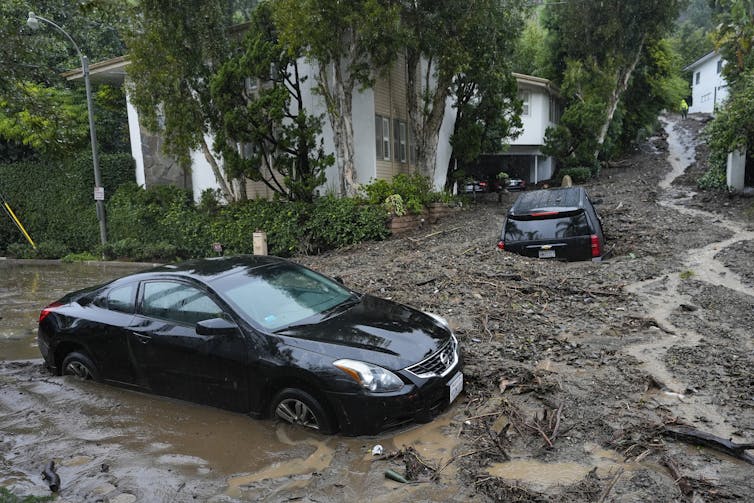
La Niña cools the tropics but stores warm water in the western Pacific. It also warms the middle latitude oceans by weakening the winds and allowing more sunshine through. After three years of La Niña, the rapid emergence of El Niño helped make the Earth’s surface warmer than in any recent year.![]()
Paul Roundy, Professor of Atmospheric and Environmental Sciences, University at Albany, State University of New York
This article is republished from The Conversation under a Creative Commons license. Read the original article.
In Chile, huge wildfires have killed at least 131 people – but one village was almost untouched
Yasna Palmeiro Silva, UCLChile has experienced one of the worst fire-related disasters in its history. A series of huge forest fires burned from February 1 to 5, leaving at least 131 people dead – and this number will probably increase as charred bodies are collected and severely injured people die.
But even this is only the tip of the iceberg. There are people with burns, post-traumatic stress and other mental health disorders. Existing diseases have been exacerbated by service interruptions, and people have lost their homes and livelihoods. Also, the long-term effects from smoke inhalation are yet to be seen.
This is not really a “climate disaster”, nor even a “natural disaster”. It is a disaster mainly caused by our decisions and lack of preparation to deal with a more extreme climate hazard. As an academic disaster researcher from Chile, I think there are lessons we can learn from these fires.
So, why did things become so deadly?
Fire-Prone Conditions
The weather, of course, played a role. Meteorological conditions have made Chile very prone to fires this summer, especially in this long-and-thin country’s central region, where it is warm enough for fires yet wet enough for there to be vegetation to burn.
Temperatures were high, above 35°C for more than three days before and during the fires in some places. Conditions were dry on top of a longer-term mega-drought, and relative humidity was low. It was also very windy.
It is very likely that these conditions have been influenced by El Niño, on top of human-induced climate change. However, even when fire danger is extremely high, fires can still be prevented from happening, expanding, or being deadly. But to achieve this, other factors are needed in this formula: social factors.
Formula For A (Not Natural) Perfect Disaster
My colleague Ilan Kelman has defined disasters as “where the ability of people to cope with a hazard or its impacts by using their own resources is exceeded”. This is exactly what happened in Chile: a deadly combination of an extreme climate hazard and inadequate social preparation.
In addition, regional authorities and the national government have suggested that some fires were ignited intentionally, as there were four simultaneous outbreaks and a state prosecutor claims that fire accelerants paraffin and benzine have been discovered. No arrests have been made.
The most devastating fires occurred in urbanising areas with significant land-use change, and where urban planning regulation has always been inadequate – leading to houses with no building regulation, and narrow streets with limited access to emergency services when needed.
There was also limited preparation for the expected hot season, either in the form of seasonal public campaigns for heatwaves and fires, or evacuation routes and plans.
Chile’s national early warning system, which sends a mass alert via text, audio and vibration to everyone who uses a compatible mobile device, also faced challenges. Several antennas were affected by the fires and not properly working, so many people did not receive the message on time. And those messages that were sent only said “evacuate”, so many people did not know where to go. This led to traffic jams and bottlenecks, some of which became engulfed in the middle of the fires.
Climate-Related Hazards Shouldn’t Turn Disastrous
Climate change means it is likely that Chile will be even more prone to huge fires in future. However, the human health risks this poses can be reduced by adequate preparedness and response plans.
Villa Botania, near the city of Quilpué in central Chile, emerged from these fires as an interesting example to learn from. This little village was surrounded by flames but was almost unaffected.
That’s because residents were prepared. A community-led project had managed waste and controlled vegetation and weeds, to ensure there was less flammable material when a fire passed by. Villa Botania demonstrated that a climate-related hazard does not always end in a massive human disaster, and lessons can be learned from this.
Chile recently created a national policy on disaster risk reduction, but it still needs to factor disaster risk and climate change into its planning regulations. This can save lives, as shown by the success since the 1970s of anti-seismic building regulations in this earthquake-prone country.
In a changing climate, we need to prepare the systems that prevent a disaster from occurring in the first place. This is sometimes forgotten, as most resources go to the response phase once it has occurred. However, Chile’s recent fires have again demonstrated that the twin threat of changing climate and inadequate social preparedness poses a serious danger to the health and wellbeing of many people.

Don’t have time to read about climate change as much as you’d like?
Get a weekly roundup in your inbox instead. Every Wednesday, The Conversation’s environment editor writes Imagine, a short email that goes a little deeper into just one climate issue. Join the 30,000+ readers who’ve subscribed so far.![]()
Yasna Palmeiro Silva, Research Fellow, Institute for Global Health, UCL
This article is republished from The Conversation under a Creative Commons license. Read the original article.
Heart attacks, cancer, dementia, premature deaths: 4 essential reads on the health effects driving EPA’s new fine particle air pollution standard

The U.S. Environmental Protection Agency has announced a new standard for protecting the public from fine particulate air pollution, known as PM2.5 because the particles are smaller than 2.5 millionths of a meter. These minute particles can penetrate deeply into the body and have been linked to many serious illnesses.
The new rule sets an annual limit of 9 micrograms per cubic meter of air, down from the previous level of 12 micrograms. States will be required to meet this standard and to take it into consideration when they evaluate applications for permits for new stationary air pollution sources, such as electric power plants, factories and oil refineries.
Under the Clean Air Act, the EPA is required to set air pollution standards at levels that protect public health. In the four articles that follow, scholars wrote about the many ways in which exposure to PM2.5 contributes to cardiovascular disease, lung cancer, other illnesses such as dementia, and premature deaths.
1. An Alarming Array Of Health Effects
Scientists have known since the 1993 Six Cities Study, which showed that people were dying faster in dirty cities than in clean cities, that exposure to PM2.5 increased the risk of lung cancer and heart disease. Subsequent research has linked fine particulates to a much broader range of health effects.
Once a person inhales PM2.5, “it causes an inflammatory response that sends signals throughout the body, much as a bacterial infection would,” wrote public and environmental health scholars Doug Brugge of the University of Connecticut and Kevin James Lane of Boston University. “Additionally, the smallest particles and fragments of larger particles can leave the lungs and travel through the blood.”
In Brugge and Lane’s view, evidence that PM2.5 could affect brain development, cognitive skills and children’s central nervous systems is particularly notable. They termed fine particle pollution an urgent global health threat.
“Developed countries have made progress in reducing particulate air pollution in recent decades, but much remains to be done to further reduce this hazard,” they observed. “And the situation has gotten dramatically worse in many developing countries – most notably China and India, which have industrialized faster and on vaster scales than ever seen before.”
2. Aging The Brain
Medical researchers are looking closely at air pollution as a possible accelerator of brain aging. University of Southern California preventive medicine specialist Jiu-Chiuan Chen and his colleagues have found that older women who lived in locations with high levels of PM2.5 suffered memory loss and Alzheimer’s-like brain shrinkage not seen in women living with cleaner air.
Chen and his colleagues compared brains scans taken at five-year intervals of older women who lived in areas with varying levels of air pollution.
“When we compared the brain scans of older women from locations with high levels of PM2.5 to those with low levels, we found dementia risk increased by 24% over the five years,” Chen wrote.
More alarmingly, “(T)hese Alzheimer’s-like brain changes were present in older women with no memory problems,” Chen noted. “The shrinkage in their brains was greater if they lived in locations with higher levels of outdoor PM2.5, even when those levels were within the current (2021) EPA standard.”
3. Disadvantaged Communities Have Dirtier Air
As researchers in environmental justice have shown, facilities such as factories and refineries often are concentrated in low-income neighborhoods and communities of color. This means that these areas are exposed to higher pollution levels and face heavier related health burdens.
Regulations put in place under the Clean Air Act have greatly reduced levels of harmful air pollutants across the U.S. over the past 50 years. But when University of Virginia economist Jonathan Colmer and public policy scholar Jay Shimshack analyzed data tracing PM2.5 concentrations at more than 8.6 million distinct U.S. locations from 1981 through 2016, they found that the areas that were most polluted in 1981 remained the dirtiest nearly 40 years later.
“In 1981 PM2.5 concentrations in the most polluted 10% of census tracts averaged 34 micrograms per cubic meter,” the authors reported. “In 2016 PM2.5 concentrations in the most polluted 10% of census tracts averaged 10 micrograms per cubic meter. PM2.5 concentrations in the least polluted 10% of census tracts averaged 4 micrograms per cubic meter.” In other words, while all areas had cleaner air, people in the most polluted areas still were exposed to PM2.5 levels more than twice as high as people in the cleanest zones.
“For decades, federal and state environmental guidelines have aimed to provide all Americans with the same degree of protection from environmental hazards,” Colmer and Shimshack note. “The EPA’s definition of environmental justice states that ‘no group of people should bear a disproportionate share of the negative environmental consequences.’ On this front, our research suggests that the United States is falling short.”
4. Fine Particle Pollution Hurts Wildlife Too
Like the proverbial canaries in coal mines, wild animals can show effects of exposure to pollution that offer broader warnings. One example is wildfires, which produce high levels of gases and particulate matter.
Cornell University conservation biologist Wendy M. Erb was studying wild orangutans in Indonesian Borneo when that island suffered large-scale wildfires. Orangutans are semi-solitary animals that communicate with each other through long, booming calls in the tropical forests where they live.
During the fires and for several weeks after the smoke cleared, Erb and her colleagues found that four male orangutans they were following called less frequently than usual – about three times daily instead of their usual six times. “Their voices dropped in pitch, showing more vocal harshness and irregularities,” Erb reported. “Collectively, these features of vocal quality have been linked to inflammation, stress and disease – including COVID-19 – in human and nonhuman animals.”
Erb hoped to see further study of how toxic smoke affects wildlife. “Using passive acoustic monitoring to study vocally active indicator species, like orangutans, could unlock critical insights into wildfire smoke’s effects on wildlife populations worldwide,” she observed.
Editor’s note: This story is a roundup of articles from The Conversation’s archive.![]()
Jennifer Weeks, Senior Environment + Cities Editor, The Conversation
This article is republished from The Conversation under a Creative Commons license. Read the original article.
Dangerous climate tipping points will affect Australia. The risks are real and cannot be ignored
Michael Grose, CSIRO and Andy Pitman, UNSW SydneyIn 2023, we saw a raft of news stories about climate tipping points, including the accelerating loss of Greenland and Antarctic ice sheets, the potential dieback of the Amazon rainforest and the likely weakening of the Atlantic Meridional Ocean Circulation.
The ice sheets, Amazon rainforest and the Atlantic ocean circulation are among nine recognised global climate tipping elements. Once a tipping point is crossed, changes are often irreversible for a very long time. In many cases, additional greenhouse gases will be released into the atmosphere, further warming our planet.
New scientific research and reviews suggest at least one of Earth’s “tipping points” could be closer than we hoped. A milestone review of global tipping points was launched at last year’s COP28.
What will these tipping points mean for Australia? We don’t yet have a good enough understanding to fully answer this question.
Our report, released overnight, includes conclusions in three categories: we need to do more research; tipping points must be part of climate projections, hazard and impact analyses; and adaptation plans must take the potential impacts into account.
What Are Climate Tipping Points?
Climate scientists have known for a while, through paleoclimate records and other evidence, that there are “tipping elements” in the climate system. These elements can undergo an abrupt change in state, which becomes self-perpetuating and irreversible for a very long time.
An example is the loss of Greenland ice. Once ice is lost, climate feedbacks lead to further loss, and major ice loss becomes “committed”. It becomes unlikely the ice sheet will reform for tens of thousands of years and only if the climate cools again.
Triggering climate tipping points would lead to changes in addition to those commonly included in climate projections. These changes include a significant rise in sea level at double the rate (or even more) of usual projections, as well as extra warming, altered weather systems, climate variability and extremes.
Triggering one tipping point may trigger other tipping points. If that happens, the cascading impacts would push many systems outside their adaptive capacity.
Cutting fossil greenhouse gas emissions is the most important thing we can do to limit warming and the risk of triggering tipping points. The faster we reduce emissions, the better our chances.
But as the planet continues to warm, we must consider the consequences of triggering some, or several, tipping points for Australia and the resulting risks for society. We need to have the right tools for adaptation planning to consider these risks.
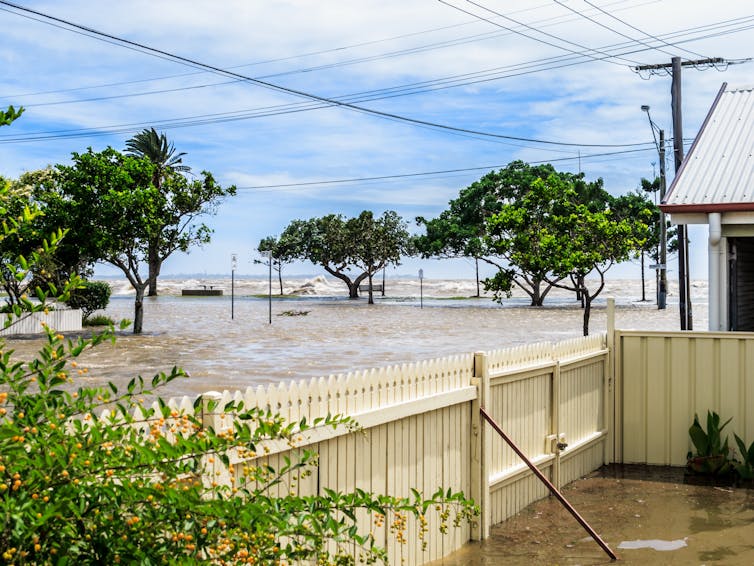
Grappling With Deep Uncertainties
There’s a major gap in the research literature around the implications of tipping points for the southern hemisphere and Australia. Researchers from Australian science agencies and universities came together last year to consider what global climate tipping points could mean for Australia.
We launched our report last night at the national conference of the Australian Meteorological & Oceanographic Society. We identified several priority areas for the research community, risk analysts and policymakers.
We considered the nine global climate tipping points – and one of the most relevant regional tipping points for Australia, coral reef die-offs – as defined in a recent scientific review.
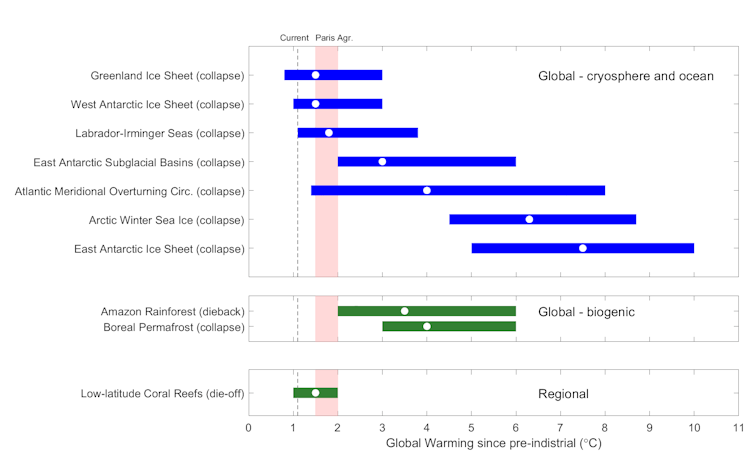
For almost all tipping points, we don’t understand all the relevant processes. There are deep uncertainties about what conditions would trigger tipping points, how they would play out and their likely impacts.
Along with recognising the most urgent point – that deep emission cuts will limit the chances of triggering tipping points – our conclusions cover three areas.
1. We need more research
We need to expand research on paleoclimate records, theory and process understanding, observations, monitoring and modelling. Australia leads world-class research, including on Antarctica, the Southern Ocean, the carbon cycle, weather processes and ecosystems. It is essential we support and expand the work, bringing a southern hemisphere perspective to global efforts.
2. Climate projections, hazard and impact analyses must include tipping points
Triggering some climate tipping points would have direct impacts on our coasts, ecosystems and society. In an interconnected world, other tipping points would have major indirect impacts – through climate migration, conflict, disrupted trade and more.
We need credible projections of what the climate looks like if tipping points are triggered. Our climate impact and risk analyses should illustrate what it really means for us. Given the limited state of knowledge, the “storyline” approach – linking past, current and future unfolding of events in a narrative or pathway framework – is particularly useful, informed by all the available evidence.
3. We need to consider what it means for adaptation
We can consider where, when and how we can act to reduce potential impacts if tipping points are triggered. Appropriate risk management accounts for likelihood, consequence and timeframe.
For example, planning for major coastal infrastructure with a long lifetime and low tolerance for failure could draw on the sea-level projections of “low likelihood, high impact” storylines that include the west Antarctic ice sheet collapsing. This would safeguard critical infrastructure against one worst-case risk. Of course, there is much more to adaptation than this.
We still have much to learn, but we cannot wait for perfect knowledge before we start planning. It’s clear the risks are real and cannot be ignored.
We need to focus on what we can do to avoid triggering tipping points, manage risk and build our climate resilience. There are also positive tipping points in technology, economy and society that are part of the solution. If we get it right, positive change can happen more rapidly than we might think.![]()
Michael Grose, Climate Projections Scientist, CSIRO and Andy Pitman, Director of the ARC Centre of Excellence for Climate Extremes, UNSW Sydney
This article is republished from The Conversation under a Creative Commons license. Read the original article.
‘A deeply troubling discovery’: Earth may have already passed the crucial 1.5°C warming limit
Malcolm McCulloch, The University of Western AustraliaGlobal temperatures have already exceeded 1.5°C warming and may pass 2°C later this decade, according to a world-first study I led. The worrying findings, based on temperature records contained in sea sponge skeletons, suggest global climate change has progressed much further than previously thought.
Human-caused greenhouse gas emissions drive global warming. Obtaining accurate information about the extent of the warming is vital, because it helps us understand if extreme weather events are more likely in the near future, and whether the world is making progress in reducing emissions.
To date, estimates of upper ocean warming have been mainly based on sea-surface temperature records, however these date back only about 180 years. We instead studied 300 years of records preserved in the skeletons of long-lived sea sponges from the Eastern Caribbean. In particular, we examined changes in the amount of a chemical known as “strontium” in their skeletons, which reflects variations in seawater temperatures over the organism’s life.
Keeping the average global temperature rise below 1.5°C since pre-industrial times is a goal of the 2015 Paris climate deal. Our research, published in Nature Climate Change, suggests that opportunity has passed. Earth may in fact have already reached at least 1.7°C warming since pre-industrial times – a deeply troubling discovery.
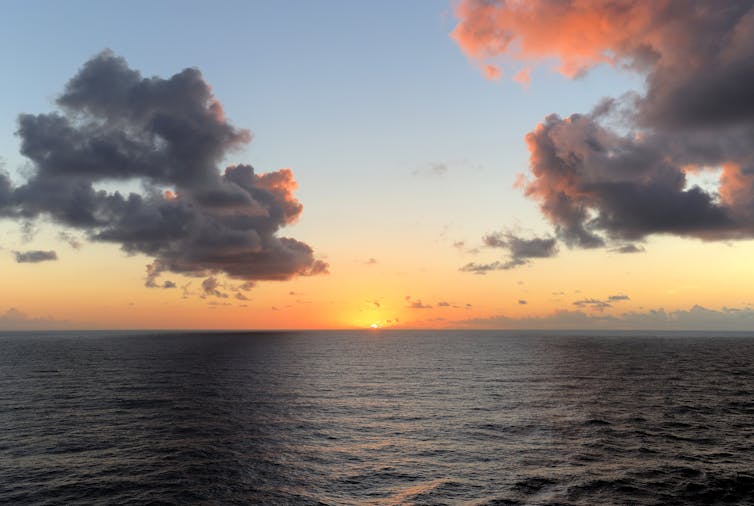
Getting A Gauge On Ocean Heat
Global warming is causing major changes to the Earth’s climate. This was evident recently during unprecedented heatwaves across southern Europe, China and large parts of North America.
Oceans cover more than 70% of Earth’s surface and absorb an enormous amount of heat and carbon dioxide. Global surface temperatures are traditionally calculated by averaging the temperature of water at the sea surface, and the air just above the land surface.
But historical temperature records for oceans are patchy. The earliest recordings of sea temperatures were gathered by inserting a thermometer into water samples collected by ships. Systematic records are available only from the 1850s – and only then with limited coverage. Because of this lack of earlier data, the Intergovernmental Panel on Climate Change has defined the pre-industrial period as from 1850 to 1900.
But humans have been pumping substantial levels of carbon dioxide into the atmosphere since at least the early 1800s. So the baseline period from which warming is measured should ideally be defined from the mid-1700s or earlier.
What’s more, a series of exceptionally large volcanic eruptions occurred in the early 1800s, causing massive global cooling. This makes it more difficult to accurately reconstruct stable baseline ocean temperatures.
But what if there was a way to precisely gauge ocean temperatures over centuries in the past? There is, and it’s called “sclerosponge thermometry”.
Studying A Special Sponge
Sclerosponges are a group of sea sponges that resemble hard corals, in that they produce a carbonate skeleton. But they grow at a much slower rate and can live for many hundreds of years.
The skeletons incorporate a number of chemical elements including strontium and calcium. The ratio of these two elements varies during warmer and cooler periods. This means sclerosponges can provide a detailed diary of sea temperatures, down to a resolution of just 0.1°C.
We studied the sponge species Ceratoporella nicholsoni. They occur in the Eastern Caribbean, where the natural variability of upper ocean temperatures is low which makes it easier to tease out the effects of climate change. We wanted to investigate temperatures in a part of the ocean known as the “ocean mixed layer”. This is the upper part of the ocean, where heat is exchanged between the atmosphere and the ocean interior.

We looked at temperatures going back 300 years, to see whether the current time period which defines pre-industrial temperatures was accurate. So what did we find?
The sponge records showed nearly constant temperatures from 1700 to 1790 and from 1840 to 1860 (with a gap in the middle due to volcanic cooling). We found a rise in ocean temperatures began from the mid-1860s, and was unambiguously evident by the mid-1870s. This suggests the pre-industrial period should be defined as the years 1700 to 1860.
The implications of these findings are profound.
What Does This Mean For Global Warming?
Using this new baseline, a very different picture of global warming emerges. It shows human-caused ocean warming began at least several decades earlier than previously assumed by the IPCC.
Long-term climate change is commonly measured against the average warming over the 30 years from 1961 to 1990, as well as warming in more recent decades.
Our findings suggest that in the interval between the end of our newly defined pre-industrial period and the 30-year average mentioned above, the temperatures of the ocean and land surface increased by 0.9°C. This is far more than the 0.4°C warming the IPCC has estimated, using the conventional timeframe for the pre-industrial period.
Add to that the average 0.8°C global warming from 1990 to recent years, and the Earth may have warmed on average by at least 1.7°C since pre-industrial times. This suggests we have passed the 1.5°C goal of the Paris Agreement.
It also suggests the overriding goal of the agreement, to keep average global warming below 2°C, is now very likely to be exceeded by the end of the 2020s – nearly two decades sooner than expected.
Our study has also produced another alarming finding. Since the late 20th century, land-air temperatures have been increasing at almost twice the rate of surface oceans and are now more than 2°C above pre-industrial levels. This is consistent with well-documented decline in Arctic permafrost and the increased frequency around the world of heatwaves, bushfires and drought.
We Must Act Now
Our revised estimates suggest climate change is at a more advanced stage than we thought. This is cause for great concern.
It appears that humanity has missed its chance to limit global warming to 1.5°C and has a very challenging task ahead to keep warming below 2°C. This underscores the urgent need to halve global emissions by 2030.![]()
Malcolm McCulloch, Professor, The University of Western Australia
This article is republished from The Conversation under a Creative Commons license. Read the original article.
Is it time for a Category 6 for super cyclones? No – warnings of floods or storm surges are more useful
Liz Ritchie-Tyo, Monash UniversityWhen a tropical cyclone forms, people who live in its path anxiously monitor news of its direction – and strength. If a Category 5 storm with wind speeds of 250 kilometres per hour is heading for you, you prepare differently than you would for a Category 1 with wind speeds of 65 km/h.
In a hotter world, cyclones are expected to become less common but more intense when they do form. That, according to new research, means it might be time to consider introducing a Category 6 to the hurricane scale used in the United States to better communicate the threat.
But do cyclone scales need a new category for more severe storms? Only one hurricane in the Western Hemisphere has yet gone past the 309 km/h winds the researchers nominate for a Category 6. And the whole idea of storm scales, including Australia’s own tropical cyclone scale, is that Category 5 storms are those likely to do catastrophic damage. It’s hard to see what a Category 6 could offer.
What is worth exploring is how we can better communicate what specific threats a given storm poses. Is it carrying more water than average, making flooding a bigger risk? Or are unusually intense winds likely to bring more water ashore in storm surges?
In December, Cyclone Jasper made landfall as a Category 2 storm in northern Queensland. Despite being at the lower end of severity, it dumped huge volumes of water and triggered devastating floods. Residents and farmers criticised the Bureau of Meteorology for not fully conveying the size of the threat. More specific warnings could help.
What Are Storm Scales For?
The world’s tropical cyclone warning centres classify cyclones using simple intensity scale systems based on maximum wind thresholds. Cyclones, hurricanes and typhoons are different names for the same tropical storms.
There are several different intensity scales in use. The Saffir-Simpson scale is used by the US National Hurricane Center for hurricanes forming in the central and eastern North Pacific and North Atlantic basins. Different scales are used in the Australian, North Indian, Southwest Indian, and western North Pacific basins. Importantly, every scale in use is open-ended, meaning their final category is based on winds greater than a certain threshold – but with no upper limit.
Tropical cyclones can pose many threat to us while at sea, as they approach and make landfall, and even afterwards.
These threats include the intense winds near the eye of the tropical cyclone, the ring of damaging winds which can extend hundreds of kilometres from the eye, wind-driven high seas, storm surge, heavy rainfall and associated flooding and mudslides.
We can’t say one of these is definitively more deadly or damaging than any other threat. Tropical Cyclone Oswald, a 2013 Category 1 storm, led to heavy rainfall and flooding through Queensland and New South Wales, while the 1992 Category 5 Hurricane Andrew caused catastrophic wind damage – but little rain or storm surge damage when it hit Florida.
So Do We Really Need A Category 6?
The researchers suggest a Category 6 on the Saffir-Simpson scale would be for storms with winds over 86 metres per second (309 km/h).
They suggest five tropical cyclones have now passed that threshold since 2013. Certainly, Hurricane Patricia (2015) would meet that threshold. But this is the only one which meets their criteria in the last 40 years, as it was well observed by US aircraft missions. The other four were not in the Western Hemisphere – they were typhoons affecting Asia. In these areas, meteorologists do not use aircraft reconnaissance to confirm wind speeds. Estimates of wind speeds can vary substantially. That means the wind speeds of these four cannot be verified.
To make their case, the researchers also use the maximum possible intensity a tropical cyclone could reach in a given environment. It’s useful to scientists because it can be directly calculated from climate projections and is often used to explore how tropical cyclone intensity might change in the future. But it has an important limitation – tropical cyclones rarely reach their maximum potential intensity.
In their original formulation of the Saffir-Simpson scale, Herb Saffir and Bob Simpson described a Category 5 hurricane making landfall as one which would cause catastrophic destruction of all infrastructure. The Australian Tropical Cyclone Scale has different thresholds but similar reasoning for a Category 5 storm.
Based on the understanding that winds at Category 5 and above lead to catastrophic outcomes, it’s hard to see how adding a Category 6 would help the public. If a Category 5 means “expect catastrophic consequences”, what would Category 6 mean?
How Can We Best Communicate Cyclone Threats?
Scientists came up with tropical cyclone intensity scales as a way to clearly communicate the nature and size of the damage likely to occur. They are not intended to be comprehensive, as they’re based on a single wind speed valid only for the area near the eye, where the most intense winds occur.
Fundamentally, these scales are meant to measure how well our buildings and infrastructure can survive the wind force and also protect us. If our building codes, evacuation plans, and other protective strategies ever improved to the point where Category 5 storms no longer lead to catastrophic loss, it might make sense to introduce a Category 6. But we’re not at that point. The catastrophic loss from a Category 5 or Category 6 would look the same: catastrophic.
What we should do is explore whether we can improve the scale in different ways. Can we keep their simple, effective messages while also capturing the different threats a weather system like this can pose? ![]()
Liz Ritchie-Tyo, Professor of Atmospheric Sciences, Monash University
This article is republished from The Conversation under a Creative Commons license. Read the original article.
Labor’s fuel-efficiency standards may settle the ute dispute – but there are still hazards on the road
John Quiggin, The University of QueenslandAustralia looks set to adopt fuel-efficiency standards after the Albanese government on Sunday revealed options for the long-awaited policy. The government says the reform would lead to more cars that are cheaper to run, eventually saving Australians about A$1,000 per vehicle each year.
The announcement comes a decade after the Climate Change Authority first proposed such a standard for Australia. The United States has had such a policy since the 1970s and the European Union implemented mandatory standards in 2009.
The Coalition has already sought to stoke fears among tradies and regional voters by claiming Labor’s policy threatens to take utes off the road. Labor’s policy is designed to address this concern – but the opposition looks likely to continue this scare campaign.
More generally, history tells us the road to fuel-efficiency reform in Australia is a bumpy one. The Albanese government has hazards to negotiate before its proposal becomes law.
A Carbon Price, By Another Name
Labor has outlined three options for a fuel-efficiency target, ranging from weak to aggressive. It describes its preferred middle-ground option as the sensible compromise.
The policy design for each of the options would set a national limit, averaged across all new cars sold, stipulating grams of CO₂ that can be emitted for each kilometre driven. This measure depends on fuel efficiency: that is, the amount of fuel burnt per kilometre. The designs differ in the stringency of the targets, the speed of the changes and the treatment of different vehicle classes.
The limit would not apply to individual cars. Instead, each supplier of new light vehicles to Australia would have to make sure the mix of vehicles does not exceed the limit. Low-efficiency vehicles could still be sold, but car dealers would have to balance this out by selling enough high-efficiency vehicles, such as electric vehicles.
Car suppliers that outperform the targets would earn credits that could be sold to those falling short. This system is similar to Australia’s renewable energy target for electricity and the safeguard mechanism for industry pollution.
All three are effectively a carbon price (though the political toxicity of that term means the government would never characterise them as such). Nonetheless, should the fuel-efficiency standards be implemented, Australia would end up with three carbon prices, one for each major energy use.
The government says the preferred option would lead to a saving of 369 million tonnes of CO₂ by 2050.
What About Utes?
One tricky path the policy must navigate is allowing for the supply of both small and large vehicles without further exacerbating the trend towards oversized vehicles on our roads.
The government’s preferred option achieves this by allowing higher – but still limited – emissions for heavier vehicles such as utes, vans and SUVs, to account for their natural tendency to use more fuel.
Heavier vehicles are a sticking point in forming vehicle emissions policy in Australia. Who could forget then-prime minister Scott Morrison’s 2019 claim Labor’s electric vehicle policy would “end the weekend” by banning larger cars used to tow boats and the like.
Following Labor’s policy announcement on Sunday, Nationals leader David Littleproud picked up where Morrison left off, saying:
If you take away particularly utes, they’re tools of trade, particularly for people, not just tradies in the cities, but also people in the bush. And if you put a tonne on the back of an electric ute at the moment, you don’t get far.
Anticipating the Coalition scare campaign, the Labor government’s preferred option has been designed with the aim of ensuring a wide range of conventional utes remain on the market.
In the medium term, we can also expect the trend towards larger vehicles to be weakened by measures in Labor’s last federal budget to roll back vehicle tax breaks for small and medium businesses. But that change doesn’t come into effect until mid-year, which means there may be a rush on larger vehicle purchases until then.

Ghosts From The Past
Labor’s preferred policy option is broadly similar to that put forward by the Climate Change Authority in 2014. Then, the Coalition government appeared to consider the proposal for a time. But it eventually dropped the idea – in part, presumably, due to lobbying by interest groups including the car industry.
There are signs those same groups are gearing up again. The Federated Chamber of Automotive Industries, for example, said on Sunday the government’s targets will “be a challenge” to meet and may lead to more expensive vehicles, or gaps in the supply of utes and SUVs.
But the proposed policy has been welcomed by climate change advocates, the electric vehicle industry and motoring groups. The NRMA described them as “responsible and achievable”, saying “a business-as-usual approach meant that Australian families and businesses were not benefiting from the best technology designed to reduce fuel consumption”.
Progress, At Last
The government intends to consult on its preferred model before introducing the legislation, with a view to enacting the policy in January 2025.
Assuming the policy is adopted, Australia would finally shed its unenviable status as the only developed country without such such standards. But we will still be at the back of pack, far behind the EU and only catching up to the US in 2028.
Despite the difficulties, it seems likely Australia will have fuel-efficiency standards in the near future. As with most measures to reduce emissions, the best time to introduce the policy was ten or more years ago. But the second-best time is now.![]()
John Quiggin, Professor, School of Economics, The University of Queensland
This article is republished from The Conversation under a Creative Commons license. Read the original article.
Climate change will strike Australia’s precious World Heritage sites – and Indigenous knowledge is a key defence

From Kakadu to Uluru and the Great Barrier Reef, to Sydney Opera House and the convict sites, Australia’s list of World Heritage places is incredibly diverse. Each site represents the culture, nature and history of this land, in its own way.
But climate change threatens these sites. Many heritage values are already being eroded. On-ground managers of these and other protected places need practical guidance on how to understand these impacts and respond effectively.
We developed a climate change “toolkit” for World Heritage properties with site managers and Traditional Owners. To our knowledge, it is the first time such guidance has been co-developed and tested with World Heritage property managers and Indigenous experts in this country.
Bringing climate science and Indigenous knowledge systems together promises to produce better results for heritage protection as the climate changes. And there is no time to waste. We must act fast to address these threats to Australia’s unique and special places of global significance, so their World Heritage values can be enjoyed for generations to come.
Mounting Climate Threats To Heritage
Our new research explored climate impacts at three very different sites:
- Kakadu National Park, Northern Territory
- Australian Convict Sites, scattered around the country
- Willandra Lakes Region, southwest New South Wales.
The vast tropical Kakadu National Park is one of four Australian properties listed for both outstanding cultural and natural values. Cave paintings, rock carvings and archaeological sites date back tens of thousands of years. Tidal flats, floodplains, lowlands and plateaus provide habitat for many rare or endemic plants and animals.
But Kakadu is vulnerable to rising sea levels, leading to coastal erosion and saltwater entering wetlands. The region is also experiencing more extreme temperatures and heatwaves, changing fire regimes, more intense cyclones, and increasingly intense extreme rainfall events.
The Convict Sites consist of 11 properties around Australia. Fremantle Prison lies 5,500km west of Arthur’s Vale Historic Area in the east. The Old Great North Road in the north is 1,500km from the Port Arthur Historic Site in the south.
Many convict sites are on coasts and islands where wave action and sea level rise are increasingly damaging structures, landscapes and cultural materials. Convict sites are also vulnerable to storms and bushfires because the buildings are so old.
The arid Willandra Lakes Region contains fossil remains of a series of lakes and sand formations, along with archaeological evidence of human occupation dating back 45,000–60,000 years.
Hot and dry conditions are causing erosion of topsoil, increasingly exposing Aboriginal cultural heritage.

Tapping Into Deep Knowledge
We worked closely with these sites to develop and test our new toolkit.
An Indigenous Reference Group of Traditional Owners from a number of World Heritage sites in Australia contributed their expert knowledge. This includes practical guidance such as how to engage with and enable Indigenous leadership so Traditional Owners can participate in or lead climate vulnerability assessment and adaptation planning. The toolkit also describes using the right knowledge for the right Country (showing respect for traditional knowledge) and establishing agreements to ensure Indigenous cultural and intellectual property rights are protected.
Effectively addressing climate impacts on World Heritage values requires the deep knowledge, values and worldviews of Indigenous Peoples and local communities. This includes practices such as cultural burning to reduce the risk of intense bushfire, or cultural knowledge of long-term changes in water cycles. Tapping into this deep understanding of connections between nature and culture can help support the management of spiritual, living landscapes.
Adapting To Climate Change
World Heritage site managers can take a broad range of practical actions to adapt to climate change.
These actions, such as firefighting or invasive species control, may not be new. They just need to be undertaken more often or intensely.
Other variations on existing actions may include greater emphasis on physical separation between flammable vegetation and assets such as larger firebreaks, or responding to new invasive species, possibly including shifting ranges of invasive native species.
Some new management actions will be required, such as flood protection, relocating assets and new technological interventions. In cases where climate change is likely to lead to changes in the values of a site, there may be a need to reevaluate management objectives and strategies (such as accommodating new groups of organisms or “ecological communities”, letting some populations decline, and managed retreat of shorelines).
There may also be a need to consider vulnerability at different scales, sometimes across larger areas. In some cases, managers may aim to retain certain values across a wider landscape while accepting local change.

Looking Ahead
Managers, stakeholders and rights-holders of World Heritage sites and other protected places, such as Ramsar wetlands and marine protected areas, can now use the toolkit to plan for current and future climate threats. They can focus on the parts most useful to them, depending on their capacity and needs. Ultimately, this resource will help protect Australia’s cultural and natural heritage.
The following people were members of the Indigenous Reference Group and are coauthors of our research paper: Bianca McNeair, Lance Syme, Chrissy Grant, Nicholas Pedrocchi, Patricia Oakley, Amy Stevens, Denis Rose, Erin Rose, Jade Gould, John Locke and Lynda Maybanks.![]()
Jess Melbourne-Thomas, Transdisciplinary Researcher & Knowledge Broker, CSIRO; Brenda Lin, Principal research scientist, CSIRO; Lance Syme, Secretariat at the International Indigenous Peoples Forum on World Heritage, Indigenous Knowledge, and Mandy Hopkins, Adjunct industry fellow, University of Southern Queensland
This article is republished from The Conversation under a Creative Commons license. Read the original article.
If plants can pick fungi to help fight pests and diseases, it opens a door to greener farming and ecosystem recovery
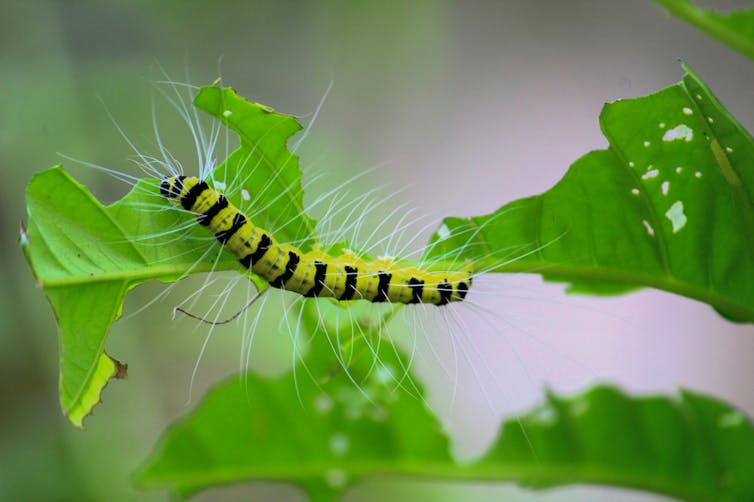
Just beneath your feet, an ancient and silent alliance endures. This alliance between plants and arbuscular mycorrhizal (AM) fungi is one of the oldest biological partnerships on Earth.
Going back almost half-a-billion years, this relationship paved the way for plants to make it onto land. These early plants, simple and without the complex root systems of plants today, forged an alliance with fungi. This alliance has been instrumental to the evolution of plant life and has helped shape our ecosystems.
These fungi grow into roots where the plants supply them with the carbon (as sugar and fat) they need to survive. The fungi extend thin root-like threads called mycelia into the soil to make expansive networks that can access nutrients beyond the reach of plant roots.
But these hidden microbes do more than just help plants get nutrients. Plants are constantly dealing with insect pests and diseases, and have done for a long time. To deal with this, they evolved sophisticated defences. AM fungi can dramatically enhance these defences.
So could plants be picking their fungal allies based on their ability to enhance defences against pests and diseases? We recently explored this question and proposed hypotheses around how this could happen. The answer could have huge implications for making agriculture more sustainable.
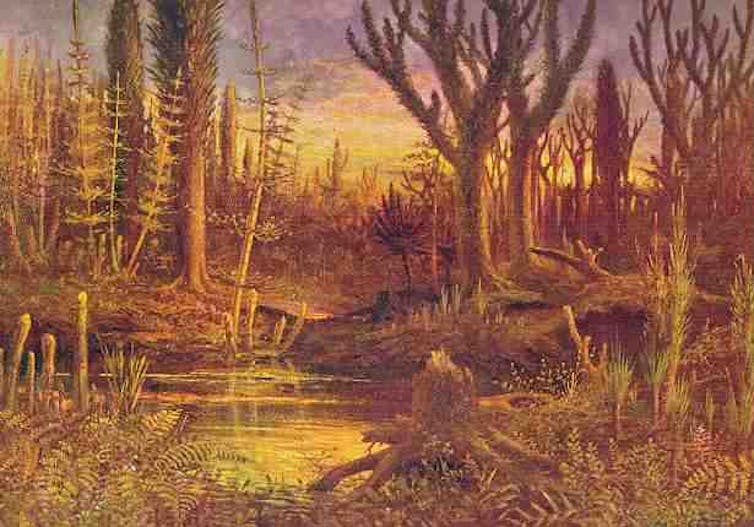
Harnessing The Ancient Alliance
Considering the benefits AM fungi can provide plants, it’s no surprise there has been a lot of interest in using them in environmental management. Studies show AM fungi can have huge benefits for ecosystem restoration by supporting the establishment of native plant communities. Their importance to ecosystem function makes it clear mycorrhizal fungi should be included in conservation efforts.
In agricultural systems, fungi can increase crop growth, nutrient uptake and yields. These benefits have been a major focus for researchers since the 1950s.
While there is ample evidence of the benefits AM fungi can provide for crops, results in the field are inconsistent. There can be a mismatch between the nutritional needs of the crops and the ability of the fungi that are present or introduced to the soil to meet those needs.
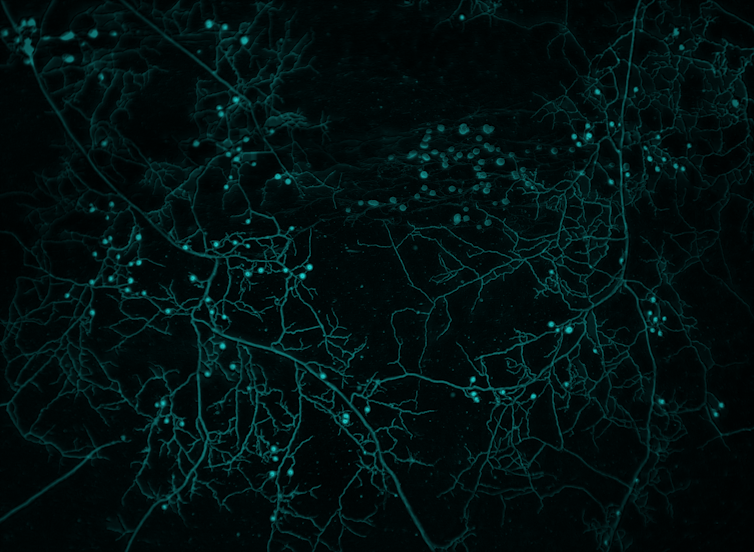
Do Plants Pick Their Fungal Partners For Defence?
Within the roots of a single plant, numerous fungal species can co-exist, forming complex communities. The species that make up these communities may each offer different capabilities – some are better at defence, while others are better at nutrient uptake. The benefit a plant gets from its fungal partners is, in part, determined by which species are present within its roots.
We can apply AM fungi to the soil but this doesn’t mean these fungi will actually partner up with the plant.
So what determines which fungi gain entry to the roots? Do plants have a say in this? And, if so, how do they choose? These questions have long been on the minds of ecologists and biologists.
At the core of this relationship is a complex exchange system. Plants provide the fungi with carbon they need, and the fungi provide benefits to the plants.
Research has shown a plant will play favourites (at least in some cases) with the fungi. They will partner up and give more carbon to the fungi that provide the most nutrients.
Yet there are significant challenges to exploiting these nutritional benefits in agriculture, where large inputs of nutrients are added to the soil. This can limit our ability to use the fungi in this way by removing plant reliance on the fungi for nutrients.
But can we exploit this partnership for plant defences? Globally, insect pests consume up to 20% of the major grain crops alone.
Given that we know plants can play favourites, could they select their fungi to boost defence? We have developed hypotheses to try to better understand this question, to set the stage for future research.
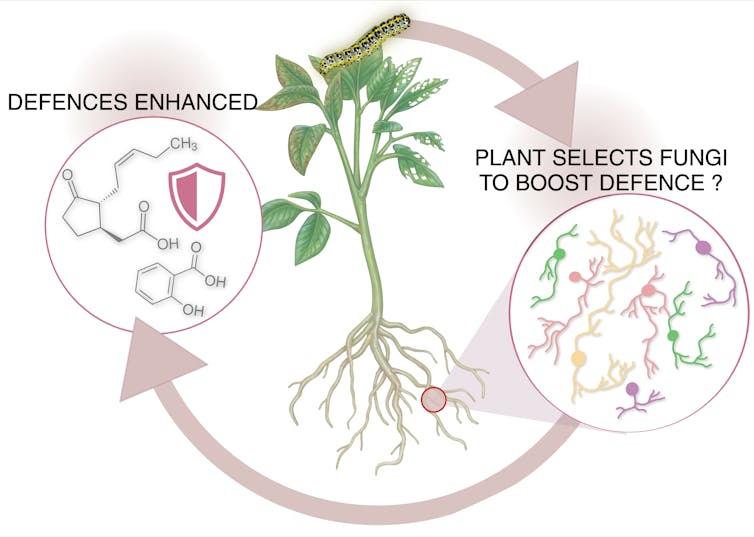
A Complex Question With Big Implications
There are many complications. When a plant is under attack by pests, this compromises its ability to supply carbon to its fungal allies, as its carbon resources are strained. It is still not known how these changes affect the plant’s “choice” of fungal partners.
We need a better understanding of how such choices happen and how herbivores can interfere with the ability of plants to reward those fungi providing the most benefit.
However, if plants can pick out the fungi that help them fight off pests and diseases, it could change the way we think about nature’s partnerships. It has big implications for farming, conservation and restoring damaged environments.
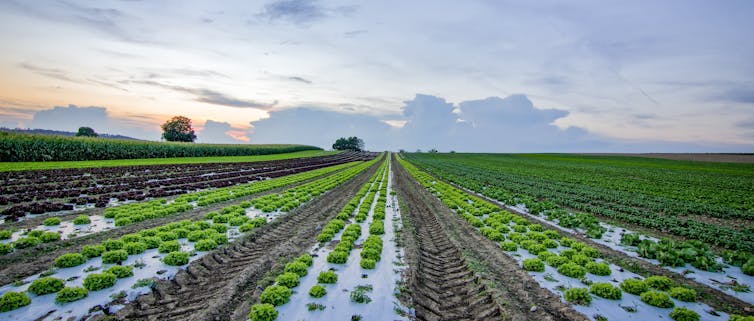
Knowing how plants select fungal allies would pave the way for better-defended crops, reducing the need to apply synthetic pesticides. It would open up exciting possibilities for helping ecosystems recover and thrive.
The possibility that plants can identify and select fungi based on the benefits they derive opens up exciting new frontiers in ecological research. As we explore these underground interactions, we inch closer to harnessing the potential of one of the Earth’s oldest symbioses. It is a reminder of the complex relationships that maintain life on the planet, connections that are as important today as they were 500 million years ago when the first plants reached for the sun above and the fungi below.![]()
Adam Frew, Lecturer and ARC DECRA Fellow, Hawkesbury Institute for the Environment, Western Sydney University; Carlos Aguilar-Trigueros, Research Fellow, Department of Biological and Environmental Science, University of Jyväskylä; Jeff Powell, Professor and ARC Future Fellow, Hawkesbury Institute for the Environment, Western Sydney University; Natascha Weinberger, Postdoctoral Research Fellow, Hawkesbury Institute for the Environment, Western Sydney University, and Stephanie Watts-Fawkes, Research Fellow, Waite Research Institute, University of Adelaide
This article is republished from The Conversation under a Creative Commons license. Read the original article.
We’re in a food price crisis. What is the government doing to ease the pressure?

An affordable daily diet has edged too far away for many Australians. Food prices have risen sharply since 2021, fuelling cost of living pressures and food insecurity. Some 3.7 million Australian households experienced food insecurity in 2023 – 10% more than in 2022.
Food prices have always been a challenge for many Australians. This is especially true for people on low incomes, refugees, people living in rural areas, single mothers, and people with disability. A basic healthy diet can cost city-dwelling families who are doing it toughest roughly one-third of their income.
So what is the Australian government doing to ease the cost of a supermarket shop? Let’s take a look.
First, How Much Have Food Prices Increased, And Why?
Food prices peaked in December 2022, with an average shopping basket costing 9.2% more than in 2021. Although food prices have eased since that peak, they remain significantly higher now compared to before the pandemic.
Almost all food categories have been hit, but many healthy foods appear to have increased in price at almost double the rate of discretionary (unhealthy) foods.

The COVID pandemic, climate events such as floods and bushfires, and international conflicts have all contributed, to varying degrees. These events have placed undue pressure on food supply chains through food shortages, increased fuel, energy and transport costs and a shortage of workers from farm to fork.
Big supermarkets have also been scrutinised recently. In Australia, supermarkets can set prices, with little transparency. This is against a backdrop of one of the most powerful and concentrated grocery sectors in the world, severely limiting competition.
Claims of supermarket price gouging have inspired public outrage, particularly given the two supermarket giants each pocketed more than A$1 billion in profits in 2022-2023.
So What Is The Government Doing To Ease The Pressure?
The government’s Standing Committee on Agriculture undertook an inquiry into food security in Australia in 2023, and came up with 35 recommendations. While many of these recommendations may indirectly influence food prices, only one explicitly addressed food prices: to provide subsidies for remote community stores so fresh food can be sold at an affordable price. These recommendations are yet to be implemented.
At the end of 2023, the Senate Select Committee on Supermarket Prices was established to “inquire into and report on the price setting practices and market power of major supermarkets”. Submissions to the inquiry recently closed, with the final report due in May.
In early 2024, the government announced an independent review of the Food and Grocery Code of Conduct to ensure the grocery retailers and wholesalers are dealing fairly with suppliers. Although not specifically focused on the shelf price of food, a fairer deal between retailers and suppliers may flow to lower prices for consumers.

Most recently, the Albanese government formally issued a directive to the Australian Competition and Consumer Commission (ACCC) to carry out a 12-month investigation into supermarket prices. This will have more teeth than other inquiries, allowing the ACCC to use legal powers to gather information, including from the supermarkets themselves.
If wrongdoing is uncovered, the ACCC has the power to take the supermarkets to court. The pressure from the inquiry may also lead to supermarkets voluntarily lowering food prices, in a similar way to previous inquiries.
What Are Other Countries Doing?
In Greece, the government has temporarily forced supermarkets to reduce prices on basic products. For example, the price of at least one type of bread would be lowered and advertised to shoppers at this lower rate. The Greek government has also provided low-income households with a monthly allowance to support grocery costs, among other measures.
The French government has worked with the food sector to secure a commitment from 75 companies to cut their prices. It has also promised regular price checks at supermarkets to ensure prices fall, with financial penalties if they don’t.
In Spain, the value added tax on basic foods, such as fruits, vegetables, pasta and cooking oils, has been eliminated or lowered. Government tax revenue will be reduced for these items, but retained for other non-basic foods (similar to the GST in Australia).
What Next For Australia?
The multi-year food price crisis has revealed the vulnerability of our food system. We need to recover from where we are, but we must do so in a way that ensures a more resilient food system with stable food prices over time.
While it’s too early to know what will come of the various food price inquiries, the government is and should continue to provide general cost-of-living support. The recent revised Stage 3 tax cuts are an example of increasing the flow of money to those who need it most, easing pressure at the supermarket checkout.
Further support for vulnerable households could be implemented by expanding existing social safety nets through increasing income support payments.
The fate of food prices in Australia is, at least for now, uncertain. But one thing is for sure. Unless the government steps up to ease the pressure, too many Australians will keep struggling to put food on the table.![]()
Kathryn Backholer, Co-Director, Global Centre for Preventive Health and Nutrition, Deakin University and Christina Zorbas, Research Fellow, Deakin University
This article is republished from The Conversation under a Creative Commons license. Read the original article.
Animals keep eating precious plants – we used ‘smell misinformation’ to keep them away

In places where we need to protect valuable plants – whether for ecological or economic reasons – local herbivores can cause significant damage.
Current solutions often involve killing the problem animals. But this is increasingly unacceptable due to animal welfare concerns and social pressures. Physical barriers such as fences can be expensive, and aren’t always practical. We need other options.
Recently, our team discovered that herbivores – plant-eating mammals – primarily use their sense of smell to tell which plants they want to eat or avoid.
In our study published today in Nature Ecology & Evolution, we show how we can use this reliance on smell to nudge wallabies away from vulnerable native tree seedlings. We artificially created and deployed the key smells of a shrub wallabies avoid.
Herbivore-Induced Headaches
Hungry plant eaters are a concern for conservationists, farmers and foresters alike. They can devastate revegetation efforts and post-fire recovery, destroying more than half the seedlings in these areas.
Every year, they cause billions of dollars of damage in forestry and agriculture. Herbivores also pose a risk to the long-term survival of many threatened plant species.
The most effective control strategies will likely work with a herbivore’s natural motivations – understanding and harnessing what drives the animal to find or avoid certain plants.
Previously, research had primarily focused on what herbivores were eating, but had never really asked how they find the food in the first place.
Our approach puts a new twist on “olfactory (smell) misinformation” or “chemical camouflage” approaches. In recent studies, these methods have substantially reduced invasive predators eating threatened bird eggs in New Zealand, and house mice eating agricultural wheat grain in Australia.

A Landscape Of Smells
In navigating a scent landscape, herbivores use odour to recognise and select among plants and plant patches. Odour is key in guiding the foraging of marsupials in Australia, elephants in Africa and Asia, and deer in the United States.
With this in mind, we explored whether the smell of a plant they don’t like could be enough to nudge animals away from highly palatable native tree seedlings.
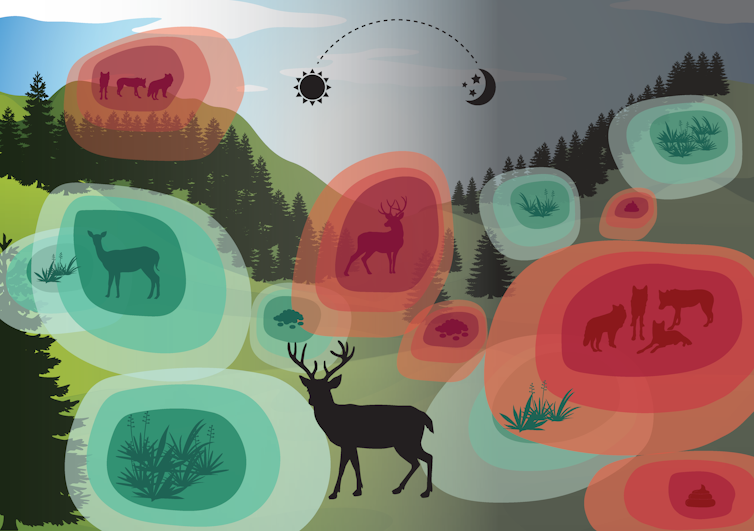
To test this idea, we focused on swamp wallabies foraging in a eucalypt woodland in eastern Australia. Studies have shown having too many swamp wallabies around can limit the number of eucalypt seedlings that survive to become trees. Swamp wallabies also have a fantastic sense of smell – they can find just a few eucalypt leaves buried underground among complex vegetation.
Using an approach we recently developed, we found the key scent compounds of a plant we know wallabies avoid – the native shrub Boronia pinnata.
We then mixed these compounds together to create “informative virtual neighbours”. They were “informative” as our mix of compounds mimicked what a wallaby would recognise as Boronia pinnata, “virtual” as we were not actually deploying the real shrub, and “neighbours” as we placed these smells in the bush next to eucalypt seedlings we were trying to protect.
In our study, a virtual neighbour was a small glass vial with a few millilitres of the mixture, with a tube pierced through the lid so the smell could waft out.
Using odours instead of real plants is a type of olfactory misinformation – it sends a deceptive message to the animals.
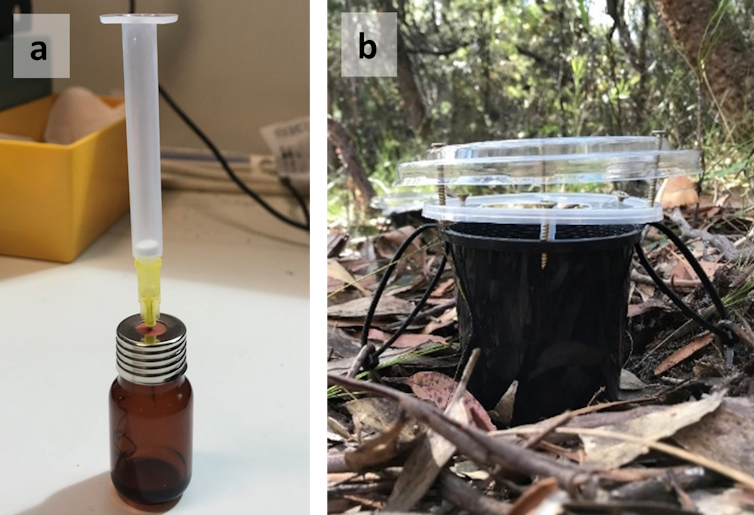
Real And Virtual Neighbours
We also compared if virtual neighbours were as good as the real thing in protecting eucalypt seedlings from being eaten by wallabies.
Five virtual neighbour vials or real Boronia pinnata plants were spaced evenly around single eucalypt seedlings the wallabies would find highly palatable. (We also had two types of controls: a seedling with nothing around it, and a seedling surrounded by five empty vials.)
Using remote cameras for 40 days, we recorded how long it took wallabies to find and munch on the eucalypt seedlings.
The results were staggering. Seedlings were 20 times less likely to be eaten when surrounded by virtual neighbours than for both controls. This was equivalent to using real B. pinnata plants, but better because vials don’t compete with seedlings for water and other resources.
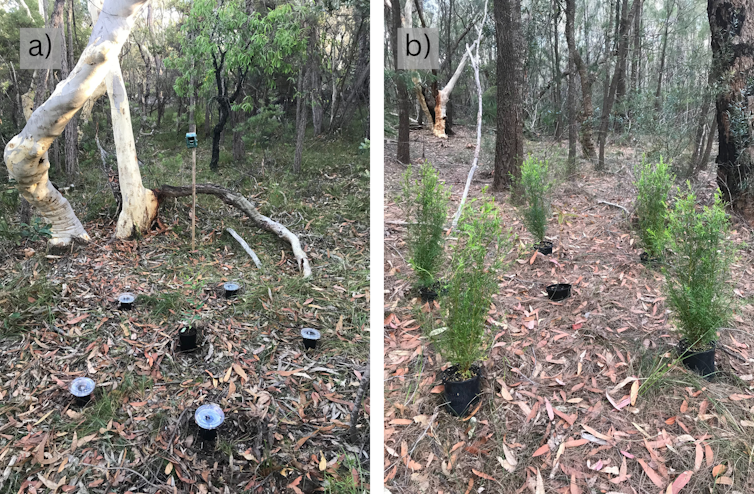
A Highly Effective Approach
The success of our study indicates we could use this approach as a new management tool – one that works by influencing the animals’ behaviour rather than trying to get rid of them.
We believe the concept behind developing virtual neighbours is directly transferable to any herbivore, mammal or otherwise, that uses plant odour to forage.
All herbivores avoid some plant species. With future development, we can deploy smelly virtual neighbours as a non-deadly and cost-effective tool to reduce the problems caused by overzealous herbivores.
We acknowledge all other co-authors who contributed to this work: Catherine Price, Malcolm Possell and Cristian Gabriel Orlando from the University of Sydney, and Adrian Shrader from the University of Pretoria. We thank Paul Finnerty for assistance in designing and constructing virtual neighbour holders.![]()
Patrick Finnerty, PhD candidate - Behavioural Ecology and Conservation Research, University of Sydney; Clare McArthur, Professor of Behavioural Ecology, University of Sydney, and Peter Banks, Professor of Conservation Biology, School of Life and Environmental Sciences, University of Sydney
This article is republished from The Conversation under a Creative Commons license. Read the original article.
A 380-million-year old predatory fish from Central Australia is finally named after decades of digging
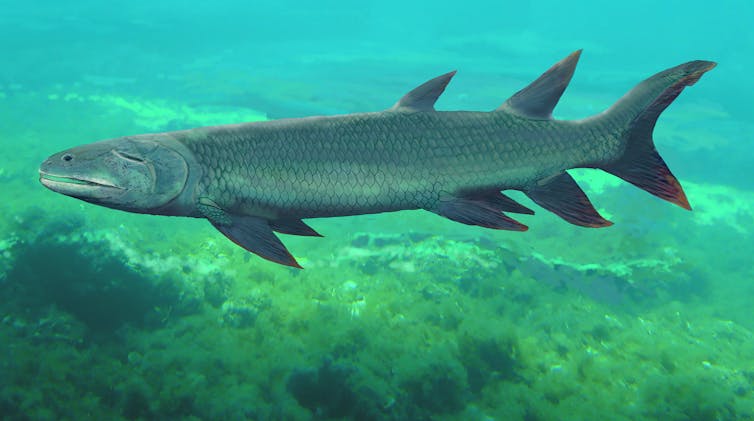
More than 380 million years ago, a sleek, air-breathing predatory fish patrolled the rivers of central Australia. Today, the sediments of those rivers are outcrops of red sandstone in the remote outback.
Our new paper, published in the Journal of Vertebrate Paleontology, describes the fossils of this fish, which we have named Harajicadectes zhumini.
Known from at least 17 fossil specimens, Harajicadectes is the first reasonably complete bony fish found from Devonian rocks in central Australia. It has also proven to be a most unusual animal.
Meet The Biter
The name means “Min Zhu’s Harajica-biter”, after the location where its fossils were found, its presumed predatory habits, and in honour of eminent Chinese palaeontologist Min Zhu, who has made many contributions to early vertebrate research.
Harajicadectes was a fish in the Tetrapodomorpha group. This group had strongly built paired fins and usually only a single pair of external nostrils.
Tetrapodomorph fish from the Devonian period (359–419 million years ago) have long been of great interest to science. They include the forerunners of modern tetrapods – animals with backbones and limbs such as amphibians, reptiles, birds and mammals.
For example, recent fossil discoveries show fingers and toes arose in this group.
Devonian fossil sites in northwestern and eastern Australia have produced many spectacular discoveries of early tetrapodomorphs.
But until our discovery, the poorly sampled interior of the continent had only offered tantalising fossil fragments.
A Long Road To Discovery
Our species description is the culmination of 50 years of tireless exploration and research.
Palaeontologist Gavin Young from the Australian National University made the initial discoveries in 1973 while exploring the Middle-Late Devonian Harajica Sandstone on Luritja/Arrernte country, more than 150 kilometres west of Alice Springs (Mparntwe).
Packed within red sandstone blocks on a remote hilltop were hundreds of fossil fishes. The vast majority of them were small Bothriolepis – a type of widespread prehistoric fish known as a placoderm, covered in box-like armour.
Scattered among them were fragments of other fishes. These included a lungfish known as Harajicadipterus youngi, named in honour of Gavin Young and his years of work on material from Harajica.
There were also spines from acanthodians (small, vaguely shark-like fish), the plates of phyllolepids (extremely flat placoderms) and, most intriguingly, jaw fragments of a previously unknown tetrapodomorph.

Many more partial specimens of this Harajica tetrapodomorph were collected in 1991, including some by the late palaeontologist Alex Ritchie.
There were early attempts at figuring out the species, but this proved troublesome. Then, our Flinders University expedition to the site in 2016 yielded the first almost complete fossil of this animal.
This beautiful specimen demonstrated that all the isolated bits and pieces collected over the years belonged to a single new type of fish. It is now in the collections of the Museum and Art Gallery of the Northern Territory, serving as the type specimen of Harajicadectes.
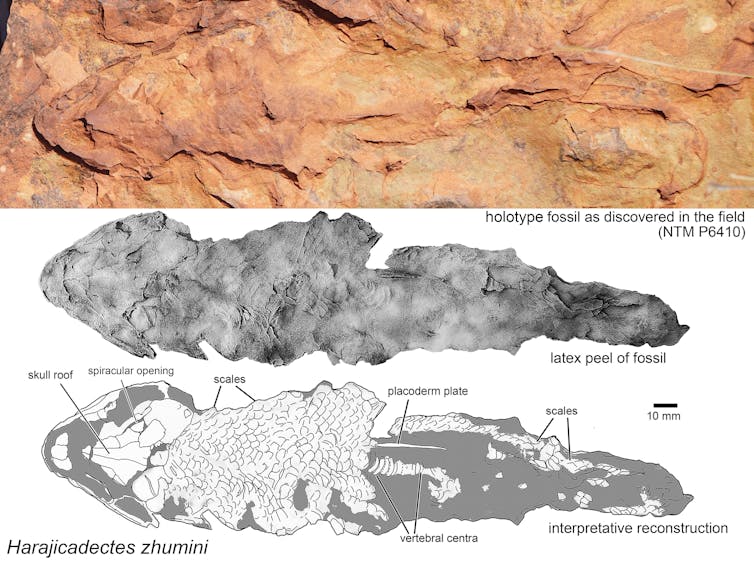
A Strange Apex Predator
Up to 40 centimetres long, Harajicadectes is the biggest fish found in the Harajica rocks. Likely the top predator of those ancient rivers, its big mouth was lined with closely-packed sharp teeth alongside larger, widely spaced triangular fangs.
It seems to have combined anatomical traits from different tetrapodomorph lineages via convergent evolution (when different creatures evolve similar features independently). An example of this are the patterns of bones in its skull and scales. Exactly where it sits among its closest relatives is difficult to resolve.
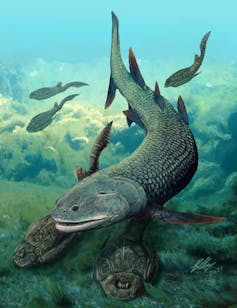
The most striking and perhaps most important features are the two huge openings on the top of the skull called spiracles. These typically only appear as minute slits in most early bony fishes.
Similar giant spiracles also appear in Gogonasus, a marine tetrapodomorph from the famous Late Devonian Gogo Formation of Western Australia. (It doesn’t appear to be an immediate relative of Harajicadectes.)
They are also seen in the unrelated Pickeringius, an early ray-finned fish that was also at Gogo.
The Earliest Air-Breathers?
Other Devonian animals that sported such spiracles were the famous elpistostegalians – freshwater tetrapodomorphs from the Northern Hemisphere such as Elpistostege and Tiktaalik.
These animals were extremely close to the ancestry of limbed vertebrates. So, enlarged spiracles seem to have arisen independently in at least four separate lineages of Devonian fishes.
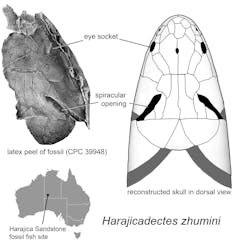
The only living fishes with similar structures are bichirs, African ray-finned fishes that live in shallow floodplains and estuaries. It was recently confirmed they draw surface air through their spiracles to aid survival in oxygen-poor waters.
That these structures appeared roughly simultaneously in four Devonian lineages provides a fossil “signal” for scientists attempting to reconstruct atmospheric conditions in the distant past.
It could help us uncover the evolution of air breathing in backboned animals.![]()
Brian Choo, Postdoctoral fellow in vertebrate palaeontology, Flinders University; Alice Clement, Research Associate in the College of Science and Engineering, Flinders University, and John Long, Strategic Professor in Palaeontology, Flinders University
This article is republished from The Conversation under a Creative Commons license. Read the original article.
Pittwater Reserves: Histories + Notes + Pictorial Walks
A History Of The Campaign For Preservation Of The Warriewood Escarpment by David Palmer OAM and Angus Gordon OAM
A Stroll Around Manly Dam: Spring 2023 by Kevin Murray and Joe Mills
A Stroll Through Warriewood Wetlands by Joe Mills February 2023
A Walk Around The Cromer Side Of Narrabeen Lake by Joe Mills
America Bay Track Walk - photos by Joe Mills
An Aquatic June: North Narrabeen - Turimetta - Collaroy photos by Joe Mills
Angophora Reserve Angophora Reserve Flowers Grand Old Tree Of Angophora Reserve Falls Back To The Earth - History page
Annie Wyatt Reserve - A Pictorial
Aquatic Reflections seen this week (May 2023): Narrabeen + Turimetta by Joe Mills
Avalon's Village Green: Avalon Park Becomes Dunbar Park - Some History + Toongari Reserve and Catalpa Reserve
Bairne Walking Track Ku-Ring-Gai Chase NP by Kevin Murray
Bangalley Headland Bangalley Mid Winter
Bangalley Headland Walk: Spring 2023 by Kevin Murray and Joe Mills
Banksias of Pittwater
Barrenjoey Boathouse In Governor Phillip Park Part Of Our Community For 75 Years: Photos From The Collection Of Russell Walton, Son Of Victor Walton
Barrenjoey Headland: Spring flowers
Barrenjoey Headland after fire
Bayview Baths
Bayview Wetlands
Beeby Park
Bilgola Beach
Botham Beach by Barbara Davies
Bungan Beach Bush Care
Careel Bay Saltmarsh plants
Careel Bay Birds
Careel Bay Clean Up day
Careel Bay Playing Fields History and Current
Careel Creek
Careel Creek - If you rebuild it they will come
Centre trail in Ku-ring-gai Chase National Park
Chiltern Track- Ingleside by Marita Macrae
Clareville Beach
Clareville/Long Beach Reserve + some History
Coastal Stability Series: Cabbage Tree Bay To Barrenjoey To Observation Point by John Illingsworth, Pittwater Pathways, and Dr. Peter Mitchell OAM
Cowan Track by Kevin Murray
Curl Curl To Freshwater Walk: October 2021 by Kevin Murray and Joe Mills
Currawong and Palm Beach Views - Winter 2018
Currawong-Mackerel-The Basin A Stroll In Early November 2021 - photos by Selena Griffith
Currawong State Park Currawong Beach + Currawong Creek
Deep Creek To Warriewood Walk photos by Joe Mills
Drone Gives A New View On Coastal Stability; Bungan: Bungan Headland To Newport Beach + Bilgola: North Newport Beach To Avalon + Bangalley: Avalon Headland To Palm Beach
Duck Holes: McCarrs Creek by Joe Mills
Dunbar Park - Some History + Toongari Reserve and Catalpa Reserve
Dundundra Falls Reserve: August 2020 photos by Selena Griffith - Listed in 1935
Elsie Track, Scotland Island
Elvina Track in Late Winter 2019 by Penny Gleen
Elvina Bay Walking Track: Spring 2020 photos by Joe Mills
Elvina Bay-Lovett Bay Loop Spring 2020 by Kevin Murray and Joe Mills
Fern Creek - Ingleside Escarpment To Warriewood Walk + Some History photos by Joe Mills
Iluka Park, Woorak Park, Pittwater Park, Sand Point Reserve, Snapperman Beach Reserve - Palm Beach: Some History
Ingleside
Ingleside Wildflowers August 2013
Irrawong - Ingleside Escarpment Trail Walk Spring 2020 photos by Joe Mills
Irrawong - Mullet Creek Restoration
Katandra Bushland Sanctuary - Ingleside
Lucinda Park, Palm Beach: Some History + 2022 Pictures
McCarrs Creek
McCarr's Creek to Church Point to Bayview Waterfront Path
McKay Reserve
Mona Vale Beach - A Stroll Along, Spring 2021 by Kevin Murray
Mona Vale Headland, Basin and Beach Restoration
Mona Vale Woolworths Front Entrance Gets Garden Upgrade: A Few Notes On The Site's History
Mother Brushtail Killed On Barrenjoey Road: Baby Cried All Night - Powerful Owl Struck At Same Time At Careel Bay During Owlet Fledgling Season: calls for mitigation measures - The List of what you can do for those who ask 'What You I Do' as requested
Mount Murray Anderson Walking Track by Kevin Murray and Joe Mills
Mullet Creek
Narrabeen Creek
Narrabeen Lagoon Catchment: Past Notes Present Photos by Margaret Woods
Narrabeen Lagoon Entrance Clearing Works: September To October 2023 pictures by Joe Mills
Narrabeen Lagoon State Park
Narrabeen Lagoon State Park Expansion
Narrabeen Rockshelf Aquatic Reserve
Nerang Track, Terrey Hills by Bea Pierce
Newport Bushlink - the Crown of the Hill Linked Reserves
Newport Community Garden - Woolcott Reserve
Newport to Bilgola Bushlink 'From The Crown To The Sea' Paths: Founded In 1956 - A Tip and Quarry Becomes Green Space For People and Wildlife
Pittwater Reserves: The Green Ways; Bungan Beach and Bungan Head Reserves: A Headland Garden
Pittwater Reserves, The Green Ways: Clareville Wharf and Taylor's Point Jetty
Pittwater Reserves: The Green Ways; Hordern, Wilshire Parks, McKay Reserve: From Beach to Estuary
Pittwater Reserves - The Green Ways: Mona Vale's Village Greens a Map of the Historic Crown Lands Ethos Realised in The Village, Kitchener and Beeby Parks
Pittwater Reserves: The Green Ways Bilgola Beach - The Cabbage Tree Gardens and Camping Grounds - Includes Bilgola - The Story Of A Politician, A Pilot and An Epicure by Tony Dawson and Anne Spencer
Pittwater spring: waterbirds return to Wetlands
Pittwater's Lone Rangers - 120 Years of Ku-Ring-Gai Chase and the Men of Flowers Inspired by Eccleston Du Faur
Pittwater's Great Outdoors: Spotted To The North, South, East + West- June 2023: Palm Beach Boat House rebuild going well - First day of Winter Rainbow over Turimetta - what's Blooming in the bush? + more by Joe Mills, Selena Griffith and Pittwater Online
Pittwater's Parallel Estuary - The Cowan 'Creek
Resolute Track at West Head by Kevin Murray
Resolute Track Stroll by Joe Mills
Riddle Reserve, Bayview
Salvation Loop Trail, Ku-Ring-Gai Chase National Park- Spring 2020 - by Selena Griffith
Seagull Pair At Turimetta Beach: Spring Is In The Air!
Some late November Insects (2023)
Stapleton Reserve
Stapleton Park Reserve In Spring 2020: An Urban Ark Of Plants Found Nowhere Else
Stony Range Regional Botanical Garden: Some History On How A Reserve Became An Australian Plant Park
The Chiltern Track
The Chiltern Trail On The Verge Of Spring 2023 by Kevin Murray and Joe Mills
The Resolute Beach Loop Track At West Head In Ku-Ring-Gai Chase National Park by Kevin Murray
Topham Track Ku-Ring-Gai Chase NP, August 2022 by Joe Mills and Kevin Murray
Towlers Bay Walking Track by Joe Mills
Trafalgar Square, Newport: A 'Commons' Park Dedicated By Private Landholders - The Green Heart Of This Community
Tranquil Turimetta Beach, April 2022 by Joe Mills
Turimetta Beach Reserve by Joe Mills, Bea Pierce and Lesley
Turimetta Beach Reserve: Old & New Images (by Kevin Murray) + Some History
Turimetta Headland
Turimetta Moods by Joe Mills: June 2023
Turimetta Moods (Week Ending June 23 2023) by Joe Mills
Turimetta Moods: June To July 2023 Pictures by Joe Mills
Turimetta Moods: July Becomes August 2023 by Joe Mills
Turimetta Moods: August Becomes September 2023 ; North Narrabeen - Turimetta - Warriewood - Mona Vale photographs by Joe Mills
Turimetta Moods: Mid-September To Mid-October 2023 by Joe Mills
Warriewood Wetlands - Creeks Deteriorating: How To Report Construction Site Breaches, Weed Infestations + The Long Campaign To Save The Warriewood Wetlands & Ingleside Escarpment March 2023
Warriewood Wetlands and Irrawong Reserve
Whale Beach Ocean Reserve: 'The Strand' - Some History On Another Great Protected Pittwater Reserve
Wilshire Park Palm Beach: Some History + Photos From May 2022
Winji Jimmi - Water Maze

Pittwater's Birds
Australian Predators of the Sky by Penny Olsen - published by National Library of Australia
Australian Raven Australian Wood Duck Family at Newport
A Week In Pittwater Issue 128 A Week In Pittwater - June 2014 Issue 168
Baby Birds Spring 2015 - Rainbow Lorikeets in our Yard - for Children Baby Birds by Lynleigh Greig, Southern Cross Wildlife Care - what do if being chased by a nesting magpie or if you find a baby bird on the ground
Baby Kookaburras in our Backyard: Aussie Bird Count 2016 - October
Balloons Are The Number 1 Marine Debris Risk Of Mortality For Our Seabirds - Feb 2019 Study
Bangalley Mid-Winter Barrenjoey Birds Bird Antics This Week: December 2016
Bird of the Month February 2019 by Michael Mannington
Birdland Above the Estuary - October 2012 Birds At Our Window Birds at our Window - Winter 2014 Birdland June 2016
Birdsong Is a Lovesong at This time of The Year - Brown Falcon, Little Wattle Bird, Australian Pied cormorant, Mangrove or Striated Heron, Great Egret, Grey Butcherbird, White-faced Heron
Bird Songs – poems about our birds by youngsters from yesterdays - for children Bird Week 2015: 19-25 October
Bird Songs For Spring 2016 For Children by Joanne Seve
Birds at Careel Creek this Week - November 2017: includes Bird Count 2017 for Local Birds - BirdLife Australia by postcode
Black Cockatoo photographed in the Narrabeen Catchment Reserves this week by Margaret G Woods - July 2019
Black-Necked Stork, Mycteria Australis, Now Endangered In NSW, Once Visited Pittwater: Breeding Pair shot in 1855
Black Swans on Narrabeen Lagoon - April 2013 Black Swans Pictorial
Endangered Little Tern Fishing at Mona Vale Beach
‘Feather Map of Australia’: Citizen scientists can support the future of Australia's wetland birds: for Birdwatchers, school students and everyone who loves our estuarine and lagoon and wetland birds
Fledgling Common Koel Adopted by Red Wattlebird -Summer Bird fest 2013 Flegdlings of Summer - January 2012
Flocks of Colour by Penny Olsen - beautiful new Bird Book Celebrates the 'Land of the Parrots'
Friendly Goose at Palm Beach Wharf - Pittwater's Own Mother Goose
Front Page Issue 177 Front Page Issue 185 Front Page Issue 193 - Discarded Fishing Tackle killing shorebirds Front Page Issue 203 - Juvenile Brush Turkey Front Page Issue 208 - Lyrebird by Marita Macrae Front Page Issue 219 Superb Fairy Wren Female Front Page Issue 234: National Bird Week October 19-25 and the 2015 the Aussie Back Yard Bird Count: Australia's First Bird Counts - a 115 Year Legacy - with a small insight into our first zoos Front Page Issue 236: Bird Week 2015 Front Page Issue 244: watebirds Front Page Issue 260: White-face Heron at Careel Creek Front Page Issue 283: Pittwater + more birds for Bird Week/Aussie Bird Count Front Page Issue 284: Pittwater + more birds for Bird Week/Aussie Bird Count Front Page Issue 285: Bird Week 2016 Front Page Issue 331: Spring Visitor Birds Return
G . E. Archer Russell (1881-1960) and His Passion For Avifauna From Narrabeen To Newport
Glossy Black-Cockatoo Returns To Pittwater by Paul Wheeler Glossy Cockatoos - 6 spotted at Careel Bay February 2018
Grey Butcher Birds of Pittwater
INGLESIDE LAND RELEASE ON AGAIN BUT MANY CHALLENGES AHEAD by David Palmer
Issue 60 May 2012 Birdland - Smiles- Beamings -Early -Winter - Blooms
Jayden Walsh’s Northern Beaches Big Year - courtesy Pittwater Natural Heritage Association
John Gould's Extinct and Endangered Mammals of Australia by Dr. Fred Ford - Between 1850 and 1950 as many mammals disappeared from the Australian continent as had disappeared from the rest of the world between 1600 and 2000! Zoologist Fred Ford provides fascinating, and often poignant, stories of European attitudes and behaviour towards Australia's native fauna and connects these to the animal's fate today in this beautiful new book - our interview with the author
July 2012 Pittwater Environment Snippets; Birds, Sea and Flowerings
Juvenile Sea Eagle at Church Point - for children
King Parrots in Our Front Yard
Kookaburra Turf Kookaburra Fledglings Summer 2013 Kookaburra Nesting Season by Ray Chappelow Kookaburra Nest – Babies at 1.5 and 2.5 weeks old by Ray Chappelow Kookaburra Nest – Babies at 3 and 4 weeks old by Ray Chappelow Kookaburra Nest – Babies at 5 weeks old by Ray Chappelow Kookaburra and Pittwater Fledglings February 2020 to April 2020
Lion Island's Little Penguins (Fairy Penguins) Get Fireproof Homes - thanks to NSW National Parks and Wildlife Service and the Fix it Sisters Shed
Lyre Bird Sings in Local National Park - Flock of Black Cockatoos spotted - June 2019
Magpie's Melodic Melodies - For Children (includes 'The Magpie's Song' by F S Williamson)
Masked Lapwing (Plover) - Reflected
May 2012 Birdland Smiles Beamings Early Winter Blooms
Musk Lorikeets In Pittwater: Pittwater Spotted Gum Flower Feast - May 2020
Nankeen Kestrel Feasting at Newport: May 2016
National Bird Week 2014 - Get Involved in the Aussie Backyard Bird Count: National Bird Week 2014 will take place between Monday 20 October and Sunday 26 October, 2014. BirdLife Australia and the Birds in Backyards team have come together to launch this year’s national Bird Week event the Aussie Backyard Bird Count! This is one the whole family can do together and become citizen scientists...
National Bird Week October 19-25 and the 2015 the Aussie Back Yard Bird Count: Australia's First Bird Counts - a 115 Year Legacy - with a small insight into our first zoos
Nature 2015 Review Earth Air Water Stone
New Family of Barking Owls Seen in Bayview - Church Point by Pittwater Council
Noisy Visitors by Marita Macrae of PNHA
Odes to Australia's Fairy-wrens by Douglas Brooke Wheelton Sladen and Constance Le Plastrier 1884 and 1926
Oystercatcher and Dollarbird Families - Summer visitors
Painted Button-Quail Rescued By Locals - Elanora-Ingleside escarpment-Warriewood wetlands birds
Palm Beach Protection Group Launch, Supporters Invited: Saturday Feb.16th - Residents Are Saying 'NO' To Off-Leash Dogs In Station Beach Eco-System - reports over 50 dogs a day on Station Beach throughout December-January (a No Dogs Beach) small children being jumped on, Native birds chased, dog faeces being left, families with toddlers leaving beach to get away from uncontrolled dogs and 'Failure of Process' in council 'consultation' open to February 28th
Pardalote, Scrub Wren and a Thornbill of Pittwater
Pecking Order by Robyn McWilliam
Pelican Lamps at Narrabeen Pelican Dreamsong - A Legend of the Great Flood - dreamtime legend for children
Pittwater Becalmed Pittwater Birds in Careel Creek Spring 2018 Pittwater Waterbirds Spring 2011 Pittwater Waterbirds - A Celebration for World Oceans Day 2015
Pittwater's Mother Nature for Mother's Day 2019
Plastic in 99 percent of seabirds by 2050 by CSIRO
Plover Appreciation Day September 16th 2015
Powerful and Precious by Lynleigh Grieg
Red Wattlebird Song - November 2012
Restoring The Diamond: every single drop. A Reason to Keep Dogs and Cats in at Night.
Return Of Australasian Figbird Pair: A Reason To Keep The Trees - Aussie Bird Count 2023 (16–22 October) You can get involved here: aussiebirdcount.org.au
Sea Birds off the Pittwater Coast: Albatross, Gannet, Skau + Australian Poets 1849, 1898 and 1930, 1932
Sea Eagle Juvenile at Church Point
Seen but Not Heard: Lilian Medland's Birds - Christobel Mattingley - one of Australia's premier Ornithological illustrators was a Queenscliff lady - 53 of her previously unpublished works have now been made available through the auspices of the National Library of Australia in a beautiful new book
7 Little Ducklings: Just Keep Paddling - Australian Wood Duck family take over local pool by Peta Wise
Shag on a North Avalon Rock - Seabirds for World Oceans Day 2012
Short-tailed Shearwaters Spring Migration 2013
South-West North-East Issue 176 Pictorial
Spring 2012 - Birds are Splashing - Bees are Buzzing
Spring Becomes Summer 2014- Royal Spoonbill Pair at Careel Creek
Spring Notes 2018 - Royal Spoonbill in Careel Creek
Station Beach Off Leash Dog Area Proposal Ignores Current Uses Of Area, Environment, Long-Term Fauna Residents, Lack Of Safe Parking and Clearly Stated Intentions Of Proponents have your say until February 28, 2019
Summer 2013 BirdFest - Brown Thornbill Summer 2013 BirdFest- Canoodlers and getting Wet to Cool off Summer 2013 Bird Fest - Little Black Cormorant Summer 2013 BirdFest - Magpie Lark
South Curl Curl Surf Club's Boaties Big Rescue Earns SLSNSW Award

Pictures From The Past: Station Beach, Barrenjoey- Circa 1879
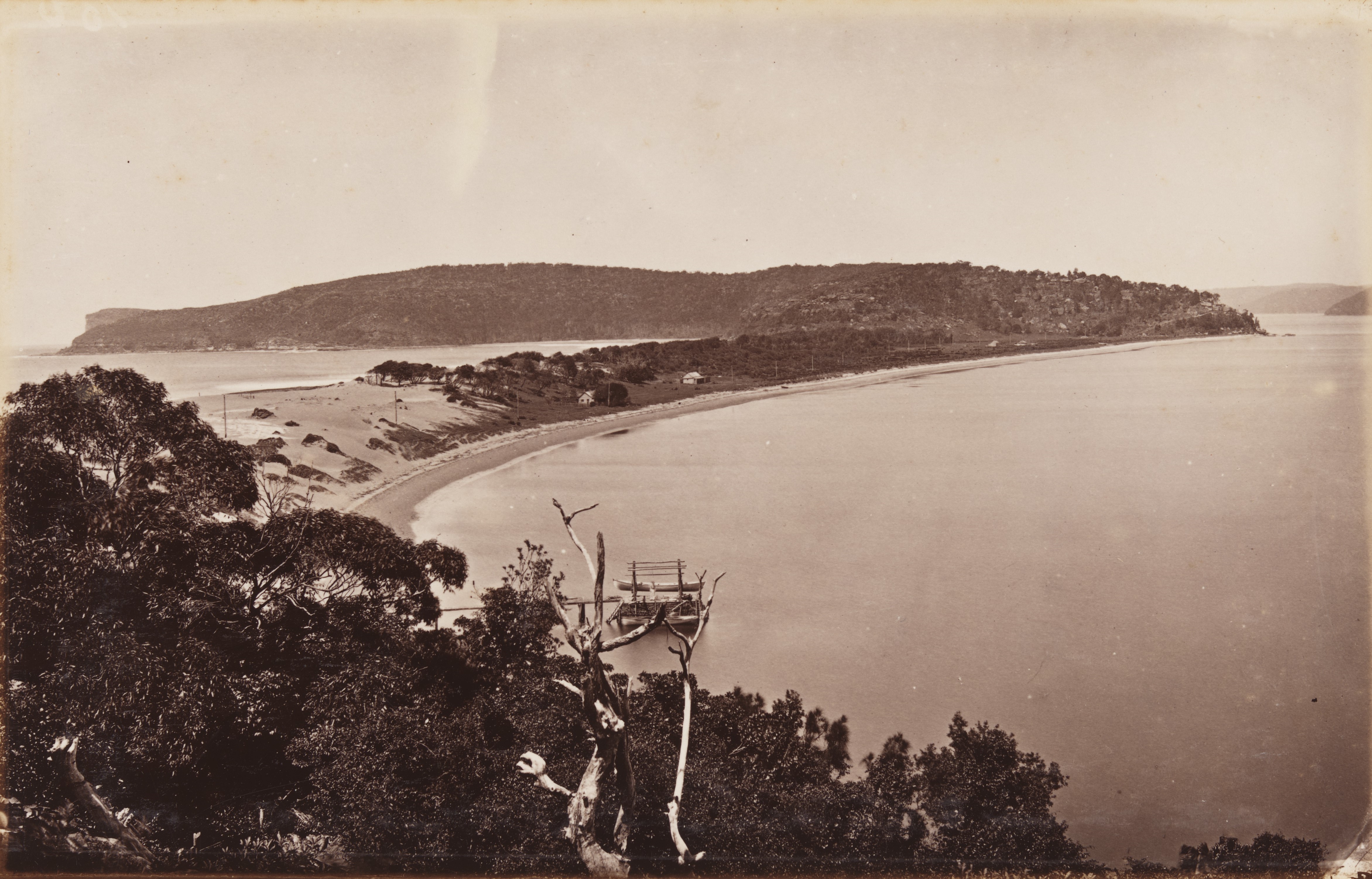
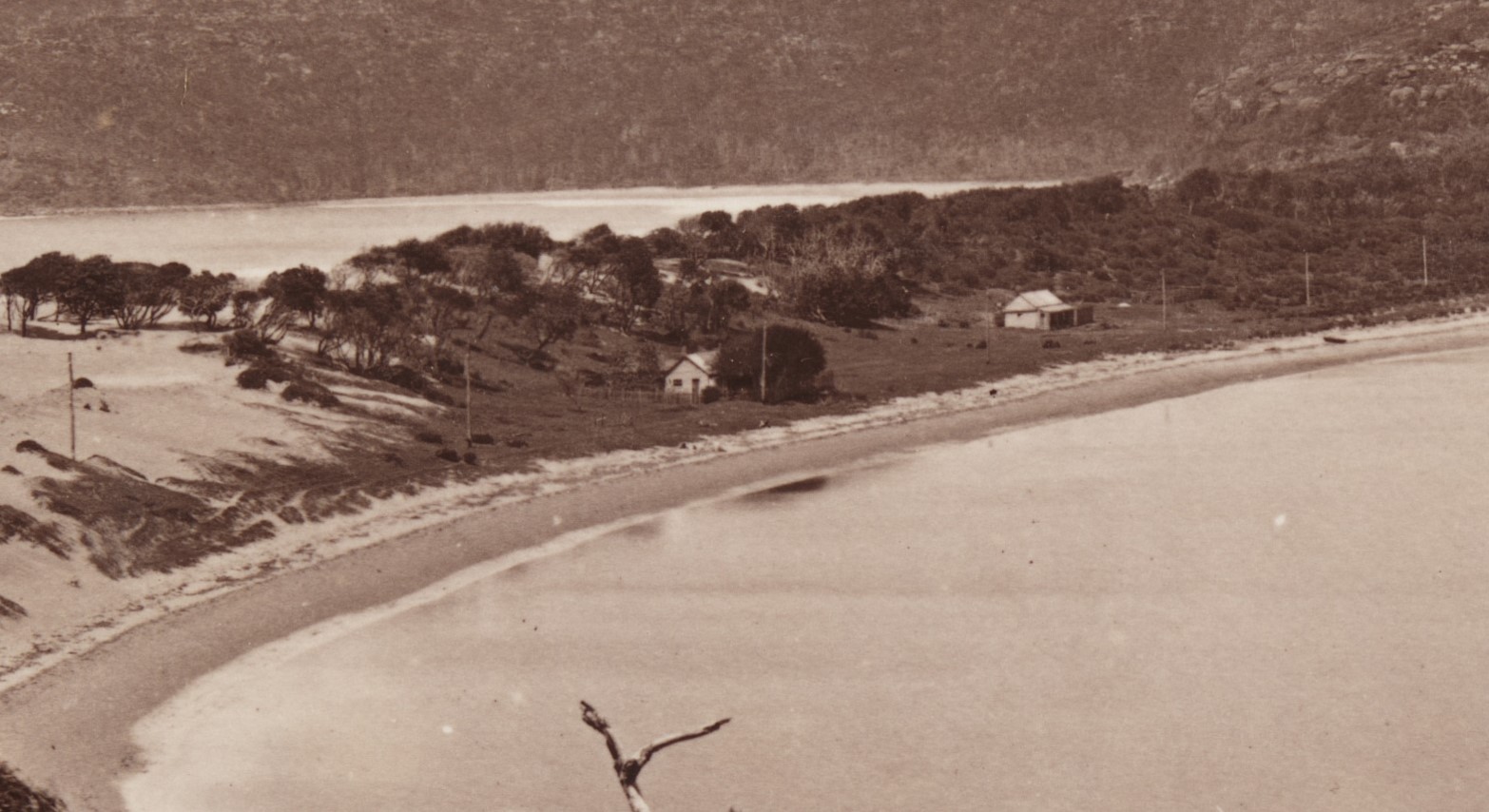
.jpg?timestamp=1707416129938)
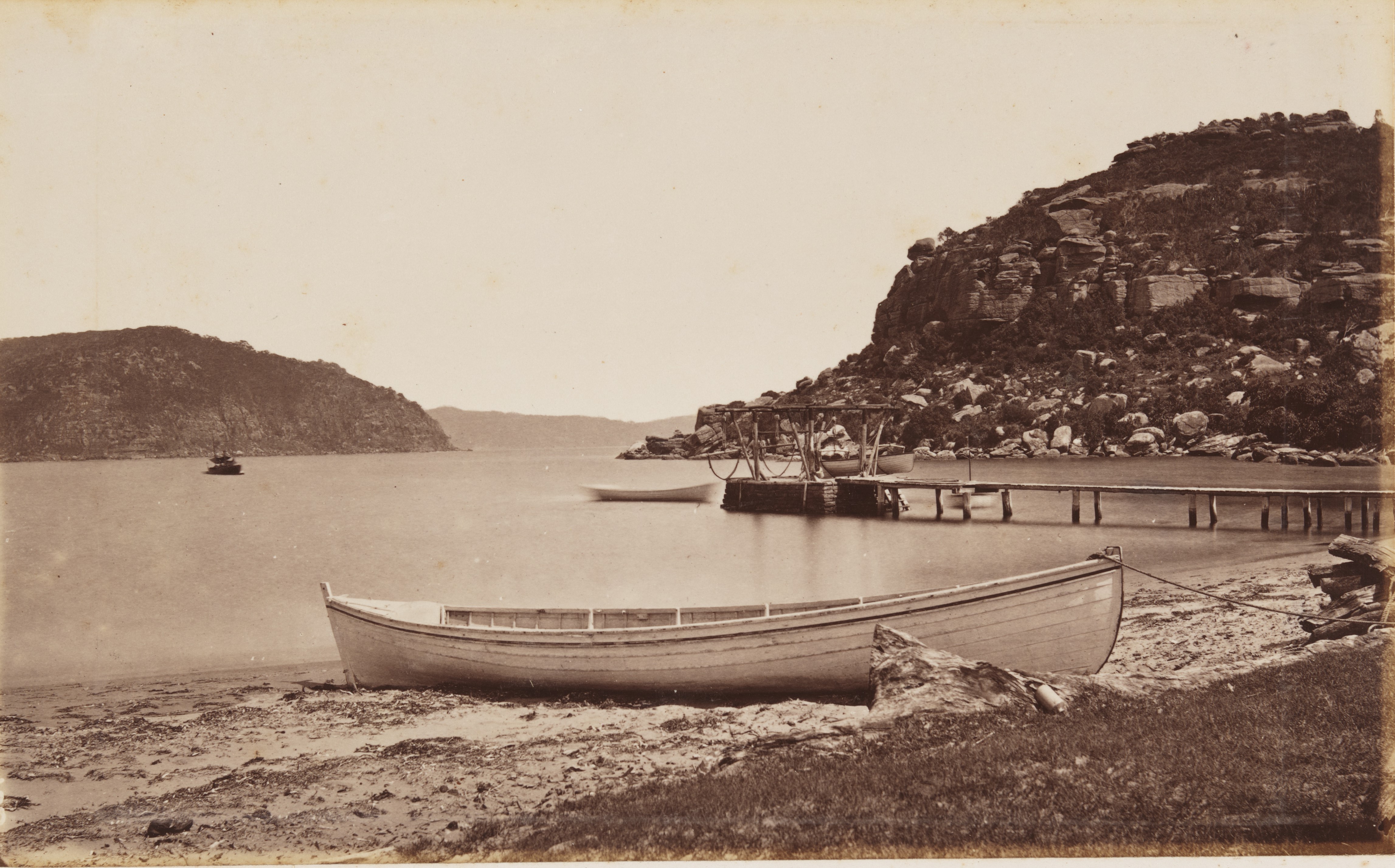
.jpg?timestamp=1707416223245)
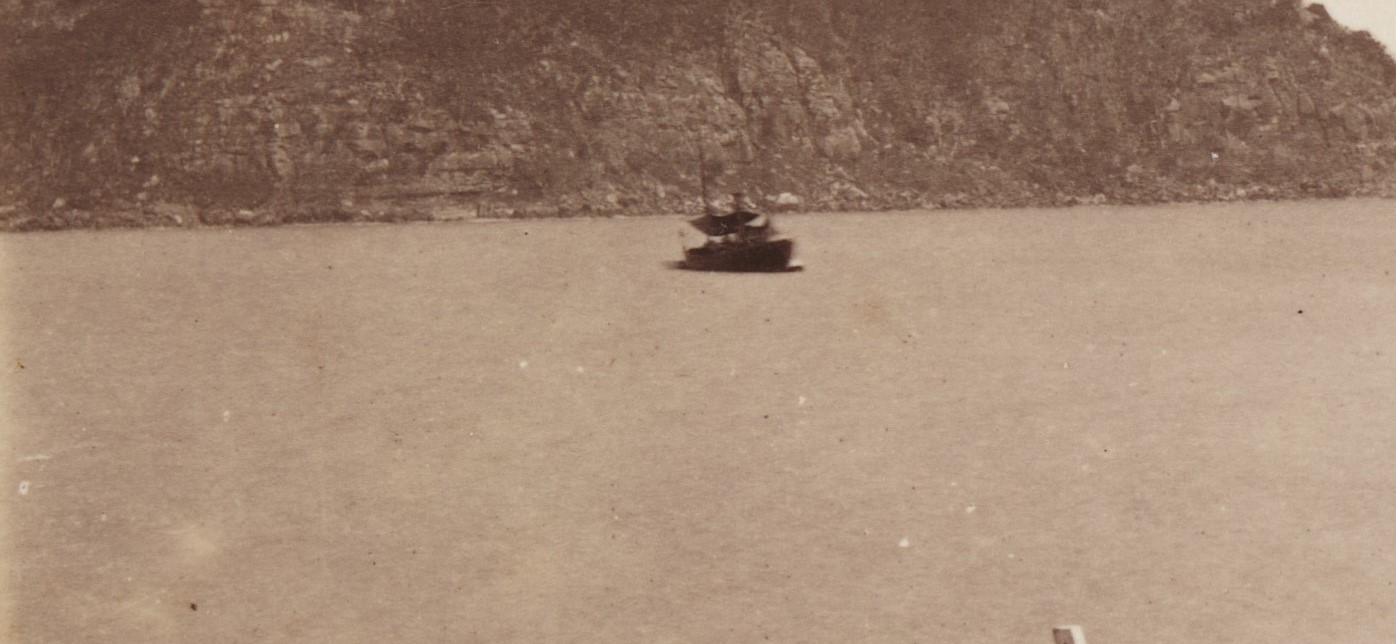
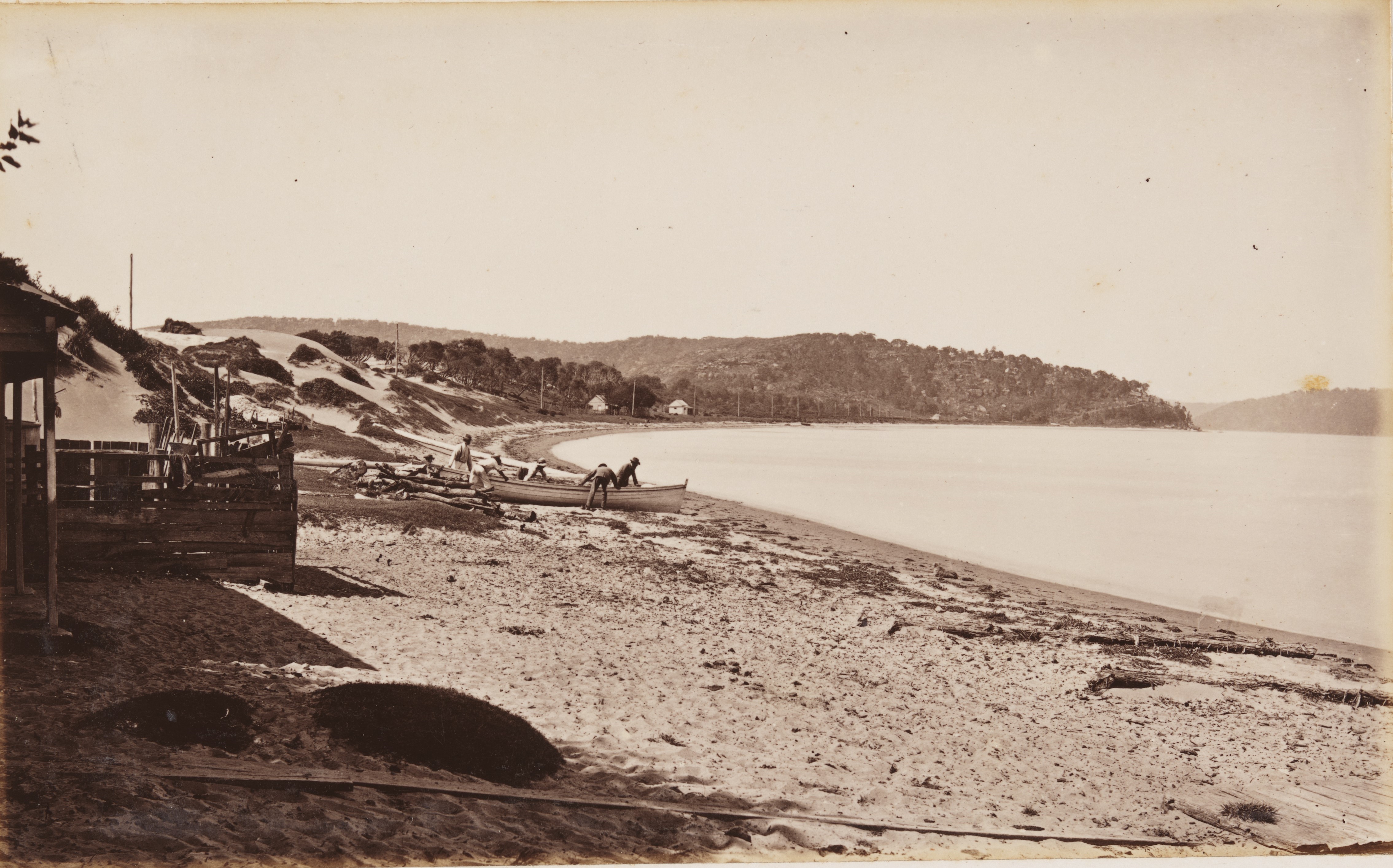
.jpg?timestamp=1707416322130)
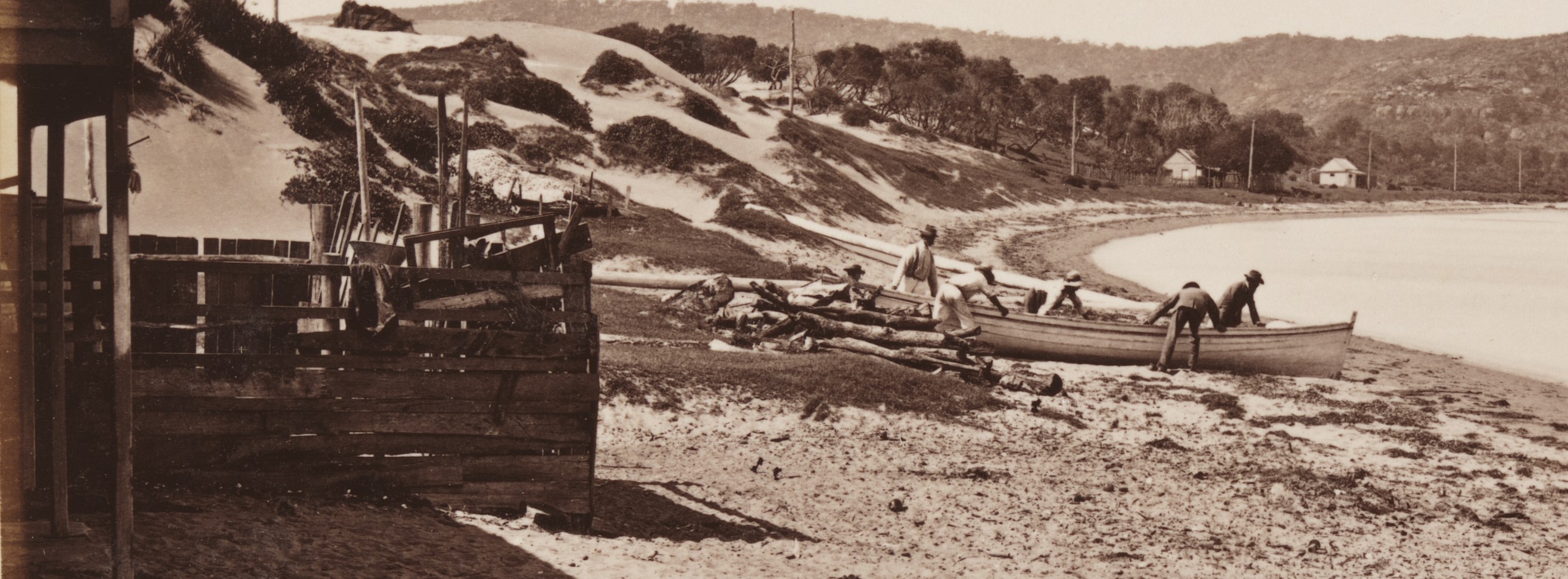
In Smuggling at Broken Bay by Shelagh Champion OAM a notorious instance of smuggling in Pittwater indicates a ‘final straw’ and reason for constructing and maintaining a Customs Station in Broken Bay by 1842. Pittwater, Broken Bay and the many tributaries of the Hawkesbury with all their caves along shorelines and creek beds were obvious places to hide contraband and move it overland into Sydney. The amount of large and small vessels coming and going or mooring in Pittwater’s quieter waters when gales made seas dangerous, and a logged count of these, would have added impetus in checking the destinations and safety of the many ships running up and down the east coast of Australia.
The Pittwater waterways and sheltered coves in the early days of New South Wales settlement by Europeans were considered to be Sydney’s second harbour and a port people at leisure as well as in the business of shipping goods knew well. Relatives of original settlers speak of an attitude of Pittwater being far enough away from Sydney to be free of the scrutiny of Law keepers. With men who also worked their own holdings appointed as constables for the district, Martin Burke and Robert MacIntosh (Pittwater) Robert Henderson (Brisbane Waters), a man who later sold rum, ambiguity around those sent to catch crooks smuggling or residents running illegal stills focused further scrutiny on the district. Interestingly the name of a local cave, the ‘Hole in the Wall’ at Avalon, seems to illustrate a long held local attitude towards the ‘rogue’s game’;
''Hole In the Wall."
When I was in Scotland, I visited many crofter's homes in the Highlands with my uncle, a minister of the Church of Scotland. The typical home of the Scotch peasants consists of a passage and a "But and Ben" on the ground floor, and a loft above the "But" is the living room or kitchen, and the "Ben" is the best room. In both are the concealed beds always known as box-beds. Sliding doors hide the beds during the day. I have seen these beds in a modern flat in Glasgow, and in crofters' homes around Grantown, also at Cromarty, Inverness, Dingwall, Oban, and Helensburgh, but never heard them called "The Hole in the Wall;" they are always termed box-beds. I believe Robbie Burns was born in one, and I think so was Hugh Millar.
Is it not more likely that the old Inn at Paddington called "The Hole in the Wall" derived its name from the old "Hole In the Wall" at Pittwater, near Sydney, which was well known 70 or 80 years ago, or from some similar natural formation in the cliffs found very frequently along the Cornish coast. These were commonly associated with the smuggling of brandy and French wines to escape the duty. Many a boatload of contraband spirits escaped the excise officers by disappearing through one of these, natural arches called "The Hole in the Wall." It seems very possible that some old Sydney Innkeeper associated with smuggling in his early days, or with the providing of duty free spirits, called his inn by this name in the hope of attracting ex-smugglers, seamen, and others who, on principle, preferred spirits that had evaded the duty. I am, etc., MARY E. J. YEO. Yass, Oct. 27. "THE HOLE IN THE WALL.". (1927, October 31). The Sydney Morning Herald (NSW : 1842 - 1954), p. 8. Retrieved from http://nla.gov.au/nla.news-article28054926
More about the 'Hole in the Wall' in St Michael's Cave - North Avalon Headland: Some History
The fictional ‘Three Fifties and a Ten’ by the proprietor of the ‘Hawkesbury Chronicle’ George C Johnson, written under one of his nom de plumes, 'Kooyal', gives a further great recounting of one groups escapades meeting a ship off Barrenjoey and moving contraband up the river. Another letter regarding the then recent offloading of rum and brandy from the Fair Barbadian into Broken Bay ignited the District’s infamy anew and was a clarion call demanding to be answered:
SMUGGLING. To the Editors of the Sydney Herald.
GENTLEMEN,--As the late seizure of spirits made by the Water Police, is now the general topic of conversation, I have no doubt it will arouse the Government from the state of apathy and indolence in which it has been indulging itself for the past two years, and show its members the necessity of taking the most prompt and energetic measures, in order| to put a stop to a practice which threatens materially to diminish the revenue, and cause distress to the fair trader : for there can bono doubt, that although the quantity lately seized is large, yet we are warranted to say that it bears a very small proportion to that already successfully run during the past two years, or since the extra inducement has been held out by the Government in the increase of duties ; an inducement which would have yielded to the smuggler of the above spirits, had he succeeded, a clear profit of upwards of £280 above the amount of duties, hail they been as before, at 10s. 2d. per gallon; with such a fact before our eyes, let us ask the Government what has it done to prevent these nefarious transactions? Has it increased the number of revenue officers? Has it established any outports along the coast? No! Or, in a word, has it taken such measures as the nature of the coast, and the inducement offered to the smuggler, would lead us to expect? We are reluctantly compelled to answer in the negative. But leaving for a short time the above, let us take a slight glance at the manner in which these smuggling transactions are carried on, which is simply as follows : a merchant enters for exportation a certain quantity of spirits, signs the usual bonds, passes the proper entries, which being duly accomplished, a Custom House officer is appointed to see the goods properly shipped, which is accordingly done; thus far everything goes on correctly. After receiving the quantity of spirits and tobacco intended to be run, the vessel clears out for Guam, New Zealand, or some such port, hovers about the coast some time to see if she is observed, runs into Broken Bay, and there discharges her cargo, which is stored in some secluded spot, and brought up to Sydney in small quantities, (according to the demand), by the various coasters in the employ of the agents at those parts; these, upon arrival, land their cargoes without the slightest examination, which are accordingly carted away and deposited in the warehouses, and the smuggling finally and successfully completed.
If the above is a correct statement, of the manner in which smuggling is carried on, surely Government is called upon to use every endeavour, if not entirely to suppress, at least to prevent its being carried on to so alarming an extent in the first place, if instead of allowing the revenue cutter to lie idle in the harbour for weeks together, it was sent to keep a continued and vigilant cruise along and in the inlets of the coast, much good might be effected; again, an, active revenue officer with a boat's crew, might be stationed at Broken Bay, or one of the most convenient spots to overhaul every coaster in and out; and thirdly, one or two officers might be stationed to examine the discharge of the coasters, these, with an active watch by the Water Police stationed at Goat Island and Bradley's Head, and keeping an eye at Johnson's Bay, might tend materially to lessen such practices,-and there is no doubt that the increase of the revenue would fully meet the increasing expense of such appointments, and give satisfaction to all parties opposed to this wholesale system of smuggling. COAST GUARD. SMUGGLING. (1842, June 25). The Sydney Herald (NSW : 1831 - 1842), p. 2. Retrieved from http://nla.gov.au/nla.news-article12875864
Government discussions then took place;
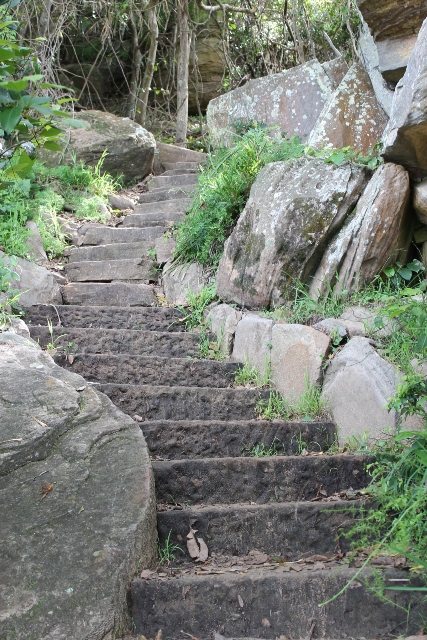 Some conversation took place relative to some additional officers being stationed at Broken Bay, for the prevention of smuggling in that neighbourhood. The Governor said he was aware that it was requisite something should be done in that quarter, but he was not yet prepared with any measure to propose to the council. Legislative Council. (1842, August 11). Australasian Chronicle(Sydney, NSW : 1839 - 1843), p. 2. Retrieved from http://nla.gov.au/nla.news-article31736840
Some conversation took place relative to some additional officers being stationed at Broken Bay, for the prevention of smuggling in that neighbourhood. The Governor said he was aware that it was requisite something should be done in that quarter, but he was not yet prepared with any measure to propose to the council. Legislative Council. (1842, August 11). Australasian Chronicle(Sydney, NSW : 1839 - 1843), p. 2. Retrieved from http://nla.gov.au/nla.news-article31736840
While the trial of those responsible appeared in local newspapers late in 1842, four convicts were sent to build a three roomed timber Customs House and track up to the headland. On 1 November 1st 1842 John Broadley Howard wrote to His Excellency the Governor, soliciting the appointment as Customs Officer. From the Customs House, Sydney, he wrote that;
“I have been upwards of six years a Clerk in this Office, and that previously I had been many years engaged in Maritime pursuits abroad & am well experienced in the management of Boats and affairs of shipping generally.” He was also intimately acquainted with all the vessels belonging to the port at Sydney, and their owners, which he thought would give him an advantage over a stranger in the job. [AO 4/2723] His appointment was recommended by Colonel Gibbes, the Collector of Customs on 23 January 1843. Gibbes described him as being the “third clerk in the Long Room” at the Customs House. Howard was given his orders by Colonel Gibbes on 15 April 1843. [AO 4/5113]
“Three tents will be lent, one for the Officer, one for the Coxswain, and one for the five men until such time as the Huts are erected. The men’s Huts are to [be] built on the Green mound at the foot of the Mountain called Barrenjuee to the Northward and Westward of the Creek and not to extend to the Southward of a supposed line drawn from a large rock on the western Beach, directly East to the Sea. These Huts to be formed of Slabs, with Shingle Roofs - a door - window - and fire place.
The Main Hut to be fourteen feet by ten and the Coxswain’s Hut ten feet by eight exclusive of the fire places. The Officer to place his House on such Spot as he may select - but not more than 400 yards from the men. The first point to be attended to will be to lay down the moorings for the large Boat near the Beach, but where she will not ground at low water and to which she is to be chained and locked. The next to deepen the water hole up the mountain by which a constant supply will be insured. The third to form a winding path up the South face of the Mountain (by clearing the bushes and making steps where required) to a flat space on the top near the western end where a Sentry Box, or watch Hut is to be built, and a flag staff erected. The Commander of the Cutter will point out the several sites. The Coxswain and two hands should be sent to procure slabs, posts, and ground plates and Bark. Two men should first clean the water Hole and afterwards clear the Path. Shingles and battens will most likely be bought cheaper than the men can split them; I should think from 7/- to 10/- the thousand and 3000 will do the two Huts. Stone enough can be procured for rough chimneys and some shells burnt for lime. The Carpenter should put up the bark watch Box and then proceed with the Huts, assisted by the two men who will have finished the Path. When all these matters are finished, all hands can go on with the Officer’s House, store and kitchen.”
The men in the Broken Bay Party were the Coxswain, John Bailey, Ticket of Leave, and five convicts (a carpenter and four boatmen). Howard’s salary was fixed at £175 per annum, with an additional £50 per annum to provide quarters for himself and family, and for the six men. The Government did not provide a house for him, but he regarded his allowance for rent as “handsome”, and thought it fair to put up a respectable cottage. By June the buildings had already cost £85; by August he had laid out above £100 and reckoned on £50 more before he had “made the station look at all comfortable.”
There was another worry: there was no suitable Government land available in the vicinity, and he had to build on private land belonging to the Wentworth family. By March 1844 he was in debt, the buildings having cost more than £200, besides which there was a demand from Captain Towns (the husband of D’Arcy Wentworth’s daughter Sophia) for £25 per annum rent, which Howard, although resisting, appeared to think was his responsibility.
The cottage was built beside where the current Ranger's House is. Directions from Colonel Gibbs of the Customs Service, Sydney, regarding the track were to
"Form a winding path up the south face of the mountain by clearing the bushes and making steps where required, to a flat place on the top near the western end where a sentry box or watch hut is to be built and a flag staff erected."
When the Customs Station was established, ships were required to report before entry into Broken Bay, so a watchman was posted to observe vessels arriving and departing. - "Tales of Barrenjoey" Jervis Sparks, 1992. National Parks and Wildlife Service NSW
This track is what we now know as 'Smugglers Track'; a steep, winding and narrow path. These prerequisites were completed by April 25th 1943 at quite a large sum - but in consequence of the formation of an establishment at Broken Bay, which had been deemed absolutely necessary, in order to prevent the recurrence of frauds on the revenue, which had been perpetrated to an enormous amount, an additional expense of £4386 10s. had been incurred. Legislative Council. (1843, September 30). Australasian Chronicle (Sydney, NSW : 1839 - 1843), p. 2. Retrieved from http://nla.gov.au/nla.news-article31741175
The first Customs Officer of Broken Bay did not have an auspicious beginning;
Providential Deliverance.
On Wednesday last, a boat was picked up in the vicinity of Bird Island by the steamer Thistle, on her passage from Morpeth. She had made signals to the steamer, which was instantly stopped for the purpose of affording succour. The boat was found to belong to the customs, having on board Mr. Howard and a party of three men from the custom's department, who had left Sydney in company with the revenue cutter, which latter was taking down several articles for the formation of the establishment of customs at Broken Bay ; and, upon getting outside the Heads, it commenced blowing very hard from the southwest, when the boats separated, Mr. Howard's boat being drifted off the land, which not withstanding their utmost exertions the men could not gain again, and in all probability never would, as they were twenty-four hours short of provisions, and being somewhat exhausted, they must inevitably have been drifted off to sea and perished, had not the Thistle providentially rescued them from their perilous situation. Captain Mulhall took them onboard the Thistle, and also had the boat hoisted in, and brought them back to Sydney. The other boat, which had also three men on board, has not since been heard of, and fears are entertained for her safety. SYDNEY. (1843, May 20). Launceston Examiner (Tas. : 1842 - 1899), p. 6 Edition: EVENING. Retrieved from http://nla.gov.au/nla.news-article36233574
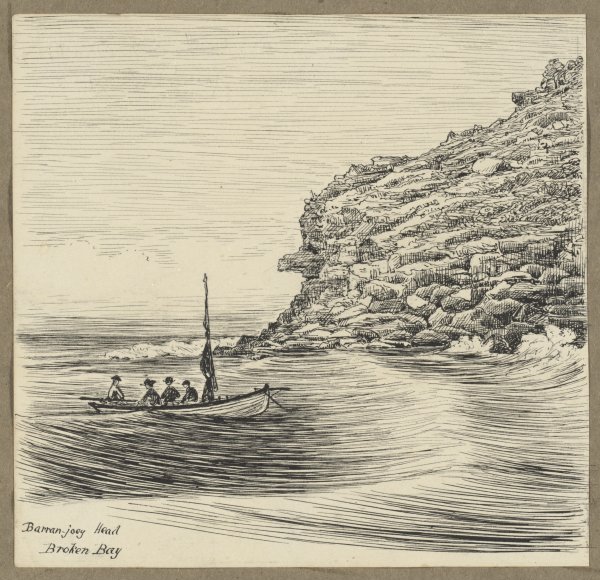
Barranjoey Head, Broken Bay [1884?] nla.pic-an6438965 by Graham, H. J. (Harold John), 1858-1929. Courtesy National Library of Australia
Mr Howard was one of many men who became fathers while stationed at Barrenjoey:
On Wednesday, the 14th instant, at the Customs Station, Broken Bay, Mrs. J. B.Howard, of a daughter. Family Notices. (1845, May 21). The Sydney Morning Herald(NSW : 1842 - 1954), p. 3. Retrieved from http://nla.gov.au/nla.news-article12879665
Apart from keeping an eye on all things shipping Mr Howard was an example of another obvious responsibility these men undertook was to care for those who came within their waters:
Shipwreck. - On Tuesday last, the 22nd instant, about thirty minutes past eight p.m. the cutter Mary Walfe, master, belonging to Mr Parnel, parted her cable whilst laying off Mount Elliott and went ashore. The master and his mate, the only persons on board, managed to save themselves and a portion of the stores. They were taken off the island by Mr Howard, the officer in charge of the customs station at Broken Bay, who lent them a boat, and assistance to proceed to the owner of the vessel, who lives up Burrowra Creek. IMPORTS. (1845, May 3). The Sydney Morning Herald (NSW : 1842 - 1954), p. 2. Retrieved from http://nla.gov.au/nla.news-article12879197
In September 1845 Mr. Howard received a promotion, being appointed Sub Collector of Customs at Portland Bay, Victoria. His place was taken by Richard Williams, who proved to be an efficient Acting Coast Waiter at Broken Bay, in spite of the total loss of sight in one eye.
NEW APPOINTMENT. — His Excellency the Governor haes been pleased to appoint Mr. Richard Williams, of the department of customs at Broken Bay, to be an inspector of distilleries. DR. LEICHARDT. (1846, April 1). Morning Chronicle (Sydney, NSW : 1843 - 1846), p. 2. Retrieved from http://nla.gov.au/nla.news-article31747700
A CONVICT BOATMAN.—On Saturday last, Mr. Richard Williams, Custom-house officer, stationed at Broken Bay, gave Bartholomew Doran, an assigned boatman to the Customs at Broken Bay, in charge to constable McDonald, of the Sydney Police, for robbing the hut of a man named Cornelius Shee. As Shee was absent when the charge was made, and his hut open and emptied of its contents, the value of the property stolen could not be estimated, Doran, on arriving in Sydney, was forwarded to the Hyde Park Barrack Court. Family Notices. (1847, January 27). The Sydney Morning Herald (NSW : 1842 - 1954), p. 2. Retrieved from http://nla.gov.au/nla.news-article12900402
The Customs Officers accepted the help of Bowen Bungaree, who lived with his family at Barrenjoey, in finding illegal stills and venturing out on dark nights to patrol the waters. His duties in successfully stamping out smuggling and illegal stills within the vicinity could also be attributed to a wooden soldier, installed by later Customs Coast Waiter, Mr. Ross;
PITT WATER. EARLY HISTORY. IN THE DAYS OF THE SMUGGLERS.
In a paper on early Pittwater read at the monthly meeting of the Manly Warringah and Pittwater Historical Society Mr W L Ross said that the inlet was an important centre in the early days of the settlement at Sydney Cove. The Hawkesbury and its tributaries produced the bulk of the cereals for the colony and Pittwater was the port for the farming districts. Shipbuilding was also carried on at Pittwater which was considered a wheat growing area. In 1819 a constable Robert McIntosh was sent to the district to preserve law and order
In 1804 said Mr Ross the natives complained to Governor Hunter that the settlers had grown so numerous that the natives had been driven back from the river. The Governor promised that a portion of the district would be reserved for the natives and the remains of their camping places may still be found around the head of Pittwater. For many years a customs-house remained at Barrenjoey and the customs officer had brushes with smugglers. One customs officer fashioned and erected a wooden figure of a soldier near the beach to check the smugglers. The wooden figure was dressed in a pair of white trousers, a scarlet coat and a tall helmet made of tin surmounted with a plume. There was a sword in the hand of the figure and scabbard at Its side. The figure was placed in front of a cave near where the lighthouse now stands. The figure said Mr Ross kept off many smugglers but the captain of one vessel thinking that the drawn sword was a signal of distress, landed to offer assistance and the ruse was exposed. The figure remained until a few years ago when white ants ate the legs and the figure collapsed " Wooden Soldier. (1927, August 2). The Sydney Morning Herald(NSW : 1842 - 1954), p. 10. Retrieved from http://nla.gov.au/nla.news-article16394068
Full history page at link above.
The Wonderful Songs Of The Butcher Bird - Summer In Pittwater: 15
A Day At The Beach: 1920'S
New Protections For Telco Customers Experiencing Hardship
- Broadening the definition of financial hardship to capture a wider set of circumstances which will assist both consumers and telcos in understanding when assistance should be made available
- Better promotion of financial hardship assistance, including provision of direct information to customers and potential customers who are or may be experiencing difficulties
- Requirements to offer financial hardship customers a minimum of 6 different options for assistance, including payment plans and the option to extend or defer payment
- Stronger protections for customers facing credit management action including more stringent requirements before a customer can be disconnected, and an extended disconnection notice period up from 5 to 10 working days.

Newport Rugby: Come & Try Event For Women + Girls

North Avalon Surfriders Association: NASA 2024 Registration Is Now Open.


‘Paddle For Change’ – A Youth Led Climate Action Event: Mona Vale
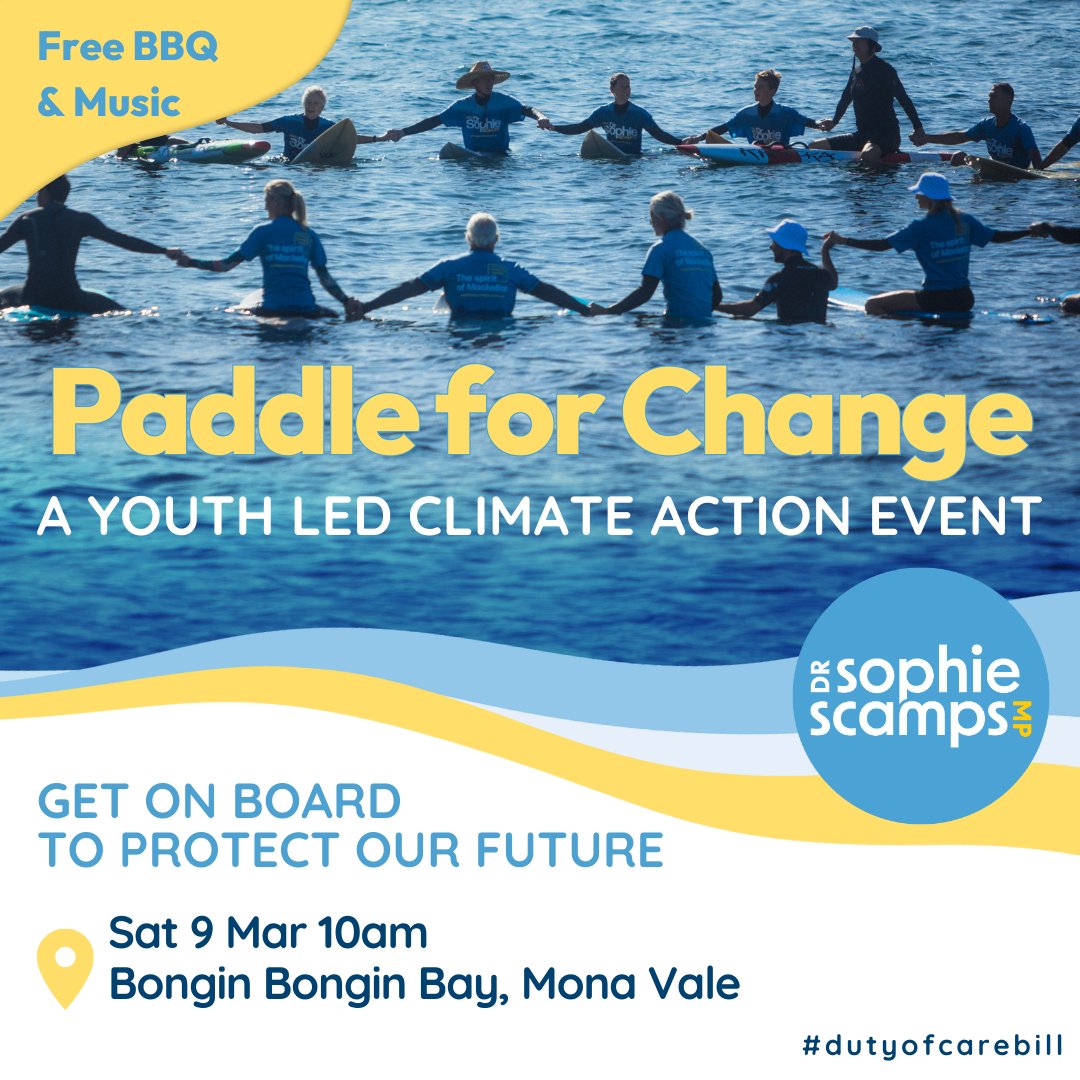
Calling All High School Student Video Makers
.jpg?timestamp=1707430256057)
Safety First As NSW Public Schools Trial New Purpose-Built AI Tool For Students
- The app is privately secured which ensures data is controlled by, and only visible to, the department. This safeguards against potential breaches of data security and privacy issues associated with the use of publicly available generative AI apps.
- Department control of NSWEduChat app means that the responses generated are aligned with NSW and Australian curriculums and the department’s values and policies.
- The app only responds to students’ questions that relate to school activities and education-related topics and uses content filtering and topic restriction. It has embedded safeguards to monitor and remove inappropriate content.
- It does not reveal full answers to students. NSWEduChat encourages critical thinking by asking guided questions and inviting students to reason on the outcome of their questions, instead of providing direct answers.
- It also provides higher-quality, more accurate support for free that is currently only available through premium-paid AI tools.
All Sydney Families To Have Access To Co-Ed Public High Schools From 2025
- enrolment trends
- public transport access, holding discussions with Transport for NSW
- capacity of the co-educational high schools
- student numbers across catchment areas
- Ashfield Boys High School
- Auburn Girls High School
- Bankstown Girls High School
- Belmore Boys High School
- Beverly Hills Girls High School
- Burwood Girls High School
- Birrong Boys High School
- Birrong Girls High School
- Canterbury Boys High School
- Canterbury Girls High School
- Granville Boys High School
- Homebush Boys High School
- James Cook Boys High School
- Moorefield Girls High School
- Punchbowl Boys High School
- Strathfield Girls High School
- Wiley Park Girls High School
School Leavers Support
- Download or explore the SLIK here to help guide Your Career.
- School Leavers Information Kit (PDF 5.2MB).
- School Leavers Information Kit (DOCX 0.9MB).
- The SLIK has also been translated into additional languages.
- Download our information booklets if you are rural, regional and remote, Aboriginal or Torres Strait Islander, or living with disability.
- Support for Regional, Rural and Remote School Leavers (PDF 2MB).
- Support for Regional, Rural and Remote School Leavers (DOCX 0.9MB).
- Support for Aboriginal and/or Torres Strait Islander School Leavers (PDF 2MB).
- Support for Aboriginal and/or Torres Strait Islander School Leavers (DOCX 1.1MB).
- Support for School Leavers with Disability (PDF 2MB).
- Support for School Leavers with Disability (DOCX 0.9MB).
- Download the Parents and Guardian’s Guide for School Leavers, which summarises the resources and information available to help you explore all the education, training, and work options available to your young person.
School Leavers Information Service
- navigate the School Leavers Information Kit (SLIK),
- access and use the Your Career website and tools; and
- find relevant support services if needed.
Word Of The Week: Unique
Noun.
1. a unique person or thing.
Adjective
1. being the only one of its kind; unlike anything else. 2. unusual or special in some way. 3. to exist in only one place, or be connected with only one person or thing
Synonyms: distinct, special, exclusive, peculiar.
From c. 1600, "single, solitary," from French unique (16c.), from Latin unicus "only, single, sole, alone of its kind," from unus "one". Meaning "forming the only one of its kind" is attested from 1610s; erroneous sense of "remarkable, uncommon" is attested from mid-19c.
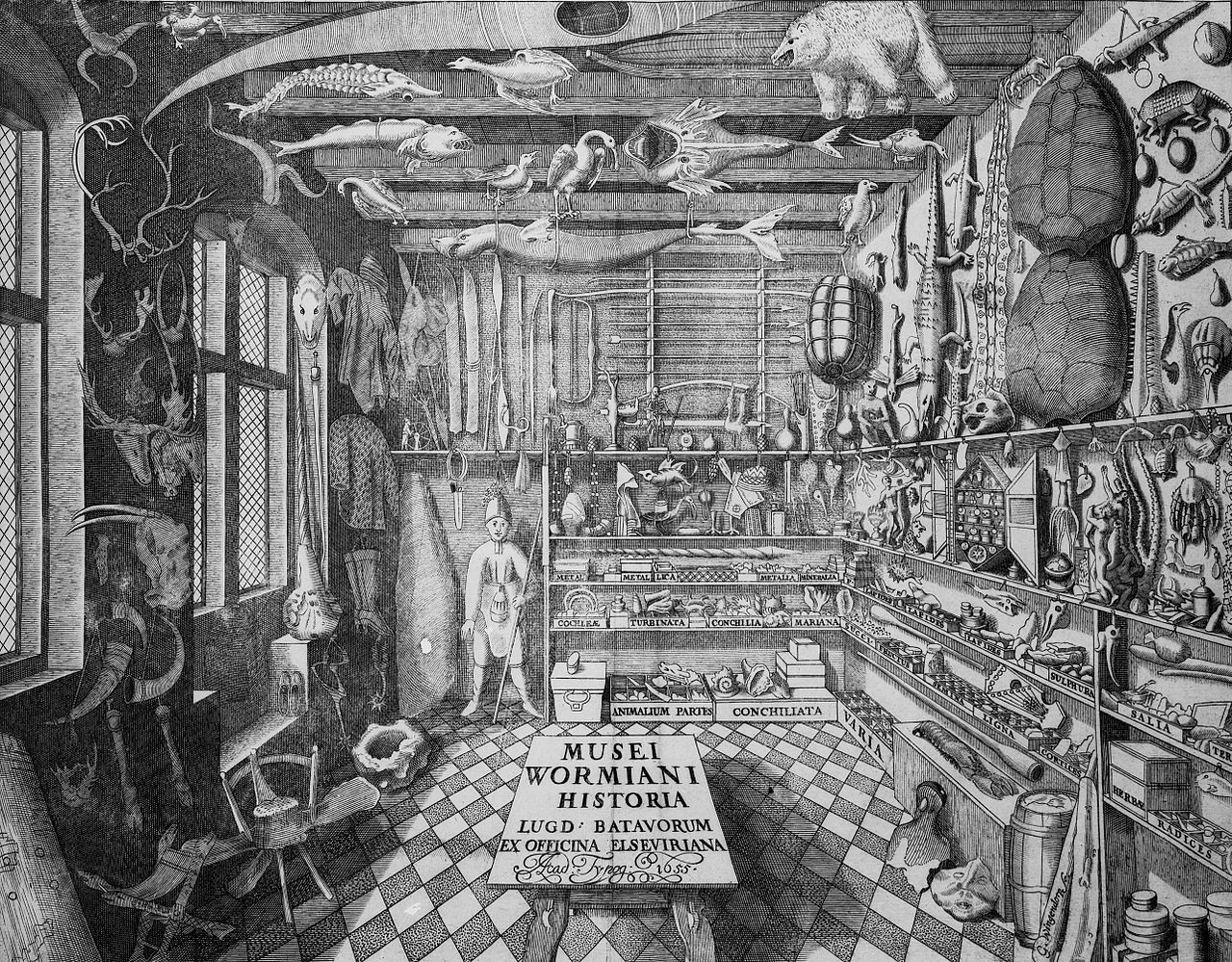
"Musei Wormiani Historia", the frontispiece from the Museum Wormianum depicting Ole Worm's cabinet of curiosities. File:Museum Wormiani Historia: 1655
Cabinets of curiosities (German: Kunstkammer and Kunstkabinett), also known as wonder-rooms (German: Wunderkammer), were encyclopaedic collections of objects whose categorical boundaries were, in Renaissance Europe, yet to be defined. Although more rudimentary collections had preceded them, the classic cabinets of curiosities emerged in the sixteenth century. The term cabinet originally described a room rather than a piece of furniture. Modern terminology would categorize the objects included as belonging to natural history (sometimes faked), geology, ethnography, archaeology, religious or historical relics, works of art (including cabinet paintings), and antiquities. In addition to the most famous and best documented cabinets of rulers and aristocrats, members of the merchant class and early practitioners of science in Europe formed collections that were precursors to museums.
Cabinets of curiosities served not only as collections to reflect the particular curiosities of their curators but also as social devices to establish and uphold rank in society. There are said to be two main types of cabinets. As R. J. W. Evans notes, there could be "the princely cabinet, serving a largely representational function, and dominated by aesthetic concerns and a marked predilection for the exotic," or the less grandiose, "the more modest collection of the humanist scholar or virtuoso, which served more practical and scientific purposes." Evans goes on to explain that "no clear distinction existed between the two categories: all collecting was marked by curiosity, shading into credulity, and by some sort of universal underlying design".
In addition to cabinets of curiosity serving as an establisher of socioeconomic status for its curator, these cabinets served as entertainment, as particularly illustrated by the proceedings of the Royal Society, whose early meetings were often a sort of open floor to any Fellow to exhibit the findings his curiosities led him to. However purely educational or investigative these exhibitions may sound, it is important to note that the Fellows in this period supported the idea of "learned entertainment," or the alignment of learning with entertainment. This was not unusual, as the Royal Society had an earlier history of a love of the marvellous. This love was often exploited by eighteenth-century natural philosophers to secure the attention of their audience during their exhibitions.
,_Kunst-_und_Rarit%C3%A4tenkammer_(1636).jpg?timestamp=1707432799412)
A corner of a cabinet, painted by Frans II Francken in 1636 reveals the range of connoisseurship of a Baroque-era virtuoso
Newly identified prehistoric pterosaur will help us understand evolution of flying reptiles
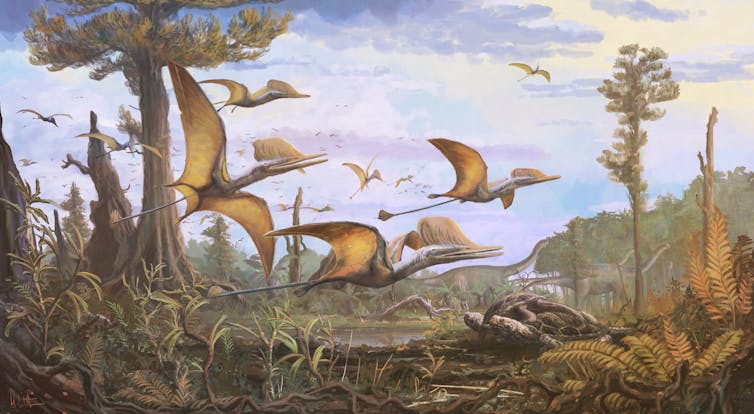
When dinosaurs roamed the land, the skies above their heads were filled with a variety of soaring reptiles, which swept through the air on slender, membranous wings. These animals, pterosaurs, were not dinosaurs but their evolutionary cousins.
We’ve just announced the discovery of a new species of pterosaur nearly 15 years after a fossil was found on the Isle of Skye. It is one of the most complete pterosaur fossils to be found in the UK since palaeontologist Mary Anning unearthed the first from the Dorset coast in 1828.
Pterosaurs were the first backboned animals to achieve powered flight (insects got there first). Pterosaur fossils are known worldwide but their remains are rare in comparison to those of their land and water-based relatives. This is due to the fragile nature of their skeletons, which are composed of thin-walled, hollow bones.
Pterosaur fossils are often incomplete, crushed and distorted. A sparse pterosaur record has been harvested from the Jurassic period (200-145 million years ago) and Cretaceous period (145-66 million years ago) rocks of the UK since Anning’s discoveries.
But most of these are limited to a few isolated bones such as Vectidraco, a toothless pterosaur whose fossilised remains were found on the Isle of Wight in 2008 by five-year-old Daisy Morris.
This is where the Isle of Skye comes in. Although Skye is most famous for the ancient volcanic landscapes of the Cuillin Hills mountain range, there are Jurassic-aged rocks around the margins of the island.
Over the past 50 years teams of geologists and palaeontologists have been gradually uncovering more of Skye’s ancient past. This work has accelerated thanks to the new imaging techniques, mainly CT scanning, which make it easier to study these fossils.
Our new pterosaur was found in 2006 by a team of researchers including Paul Barrett in a loose boulder lying on the beach at Cladach a’Glinne, on the edge of a remote bay overshadowed by the Cuillins.
At first sight, the new skeleton was an underwhelming smear of thin, broken, black bone set in a hard, dark-grey mudstone. But, even then, these thin bones suggested that the find would turn out to be interesting.
It took Lu Allington-Jones, one of the Natural History Museum’s fossil technicians, nearly two years to prepare our discovery for study. The rocks from Skye are extremely hard, and the fossil bones are delicate.
Although Lu’s work allowed us to study some of the bones, others remained encased in rock as they were too dainty to remove or expose further.
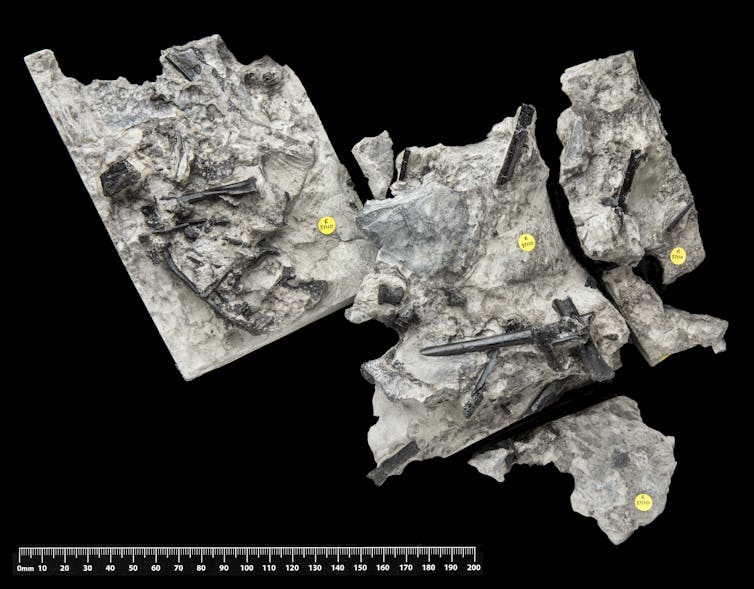
Once this work was complete, the specimen lay dormant in the museum’s collections for about nine years. But then we decided to examine the fossil using the university’s CT scanner.
Using this equipment, similar to that used in a hospital for diagnosing broken bones, with many months of careful imaging we were able to reveal almost the entire animal in three dimensions.
After comparing it with other pterosaur fossils from around the world, we realised that we were dealing with something new and we called it Ceoptera evansae (from the Gaelic name for Skye, Eilean a’ Cheò, Isle of Mist, and honouring Professor Susan Evans who has worked extensively in the area).
This pterosaur species is important because of the quality of preservation and its age. It is one of only a handful of pterosaur skeletons from the Middle Jurassic period, approximately 167 million years ago.
At this time pterosaurs were undergoing colossal anatomical changes from early small-bodied, long-tailed pterosaurs such as Dimorphodon (roughly the size of a raven) to later pterosaurs like Pteranodon which had a wingspan similar to that of a small airplane.
The lack of good pterosaur specimens from this time interval has hindered scientists’ attempts to understand how pterosaurs evolved from these earlier forms to those that dominated the skies later in Earth’s history. Ceoptera helps to fill this a gap.
For 15 years scientists have studied transitional pterosaurs that show a mix of features seen in the earlier, tailed forms and their later, giant relatives. Ceoptera is one of these transitional forms (called a Darwinopteran), one of the first members of this group known from Europe, and is the second-oldest darwinopteran worldwide.
This makes Ceoptera crucial in understanding the pace of pterosaur evolution, and it has pushed back the appearance of more advanced pterosaurs to the Early Jurassic period, about 10 million years earlier than previously thought. It brings us one step closer to understanding where and when the more advanced pterosaurs evolved.
Ceoptera‘s discovery shows how palaeontologists are making new discoveries all the time, even in places like the UK - one of the most heavily surveyed places worldwide. It also shows how new technology can is helping to unearth the mysteries of Earth’s ancient past.

Looking for something good? Cut through the noise with a carefully curated selection of the latest releases, live events and exhibitions, straight to your inbox every fortnight, on Fridays. Sign up here.![]()
Elizabeth Martin-Silverstone, Research Assistant in Palaeontology, University of Bristol and Paul Barrett, Individual Merit Researcher, Natural History Museum
This article is republished from The Conversation under a Creative Commons license. Read the original article.
Americans spend millions of dollars on Valentine’s Day roses. I calculated exactly how much
Jay L. Zagorsky, Boston UniversityFeb. 14 is Valentine’s Day – an occasion that traditionally combines romance with big business. One of the biggest businesses is selling roses, which Americans increasingly love. Back in 1989, about 1 billion cut roses were sold annually in the U.S. By 2023, that had risen to roughly 2.8 billion – enough to give every adult in the country a bouquet of 10.
As a business school professor who studies the economic impact of holidays, I wondered how much money Americans spend on roses each year while I was standing in line with two dozen red and pink ones for my sweetheart.
It’s not easy to find out. The National Retail Federation estimates people will spend US$2.6 billion on Valentine’s Day flowers, but that includes everything from azaleas to zinnias. The Society of American Florists says that 250 million roses are produced for the holiday, but it doesn’t estimate spending.
So I decided to investigate. And what I found was surprising: The roses in my hand were tied to the war on illegal drugs.
Where Are Those Roses Coming From?
Roses sold in the U.S. were once largely homegrown but are now mainly imported from South America. To learn more, I turned to the U.S. Department of Agriculture, which for decades has tracked the number of domestic farms and nurseries selling cut roses. These farms are different from nurseries growing rose bushes sold in pots to landscapers and gardeners.
Back in 1970, there were almost 800 U.S. commercial farms and nurseries growing cut roses. U.S. cut-rose growers were powerhouses, selling almost half a billion roses annually.
But since the 1970s, American cut-rose growers have withered away. The USDA’s latest Census of Horticultural Specialties found about 110 farms and nurseries growing cut roses. These farms harvested only about 18 million roses, which is quite a comedown over 50 years.
So where are roses coming from now? In 2023, the U.S. imported about 2.8 billion cut roses. The Netherlands, site of the world’s largest flower auction, isn’t the answer. Instead, cut roses sold in the U.S. primarily come from two places: Colombia and Ecuador. Colombia provides almost 60% of our roses, and Ecuador almost 40%.
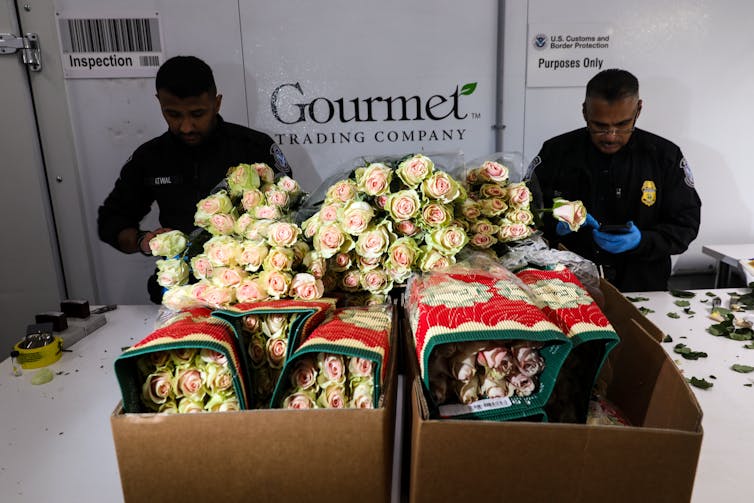
Why Colombia And Ecuador?
The shift from U.S.-grown roses to South American ones happened a few decades ago, when the U.S. and Colombian governments were looking for new ways to stem the flow of cocaine into the U.S.
One part of the strategy was to convince farmers in Colombia to stop growing coca leaves – a traditional Andean plant that provides the raw ingredient for making cocaine – by giving them preferential access to U.S. markets if they grew something else.
So, in the early 1990s, Colombia and Ecuador signed the Andean Trade Promotion and Drug Eradication Act. Signing gave these coca-producing countries duty-free access to U.S. markets in exchange for clamping down on growing illegal drugs.
Whether the act stopped drug production is unclear, but many businesses in Colombia and Ecuador started growing and shipping flowers north.
Prices For Roses
The vast quantity of roses coming up from Colombia and Ecuador has kept rose prices in check. The USDA has tracked the price of a dozen red hybrid tea roses – the ones you commonly see being offered to romantic partners on Valentine’s Day – sold in major supermarkets weekly since 2011. Back in 2011, a dozen roses would set a buyer back a bit over $10. In 2023, the same arrangement cost around two dollars more, a price increase of 20%. Inflation went up 35% over the same time, making roses comparatively cheaper.
While rose prices are low during much of the year, they have large seasonal swings. In a typical year, supermarket prices for a dozen roses double around Valentine’s Day. Last year, prices ranged from a low in August of about $8 to almost $23 before Valentine’s Day. While the USDA doesn’t track flower shop prices, visiting my local florist shows the cost of premium long-stem roses in vases is higher.
Why The Price Increase?
Prices rise around Valentine’s Day as all parts of the supply chain, from growers to wholesalers to retailers, are stressed during the buying surge.
The U.S. government tracks monthly the import price of single roses. In 2023, before Valentine’s Day, the average cut rose stem cost 40 cents coming off the cargo plane. This is higher than the annual low in August of 25 cents a stem. This means in August, roses cost wholesalers $3 a dozen, while a dozen Valentine’s Day roses cost $5 after clearing customs.
The USDA not only tracks prices in supermarkets but also wholesale flower prices in my city, Boston. Retail customers can’t buy flowers at these prices, since the flower market caters only to people in the trade. Just before Valentine’s Day 2024, Boston wholesalers were charging between $1 and $1.65 per stem of hybrid tea roses. Back in August 2023, they were selling roses for between 90 cents and $1.50 per stem. These wholesale prices suggest supermarkets don’t make much if any money selling roses most of the year, earning profits only during the peak holiday times.
While none of the sources directly answered my question on how much money Americans spent on roses each year, it’s easy to calculate a rough value. In 2023, there were around 2.8 billion cut roses sold. Given the average price in supermarkets over the whole year for a dozen roses was a bit over $12, this means people in the U.S. are spending more than $3 billion annually.
And if you’re buying roses for your sweetheart, like I did for mine, then you’re contributing to the roughly half a billion dollars worth of roses bought to say “I love you” at Valentine’s Day.![]()
Jay L. Zagorsky, Associate Professor of Markets, Public Policy and Law, Boston University
This article is republished from The Conversation under a Creative Commons license. Read the original article.
We’ve found out how earless moths use sound to defend themselves against bats – and it could give engineers new ideas
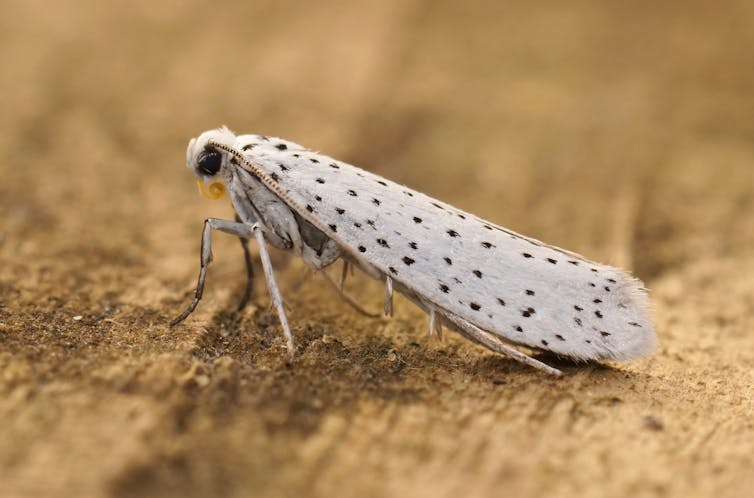
An acoustic battle between bats and their insect prey has been raging in the night skies for over 65 million years. Many different techniques are used, and our new study reveals the fascinating strategy of the small, deaf ermine moth, which has evolved a tiny wing structure that produces warning sounds. We hope this insight could inspire engineers to create new technology.
Bats count on their secret weapon, echolocation, to find and catch their flying prey, and in response, nocturnal insects have evolved interesting defences. Many silk moths, for instance, rely on a kind of sound-absorbing stealth cloak that makes them “disappear” from bat sonar. Some large moth species have evolved reflective decoys that draw bat attacks away from their body and towards the tips of their wings.
The next level of defence is ears that allow insects, including many moths, to pick up bat echolocation calls and fly out of harm’s way. They can also use their sensory awareness of location to blast an attacking bat with ultrasonic sounds that deter or confuse their biosonar.
However, scientists have long been puzzled about the many earless moths that cannot detect their predators and are too small for decoys. How do they protect themselves?
We recently discovered that even earless moths, such as ermine moths (Yponomeuta), use acoustic signals as a defence against bat attacks. These moths have a tiny structure in their hind wings which creates a powerful ultrasonic signal that jams the echolocating sonar of bats.
Because these moths don’t have hearing organs, they are not aware of their unique defence mechanism, and nor can they control it. Instead, the sound production mechanism is coupled to the flapping of their wings.
Protective Wing Beats
When we studied the ermine moth’s wing under a microscope, it became clear that one part of the wing stands out from the rest. While most of it is covered by small hairs and scales, one patch of wing is clear and located adjacent to a corrugated structure of ridges and valleys. In our new study, we found this structure produces sound perfectly tuned to confuse bats.

Sound is a pressure wave that travels through a fluid or solid and requires a displacement of this medium, usually a vibration, to produce noise. Large vibrating surfaces over cavities are good for amplifying sound – a good example is a tymbal drum, which has a taught skin stretched over a cavity. As the drum skin is struck by a drumstick, the skin vibrates at its natural frequencies and transmits these vibrations into the surrounding air as sound.
In ermine moths, the clear patch in the hind wing serves as the drum skin, while the corrugated structure of valleys and ridges act as drumsticks. During flight, the moth’s wing makes the ridges snap one after the other in a sequence. Each snap makes the clear patch, known as an aeroelastic tymbal, vibrate and amplifies the sound volume.
Recordings we made of ermine moths found their wings make clicking noises during flight, which we could detect using a bat detector that converts ultrasound into sound audible to humans.
Using 3D X-ray and a sophisticated microscope technique called confocal microscopy, our study’s lead author, Hernaldo Mendoza Nava, mapped out the intricate properties of the materials that make these moths’ aeroelastic tymbals. We then used computer simulations to test our hypothesis that the deformations of the corrugations stimulate the wing’s membrane in a way that produces sound. These simulations produced a sound that matched our recordings of the moths’ clicks in frequency, structure, amplitude and direction.
Some eared moths can make similar warning sounds, but none of them (so far) have been shown to do this with an aeroelastic tymbal.
To our team of biologists and engineers, these wing structures are fascinating because they rely on a mechanism that we teach our engineering students to avoid. “Snap through” is an example of a buckling instability – when a structure loses stability when loaded, and suddenly snaps into a different state.
In a buckling instability, the material doesn’t break but the structure usually loses stiffness and can even collapse. This can have catastrophic consequences for any structure that carries load, such as buildings, bridges and aeroplanes.
Inspired By Nature
Historically, structures were made to be rigid enough to withstand external forces. Over the last decade, researchers and engineers have started to question this default position, and have begun to use buckling instabilities to create structures with new capabilities.
One example is engineers designing morphing structures for future aircraft wings that autonomously adapt their shape to perform better when the environment changes. The aeroelastic tymbal of ermine moths embodies this concept and demonstrates how nature can be an inspiration for new technology.
Our hope is that these deaf moths’ aeroelastic tymbals will encourage new developments in engineering domains such as acoustic structural monitoring, where structures give off sound when overloaded. This is often used to check the safety of infrastructure. It could also lead to innovations in soft robotics, where the robots are made of fluids and gels instead of metal and plastics.![]()
Marc Holderied, Professor in Sensory Biology, University of Bristol; Alberto Pirrera, Professor of Nonlinear Structural Mechanics, University of Bristol, and Rainer Groh, Senior Lecturer in Digital Engineering of Structures, University of Bristol
This article is republished from The Conversation under a Creative Commons license. Read the original article.
A new generation of spaceplanes is taking advantage of the latest in technology

Nasa’s space shuttle operated in low-Earth orbit for 30 years before its retirement in 2011. However, the US space agency’s replacement for this vehicle, Orion, returned to the conical capsule design familiar from the Apollo missions. This was because Nasa intended that this newer craft be used for exploring targets in deep space, such as the Moon.
But in recent years, we have seen a return of the spaceplane design. Since 2010, the US Space Force (and formerly the US Air Force) has been launching a robotic spaceplane called the X-37B into low Earth orbit on classified missions. China has its own military spaceplane called Shenlong.
This year could see a test flight of the company Sierra Space’s Dream Chaser – the first commercial spaceplane capable of orbital flight. If all goes well, the vehicle could be used to resupply the International Space Station (ISS) with cargo and, eventually, crew.
Spaceplanes can fly or glide in the Earth’s atmosphere and land on runways rather than using parachutes to land in water or flat ground like capsules. They’re also more manoeuvrable as the spacecraft reenters the atmosphere, increasing the area of the Earth’s surface where landing is possible from a specific re-entry point.
Spaceplanes also allow a gentler but longer flight path during re-entry and a softer landing, which is easier on crew and cargo than capsules, which can land with a thump. A runway also allows ground support crews and infrastructure to be ready at the landing location.
Cost And Complexity
But spaceplanes are more complex and heavier than an equivalent capsule. The winged body shape poses a particular challenge for designing thermal protection systems (TPS) – the heat-resistant materials that protect the craft from scorching temperatures on re-entry. These additional costs mean it’s impractical to design a spaceplane for a single flight. They need to be used again and again to be viable.

There has been interest in spaceplanes from the earliest days of human spaceflight. A military spaceplane project called Dyna-Soar was started in the US in 1957, then cancelled just after construction started. The vehicle was sophisticated for its time, built using a metal alloy that is able to withstand high temperatures and featuring a heat shield on the front that could be detached after it returned from space, so that the pilot could see clearly as he was landing.
The space shuttle, which entered service in 1981, was the first operational spaceplane. It was supposed to launch more often than it did and have greater reusability but it turned out that extensive refurbishment was required between launches. It did, however, demonstrate the ability to return astronauts and large cargo from orbit.
Other space agencies invested in the 1980s and 1990s, in Europe, with the Hermes spaceplane, and Japan, with the HOPE vehicle. Both programmes were cancelled in large part because of cost. The Soviet Union developed its own shuttle-like vehicle called Buran, which successfully flew to space once in 1988. The programme was cancelled after the collapse of the Soviet Union.
Feeling The Heat
Spaceplanes have specific requirements for the final part of their journeys – as they return from space. During atmospheric re-entry, they are heated to over one thousand degrees Celsius as they travel at hypersonic speeds of over seven kilometres per second – more than 20 times the speed of sound. A blunt nose design (where the edge of the spacecraft is rounded) is an ideal shape because it reduces build-up of heat at the foremost part of the vehicle.

Even so, the expected temperatures experienced by the craft can still be as high as 1600°C, necessitating a thermal protection system on the outside of the vehicle. The space shuttle TPS included ceramic tiles that were especially heat resistant and a reinforced carbon-carbon matrix that was capable of withstanding temperatures as high as 2400°C.
The loss of the Columbia shuttle during re-entry in 2003, causing the deaths of seven astronauts, was the result of a breach in the TPS on the leading edge of the wing. This resulted from a piece of insulating foam flying off the shuttle’s external tank during Columbia’s launch and hitting the wing.
This foam issue was recurrent with the shuttle because of the way it launched on the side of the external propellant tank. But newer spaceplane designs will fly atop conventional rockets, where falling foam isn’t a problem.
An effective TPS remains vital for the future success of spaceplanes, as are systems that monitor the TPS performance in real time.
Current Vehicles
There are currently two operating spaceplanes, one Chinese and one American, that can reach orbit. Little information is available on China’s Shenlong, but the US military’s X-37B is better known. Weighing close to five tonnes at launch, the nine metre-long, uncrewed vehicle is launched using a conventional rocket and lands autonomously on a runway at the end of its mission.
The X-37B’s TPS uses tiles similar to the shuttle over the lower surface with a lower-cost alternative to reinforced carbon-carbon called Tufroc, developed for the X37B, on the nose and leading edges.
They should soon be joined by Dream Chaser, which was was developed by the company to carry both cargo and astronauts, but Nasa wants to prove its safety before carrying people by using it to carry cargo to the space station first. The ability to return comparatively fragile cargo to the surface because of a softer landing is a key capability. The tiles that protect Dream Chaser are made from silica, and each has a unique shape matched to the area on the vehicle they are designed to protect.

Future Developments
There is continued interest in spaceplanes because of their ability to return crew and cargo to a runway. The demand for this capability is limited now. But if the costs of launching to space continue falling and an expansion of industry in space raises demand, they will become an increasingly viable alternative to capsules.
Longer term, there is also potential for spaceplanes capable of reaching orbit after taking off from a runway. The challenges of developing these single-stage-to-orbit (SSTO) vehicles is considerable. However, concepts such as the Skylon vehicle are leading to technical developments that could eventually support development of an SSTO craft.
For the foreseeable future, spaceplanes look promising for the following reasons: new design techniques, improved materials for the TPS, advanced computer modelling and simulation tools for optimising different aspects of design and flight parameters and continuous improvements in propulsion systems.
Given that several governments, space agencies, and private companies worldwide are investing heavily in spaceplane research and development, we could see a future where flights with these vehicles become routine.![]()
Oluwamayokun Adetoro, Senior Lecturer, Mechanical and Aerospace Engineering, Brunel University London and James Campbell, Reader, Brunel University London
This article is republished from The Conversation under a Creative Commons license. Read the original article.
Fascination, persistence and optimism: how Fei-Fei Li helped shape the AI revolution in a field dominated by alpha males

Public debate on Artifical Intelligence has escalated in the past six months, with an outpouring of opinion pieces on the risks and ethics of a science that is undergoing an exponential period of advance.
One of the key figures in this, as a contributor to both the science and the debate, is Fei-Fei Li, Sequoia Professor of Computer Science at Stanford, and co-director of AI4All, a non-profit organisation promoting diversity and inclusion in the field of AI.
Review: The Worlds I See – Fei-Fei Li (Flatiron Books)
Aside from one controversy during her tenure as Chief Scientist for Google Cloud, involving a proposed partnership between Google and the Pentagon, Li has been something of a role model, not least because of her prominence in an area dominated by alpha-male personalities.
Free of the influence of stylists and image-makers, she comes across in interviews with the fluency of someone who wants to think their way through ideas as they arise, rather than deliver platform statements.
Li describes The Worlds I See as “a double helix memoir”. One thread is the coming-of-age of the science of AI; the other is an account of her own coming-of-age as a scientist. The personal dimension came to the fore, she says, after what was initially a “very nerdy book” was given the thumbs-down by a colleague.
Matter Becomes Mind

The story begins in Chengdu in China’s Sichuan province. As the only child of a family “in a state of quiet upheaval”, Li had a sense that her elders had been through more than they could tell. Her academically trained maternal grandparents found themselves on the wrong side of history during the Cultural Revolution. Her mother’s intellectual energies were thwarted.
As if there were some braided version of Yin and Yang in her heritage, her father’s free-spirited personality provided a complementary, if antithetical, form of influence. He was, says Li, the kind of parent a child might design for themselves if left to their own devices. He was impulse-driven, possessed of miscellaneous fascinations, which took him on excursions through the rice fields looking for butterflies, stick insects, wild rodents.
Her mother, meanwhile, was determined to escape. This ambition was realised in 1992, when the family moved to the United States. They settled in Parsippany, New Jersey, where 15-year-old Li, grappling with the demands of high school in a foreign language, demonstrated a capacity for long hours of work directed towards the academic goals her mother valued.
Her father’s fascination with natural life forms transferred to the object world of garage sales. He continued to involve Li in the practice of “studying everything in sight”.
Throughout The Worlds I See, Li reflects on the influence of this parental binary on her advancing career as a scientist. Without the fierce intellectual determination of her mother, she could not have persevered with her high school studies, given the family’s ongoing struggle for economic survival. Without her father’s childlike capacity to pay total attention to random phenomena, her research might never have found its innovative path.
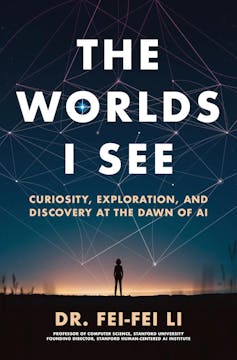
The braid of fascination and intellectual drive twists in unexpected ways. It eventually fuses into an almost visionary faith in what Li terms the North Star of her life: a vocation to shift the parameters of understanding by asking “audacious questions” of the kind pursued by the great physicists who inspire her: Albert Einstein, Roger Penrose, Erwin Schrödinger.
Her own audacious question – “what is vision about?” – came into focus by degrees. For someone given to describing her enterprise in terms of revelation and revolution, her actual research on vision seems anything but visionary.
Undergraduate study in physics and computational mathematics at Princeton yielded an opportunity for vacation work as an assistant to a neuroscience team at UC Berkeley. They were attempting to capture the neuronal responses of a cat to visual stimuli. The targeted area of the brain was probed by hairline electrodes to pick up signals.
These signals were translated first into to sound waves, then back to visual patterns from which the team were able to recompose something approximating the original image shown to the animal.
Hardly the stuff of romance, yet Li comments: “Something transcendent happens. Matter somehow becomes mind.”
What Is Data?
This insight sustains Li through her protracted labours. She becomes convinced that the principle can be applied to machine learning.
Following evidence that visual recognition in the human brain moves from the general to the increasingly specific (bird, water bird, duck, mallard), Li and her postgraduate collaborator set out to feed the computer with a comprehensive range of examples in a limited set of categories.
New image technologies in other domains came to their assistance. Google Street View identified 2,657 models of car on the road in 2014. Amazon Mechanical Turk escalated the scale and speed of their research as categories multiplied, from the original ten to thirty, a hundred, a thousand.
But the project had all the burdens that faced Charles Darwin as he attempted a comprehensive taxonomy of pigeons, or James Murray compiling the Oxford English Dictionary.
For Li, the apparently humdrum conviction that learning should be driven by data rather than algorithms arrives as “a moment of epiphany”. The audacious questions “what is vision?” and “what is intelligence?” merge. They become associated with a third question: “what is data?”
A rapid thaw in the “AI winter” of the first decade of the 21st century commenced in 2012, when research into machine learning made a breakthrough in the direction of “big data”. It was all about scaling up, increasing the retention capacities of AI to incorporate the range and complexity of phenomena in the world itself.
Li found her approach converging with that of Geoffrey Hinton, the Toronto-based cognitive psychologist often credited with spearheading the AI paradigm shift. Data can be exponentially multiplied, Hinton proposed, when machines talk among themselves. Digital agents scan diverse areas of data and exchange what they have learned to generate more sophisticated modes of correlation.
Intelligence comes to be seen not as an inherent property of a machine or a human brain, but as something out there. It arises from interactions between objects, events, beings and environments. There is more of the gatherer than the hunter in its development.
Distributed Intelligence
Distributed intelligence means distributed opportunities to participate in the co-evolution of human and machine intelligence. Big science and high technology cease to be the exclusive preserve of specialists whose modes of knowledge are beyond the understanding of ordinary people. Anyone who has had an exchange with Chat GPT on Open AI is contributing.
Li insists, however, that effective human learning requires education. The most important figure in her own education was her high-school maths teacher, Bob Sabella, who kept her on track as she struggled with the English language curriculum. He remained a friend and mentor through every stage of her academic advancement.
It is the dedicated school teacher, Li says, who is the real emblem of the future in human technology. She co-founded AI4All in 2017 with the aim of providing hands-on training for high-school students, especially girls, students of colour and those from immigrant families or low income communities. Li herself fits most of these categories.
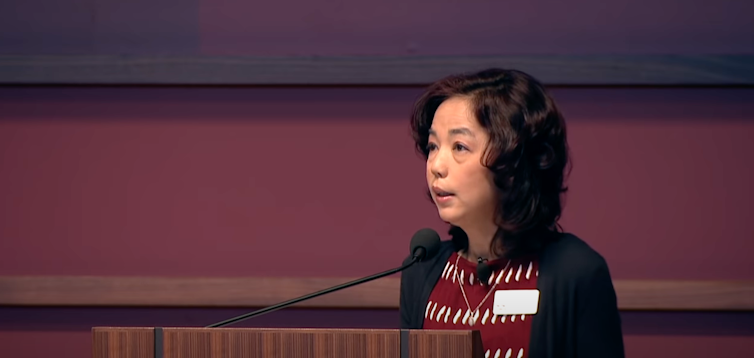
The experiences Li recounts in The Worlds I See display an extraordinary capacity for persistence in the face of obstacles. She completed high school while supplementing the family income with a $2 an hour job in a Chinese restaurant. As a graduate student, she was running the family dry-cleaning business.
Her exams at Princeton were done by special arrangement at the hospital clinic where her mother was undergoing surgery for a deteriorating cardiovascular condition.
But it is as if everything she experiences is turned to account in the pursuit of the North Star. Recurring crises in her mother’s health gave her a familiarity with hospitals, which led her to explore how AI might be deployed, not to replace the vital role of human nurses and health workers, but to support them.
If Li’s efforts can be seen as a feminist enterprise, it is perhaps because the field in which she works is dominated by male celebrities, who persist in seeing the future as a Darwinian struggle between human and machine intelligence.
“Which is smarter?” is less an audacious question than one that needs to be consigned to the dustbin of history. Speaking in 2018 to a Congressional hearing on Power and Responsibility in the application of advanced technologies, Li said:
There’s nothing artificial about AI. It’s inspired by people, created by people, and most importantly it has an impact on people.
Explicitly distancing herself from those, like Hinton, who are seeing the current breakthrough in AI potential as an existential crisis, Li is concerned with tangible social risks, and specific ways to address them.
In a recent discussion with former US Secretary of State Condoleezza Rice, now Head of the Hoover Institution at Stanford, Li expressed her belief that policy intervention can install the important safeguards in areas where the impact of AI is likely to be greatest.
These include its benign potential in health and education, as well as the dangers opening up through disinformation, the loss of privacy and the replacement of human work.
If there is an overriding theme in The Worlds I See, it is that human and artificial intelligence form a double helix. How this evolves, and with what consequences, will depend, Li says, on whether we create “a healthy ecosystem” in which talent, technology and public sector participation are co-ordinated.![]()
Jane Goodall, Emeritus Professor, Writing and Society Research Centre, Western Sydney University
This article is republished from The Conversation under a Creative Commons license. Read the original article.
Smartphones mean we’re always available to our bosses. ‘Right to disconnect’ laws are a necessary fix
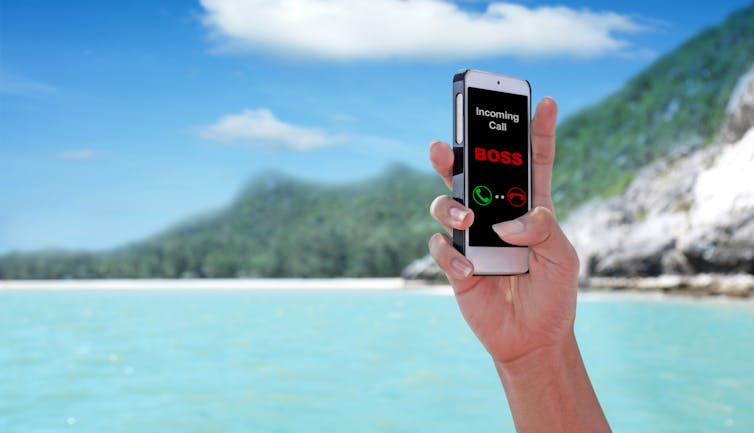
Australian workers are set to have the right to disconnect from their workplaces once they clock off for the day.
This will “empower workers to ignore work calls and emails after hours [from their employers], where those demands are unreasonable”, according to Greens Senator Barbara Pocock who has been driving the change.
Last week, the Senate committee reviewing the “Closing Loopholes” amendments to the Fair Work Act recommended introducing a right to disconnect to support “the development of clear expectations about contact and availability in workplaces”. On Wednesday, the Albanese government indicated it supported the amendment.
Why A Right To Disconnect Is Needed
Last year, the Senate Select Committee on Work and Care drew attention to “availability creep” where employees are increasingly expected to complete work outside of work hours.
Smartphones have made it easier for managers to contact workers any time. The shift to remote working during the COVID pandemic caused the boundaries between work and personal life to disintegrate further.
According to a 2022 report by the Centre for Future Work, 71% of workers surveyed had worked outside their scheduled work hours often due to overwork or pressure from managers.
This led to increased tiredness, stress or anxiety for about one-third of workers surveyed, disrupted relationships and personal lives for more than one-quarter, and lower job motivation and satisfaction for around one-fifth.
Parliamentary inquiries have highlighted the negative consequences of working outside scheduled hours for mental and physical health, productivity and turnover.

Availability creep has led to significant unpaid overtime which “takes workers away from a fair day’s work for a fair day’s pay”.
The impacts are especially acute for certain groups of workers. Those on insecure contracts lack the power to resist availability creep. Those with unpaid care responsibilities are likely to experience intensified work/life balance.
“Roster Justice”
The right to disconnect provides a solution to these challenges. The Senate select committee on work and care found such a right can provide workers with “roster justice” by giving more certainty over their working hours.
Many countries in Europe, Asia, North America and South America have already established laws or regulations limiting employers contacting workers outside work hours.
At least 56 enterprise agreements currently operating in Australia provide a right to disconnect. This includes agreements covering teachers, police officers and various banks and financial institutions.
Industrial Relations Minister Tony Burke has indicated the right to disconnect legislation will provide employers with “reasonable grounds” to contact their employees outside work hours. This might include calling employees to see if they can fill a shift.

If enterprise agreements with existing right to disconnect clauses are an indication, the Fair Work Commission will probably be asked to determine what contact outside of work hours is deemed “reasonable”. This approach seems sensible given the long tradition of the commission being asked to rule on what’s “reasonable” in other areas of employment law.
If an employer “unreasonably” expects employees to perform unpaid work outside of normal hours the commission may be empowered to impose a “stop order” — and potentially fines — to prevent the employer from contacting employees outside hours according to Tony Burke.
Unions including those representing teachers and police officers support a right to disconnect. According to the Police Federation of Australia:
Not only do the police see that trauma, deal with the families’ trauma, deal with their colleagues’ trauma, have to investigate, have to go to court, and get media attention but they also have to go home and deal with their families […] The right to disconnect gives those officers that little bit of breathing space.
Employment law experts and human resource specialists also believe there is a strong case for such a right given the negative impacts of availability creep on worker well being.
Employer associations are less supportive. The Australian Chamber of Commerce and Industry (ACCI) told a recent a Senate inquiry a right to disconnect would be “a blunt instrument which will do more harm than good, including for employees”. They claim employers will be less accommodating of employee requests for flexible work arrangements during normal work hours if contact outside these hours is no longer allowed.
A Banana Republic?
According to ACCI chief executive Andrew McKellar, a right to disconnect would be “the final step in Australia becoming a banana republic”.
But it must be remembered that workers effectively had the right to disconnect before the smartphone. Such a protection needs to be explicit now technology has eroded the once-firm boundaries between work and home.
As the nature of work and employer practices change, it’s essential for employment regulations to respond accordingly. Having a right to disconnect to protect workers from employers encroaching upon their free-time is a necessary response.![]()
Chris F. Wright, Associate Professor of Work and Organisational Studies, University of Sydney
This article is republished from The Conversation under a Creative Commons license. Read the original article.
Why Heartstopper is Gen Z’s defining publishing phenomenon
Penni Russon, Monash UniversityWhen Volume 5 of Heartstopper, Alice Oseman’s graphic novel series (turned Netflix adaptation, turned cultural juggernaut) was published in December last year, the book was declared an instant number-one bestseller. In Australia alone, it sold 12,300 copies in its first week.
To every generation a publishing phenomenon is born – and for Generation Z, it’s Heartstopper, which Oseman started writing aged 22 (she’s still just 29).
The rise of Heartstopper reads like a history of the last ten years in publishing tools and platforms. Oseman started self-publishing the comics on microblogging site Tumblr and webtoon platform Tapas in 2016, building up a loyal following and clocking millions of views.
Crowdfunding for the first print run met the funding goal within two hours. Hachette Children’s Group picked up world rights for the series, publishing Volume One in 2019.
To date, five graphic novels, two novellas, a yearbook and a colouring book have been published. The graphic novels have also been adapted into a successful Netflix series, with scripts written by Oseman herself.

Heartstopper follows the sweet friends-to-lovers arc of Charlie and Nick, whom we first meet in Year 10 and Year 11. It depicts the giddying highs and dizzying lows of being young, queer and in love.
Through Charlie, Nick and other well-drawn characters, Alice Oseman beautifully portrays the inner workings of a healthy relationship, modelling open communication, help-seeking, allyship and active consent. The books also touch on rarely discussed topics like male eating disorders.
Queer Joy
Queer joy is defined by Oxfam as a positive feeling we get from encountering signs of progress in gender equality and gender diversity. In the Heartstopper series, the narrative engine runs on themes of love, identity, first times, self-discovery, friendship and allyship.

When we meet Charlie in Volume 1, he’s been out at his school as gay for a while. He mentions past bullying and there are moments of homophobia, but largely Charlie is accepted at school. Charlie’s friend Elle has transitioned their gender and has been enrolled into the girls’ school across the road. There’s never any suggestion this has been met with resistance or nastiness.
Of course, not everything comes easily to Charlie and Nick. The shadow side of the themes of love, connection and community includes mental ill-health, body dysmorphia, trauma, family conflict and bullying.
Nick’s brother, David, takes every opportunity to shame Nick for being gay, while Nick’s father is an absent parent. Meanwhile, trauma from Charlie’s past, including bullying and his toxic, closeted ex Ben’s coercive behaviour, has had some heavy impacts.
Charlie confesses to Nick that he used to self-harm, and Nick observes some worrying behaviour in Charlie in terms of food avoidance and anxiety. Nick talks to his mother who tells him, “Love can’t cure a mental illness”, and gives some practical advice: listen, talk, ask him what he needs, stand by him, but don’t try to take it on by yourself.
Nick encourages Charlie to seek help. After some reluctance, Charlie talks to his parents. He is diagnosed with obsessive compulsive disorder (OCD) and anorexia and is admitted to a residential treatment program. As assistant professor of psychology Vivienne Lewis has noted, eating disorders in boys and men are underrepresented in media and little understood in the community, so Alice Oseman is breaking important ground here.
‘Felt Gaps’: The Magic Of Comics
Comics have a tumultuous history, especially for children. In 1953, in his book Seduction of the Innocent, Frederic Wertham argued comics inhibit literacy, and called them “death on reading”. But the opposite seems to be true.
Comics and graphic novels are, for some kids at least, the gateway to a passion for books. For already engaged readers, it’s a way to diversify their reading and develop their visual literacy. English teacher Matt McCabe points out that while comics can be read and understood comparatively quickly, they can be “studied multiple times from different angles”, making them suited to readers of all abilities.
Reading comics calls on a heightened awareness of the senses to make sense of the unfolding world within. Some of the magic of comics occurs in the gutter: the space between panels. The comics medium is also known for its disjuncture of word and image. These “felt gaps” prompt the reader to harness their imagination and life experience.
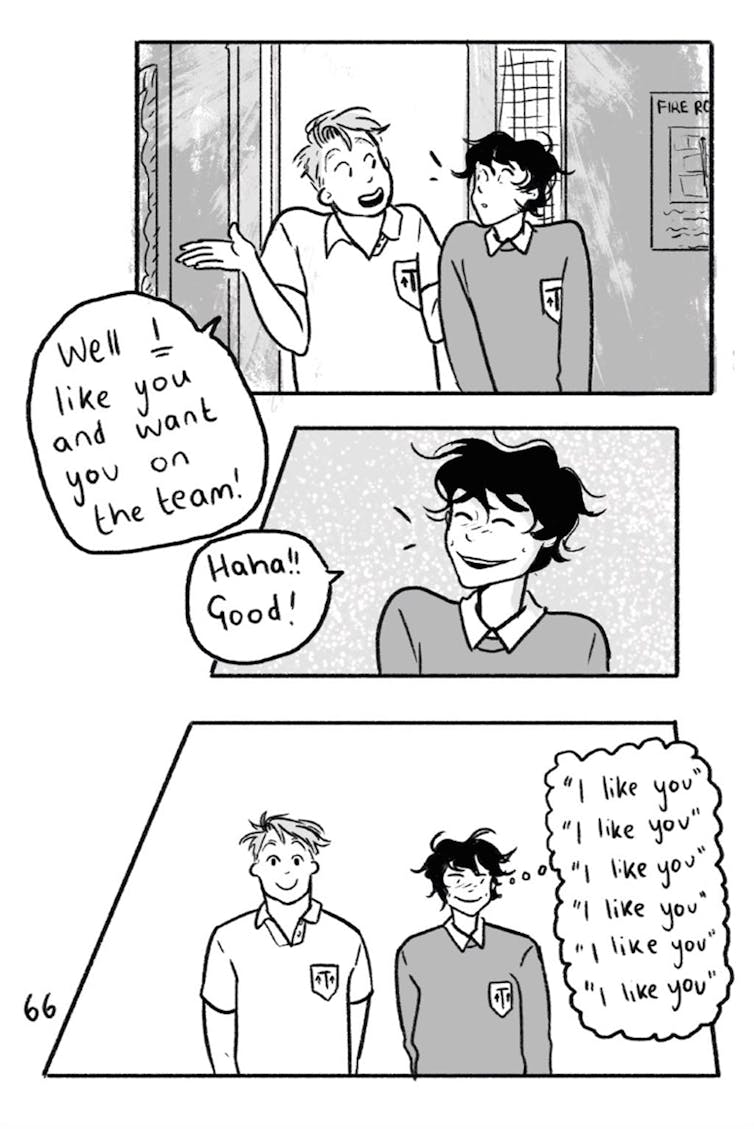
Because comics can show and tell two things at once, they are particularly good at representing the way identities are formed in relation to society and culture. There’s a scene in Volume 1 where Nick turns to Google to ask, “Am I gay?” Google searches like these have become a rite of passage for young Gen Zs, who are much more likely than older generations to identify as queer.
An examination of Google trends from 2004 to 2023 highlights a steep rise in queries about sexuality, with such searches surging over 1,300%. Alice Oseman uses jagged panels and fragmentation to show Nick’s worldview exploding as he comes to terms with this new information about himself, in the fractured environment of a Google search response page.
Heartstopper Volume 5
By Heartstopper Volume 5, Nick is out to family and friends and Charlie is home and in therapy, but generally well. Charlie and Nick are in an established relationship, thinking about taking things to the next level.
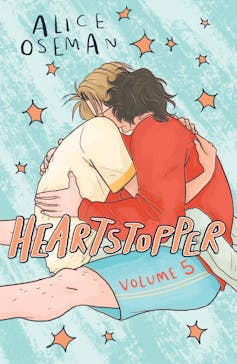
They are surrounded by a supportive and diverse group of friends, including a trans girl, another gay boy who is not interested in coming out, Charlie’s asexual sister, and a lesbian couple, reflecting a spectrum of LGBTQ+ experiences many kids would encounter in their own social milieu.
There is a subplot of two male teachers falling in love. One of these teachers encourages Charlie to consider running for Head Boy. (We’ll have to read Volume 6 to find out if he’s successful!)
Heartstopper Volume 5 focuses a lot on Nick who, as a final-year student, needs to make a decision about university. Initially he assumes he’ll go to the closest one, to stay near Charlie. Two friends, also facing this decision, accompany Nick on a road trip to visit campuses elsewhere, and gently encourage him to explore other options.
Alice Oseman handles with delicacy the fact that as high-school sweethearts, their paths may take them in different directions – and that only through supporting each other to grow will they both thrive.
Another important plot point involves discussions about sexual readiness, with both boys talking to each other and their friends about recognising when you might be ready for sex. The conversations demonstrate nuances of active consent and communication, and stand in stark contrast to Ben’s entitlement and aggression in Volume 1. A conversation in class shows not all young people are ready for sex –and that’s normalised too.
Normalising Queer Love
In Heartstopper, the representations of mental illness, trans identities and queer love are destigmatising and normalising. Charlie’s queer and quirky friendship group reminds me of the young people who trail in and out of my house on a regular basis. (My oldest daughter ran the queer club at her school, my middle child is non-binary.)
The depiction of Charlie’s OCD and anorexia as a result of past trauma is carefully optimistic, showing a fairly linear pathway from help-seeking to effective treatment. Oseman acknowledges, through Nick, that isn’t always the case:
Staying in a hospital was a big risk. It probably isn’t helpful for everyone. But it was for him. He could actually focus on his mental health without worrying about school and what everyone thought.
Oseman uses the comic form to alleviate the intensity, avoiding details about self-harm and restrictive eating, and never showing anything graphic.

The message when it comes to mental health is that it takes a village to treat mental illness (siblings, parents, friends, clinicians, teachers).
Some readers, especially those of us who grew up in earlier decades, might feel sad or angry when they compare their school experiences to what’s shown in Heartstopper. Some who experienced the bullying but not the friendships in high school may struggle to believe kids can be this kind to each other.
For me, though, this is the queer joy of reading Heartstopper. In its focus on the love and community that surrounds Charlie and Nick, the Heartstopper graphic novels create a space for the reader, who becomes an intimate confidante – another member of Charlie and Nick’s tight-knit friendship group.![]()
Penni Russon, Senior Lecturer, School of Communication, Monash University
This article is republished from The Conversation under a Creative Commons license. Read the original article.
Hidden women of history: Saint Perpetua, a young mother put to death in a Roman amphitheatre
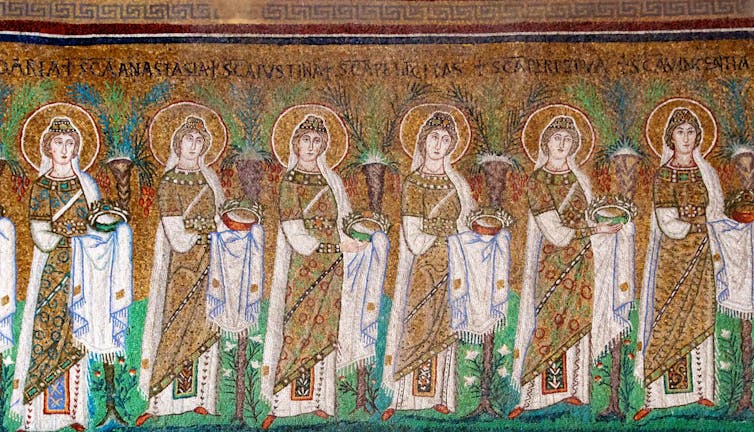
In 203 CE, a young, African Christian woman named Vibia Perpetua was executed in a brutal fashion.
She and her fellow Christians were taken to the amphitheatre of Carthage (now in Tunisia), where they were grievously wounded by wild beasts before their throats were slit by gladiators. This horrific scene formed part of the celebrations for the birthday of Caesar Geta, the son of the emperor Septimius Severus.
The Roman imperial state did not engage in a systematic, empire-wide persecution of Christians in the early third century. However, many believers like Perpetua were denounced to local officials, who put them in prison. They were executed when they refused to make religious offerings to the Roman gods and emperors.
The tales of early Christian suffering are recounted in texts known as hagiographies, or accounts of saints’ lives. Perpetua’s tale stands out among these works because she may have written much of it herself.
Still Breastfeeding When Jailed
The Latin text of the Passion of Saints Perpetua and Felicitas was discovered at the Italian monastery of Monte Cassino in the 17th century. Most of it is written by an unknown narrator, who recounts the suffering of Perpetua and her fellow martyrs so that other Christians might learn from their experiences.
However, eight chapters are written in the first person singular. The narrator states these chapters are the work of Perpetua herself “just as she wrote with her own hand and according to her own perception”.
The narrator tells us Perpetua came from a respectable family, was educated and in her early twenties when she died. Her parents were still living. The Latin used to describe Perpetua’s family and upbringing indicates they were wealthy Roman citizens.
Perpetua was married and had a baby boy. She was still breastfeeding when jailed. Yet her husband is not otherwise mentioned and it would be very unusual for a wealthy woman to be nursing her own baby. This suggests Perpetua may well have been of much lower status than the narrator assumed.
Perpetua’s account begins after she and four other Christians, including the enslaved woman Felicitas, have been arrested by Roman authorities.
Across the eight chapters, Perpetua describes her relationship with family members, her father’s attempts to convince her to renounce her faith, the visions she had in prison and her treatment by Roman soldiers and officials. The final part of the tale, which includes the execution scenes described above, is told by the narrator.
Perpetua’s style is straightforward (but not uneducated), her narrative sometimes detailed, at other times frustratingly vague. Above all, it is deeply touching.
‘I Was Tormented By Concern For My Baby’
Despite being aware her Christian faith will lead to her death, separating her from her child, Perpetua expresses a deep bond with her son. “I was tormented by concern for my baby”, she writes of her initial incarceration.
She is later allowed to suckle her baby, who had been “weak with hunger” without his mother. She is even given permission to keep the boy with her. The presence of the child meant that,
prison was immediately transformed into a palace for me, so that I preferred to be there than anywhere else.
After Perpetua and her fellow Christians are sentenced to die in the amphitheatre, she is filled with anguish for her child. But God intervenes.
And just as God willed it, the baby no longer wanted my breasts nor did they cause me pain, so that I was not tortured by worry for my son nor by aching in my breasts.
In Her Own Words?
But are they her words? Perpetua’s story was known to the African Christian intellectual Tertullian, who mentions her martyrdom in his book On the Soul, written five to ten years after her execution. This proves there was a Perpetua, but not that she was the author of these eight chapters.
Some sceptics point to the difficulty of obtaining writing materials in prison. Others observe that many martyr accounts make ambitious claims to be authentic, eyewitness narratives.
One important argument against such scepticism is the style of Perpetua’s Latin is quite different from the narrator’s. This could be the work of a clever male author changing his style to fit different voices, much like a modern-day novelist writing a story from different perspectives.
But as Perpetua’s narrative so aptly and movingly captures the female experience, the scale tips towards authenticity.
Children And Holy Women
The degree of Perpetua’s concern for and interaction with her child is unusual in accounts of Christian holy women. For example, Melania the Younger, who lived in Rome in the fifth century CE, desired to become an ascetic, which meant she needed to renounce all worldly ties, including her family.
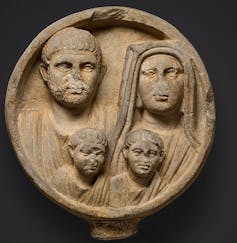

When Melania’s two children died young, she interpreted this as God’s endorsement of her desire to reject the conventions of Roman marriage and motherhood.
Another fifth century woman, Matrona, who aspired to a religious life in Constantinople, even abandoned her family and disguised herself as a man in order to enter a monastery. Matrona entrusted her little girl to another Christian woman to raise as her own.
This echoes the story of the enslaved woman Felicitas, whom the narrator says was eight months pregnant when arrested with Perpetua. We do not have Felicitas’ own words, but we are told she was worried her execution and martyrdom would be delayed because of her pregnancy.
After the other Christian prisoners pray she will go into premature labour so she might die alongside them, Felicitas gives birth to a little girl, whom she entrusts to a member of the African Christian community. Perpetua’s own son was left in the care of her family.
Some Christian women rejected motherhood in favour of devoting themselves exclusively to their faith, either through martyrdom or asceticism, while others engaged in child-rearing for the good of the larger community.
Family Ties
Perpetua’s tale develops this theme of Christian communities. In many early Christian texts, it is a woman’s husband who poses an obstacle to the holy path she has chosen, but in Perpetua’s narrative, it is her father.
She writes that her father was so worked up by the word “Christian” that “he launched himself towards me in order to tear out my eyes”, before thinking better of it and withdrawing.
When she is arrested, Perpetua writes,
I gave thanks to the lord because my father was not present, and I was refreshed by his absence.

The father makes two further appearances in the narrative, showing his growing desperation. Visiting Perpetua in prison, he kisses her hands and prostrates himself before her feet, begging her to consider her family’s reputation. This is a typical theme of Christian hagiography, since the hero or heroine’s journey represents a rejection of the futures their family had planned for them.
He then confronts her during a public trial in the forum, brandishing her baby son while imploring Perpetua to make offerings to the Roman gods for the safety of the emperors and thus save herself.
In response, the Roman governor orders the old man to be flogged. She writes:
I grieved for my father’s situation as if it were me who had been beaten, I grieved for him in his wretched elderly state.
Perpetua’s journey from fearing to pitying her father draws her closer to her Christian brothers and sisters, preparing her for the martyrdom that awaits. The idea of a “spiritual family” coming to take the place of a “natal family” is found throughout early Christian texts.
And yet the attention Perpetua’s account gives to her family and their suffering is unusual. She dwells on her concern for her son and father; her anxiety about her mother and brother and memories of another brother who died of cancer as a child.
It may be that this, less stylised, element of the text also reflects Perpetua’s own voice. We rarely receive such insights from hagiographies.
Perpetua’s Legacy
The tale of Perpetua and her fellow martyrs grew in popularity in subsequent centuries. While Perpetua does not even mention Felicitas in her first-person narrative, the women became inseparable in the Christian tradition.
They were venerated in Rome by the mid-fourth century. The writings of Saint Augustine show the Passion was read out in North African churches on their feast day (March 7).
In addition to the famous Latin text, there is also a Greek version. It probably dates to the fifth or sixth century CE, but was not known to scholars until the late 19th century, when it was discovered in Jerusalem. Since it was very rare to translate Latin texts into Greek, this shows Perpetua’s story was considered to be so important it needed to be made accessible to the Greek-speaking communities of the eastern empire.
There are also shorter, fifth-century accounts known as Acts, which abandon the first-person narrative and instead include a detailed dialogue between the Christians and the Roman governor of Africa.
The Acts rewrite the narrative in various ways, providing Perpetua with a husband who appears at her trial along with other members of the family. Perpetua reassures her father that devoting herself to Christ and his glory is the only way that she will truly be a “perpetual daughter”.
Perpetua lives today not only through Christian veneration as a saint, but through this moving first-person account. This allows us to understand the motivations and sufferings of an African woman who lived almost 2,000 years ago.![]()
Caillan Davenport, Associate Professor of Classics and Head of the Centre for Classical Studies, Australian National University and Meaghan McEvoy, Senior Lecturer in History, Australian National University
This article is republished from The Conversation under a Creative Commons license. Read the original article.
A 380-million-year old predatory fish from Central Australia is finally named after decades of digging

More than 380 million years ago, a sleek, air-breathing predatory fish patrolled the rivers of central Australia. Today, the sediments of those rivers are outcrops of red sandstone in the remote outback.
Our new paper, published in the Journal of Vertebrate Paleontology, describes the fossils of this fish, which we have named Harajicadectes zhumini.
Known from at least 17 fossil specimens, Harajicadectes is the first reasonably complete bony fish found from Devonian rocks in central Australia. It has also proven to be a most unusual animal.
Meet The Biter
The name means “Min Zhu’s Harajica-biter”, after the location where its fossils were found, its presumed predatory habits, and in honour of eminent Chinese palaeontologist Min Zhu, who has made many contributions to early vertebrate research.
Harajicadectes was a fish in the Tetrapodomorpha group. This group had strongly built paired fins and usually only a single pair of external nostrils.
Tetrapodomorph fish from the Devonian period (359–419 million years ago) have long been of great interest to science. They include the forerunners of modern tetrapods – animals with backbones and limbs such as amphibians, reptiles, birds and mammals.
For example, recent fossil discoveries show fingers and toes arose in this group.
Devonian fossil sites in northwestern and eastern Australia have produced many spectacular discoveries of early tetrapodomorphs.
But until our discovery, the poorly sampled interior of the continent had only offered tantalising fossil fragments.
A Long Road To Discovery
Our species description is the culmination of 50 years of tireless exploration and research.
Palaeontologist Gavin Young from the Australian National University made the initial discoveries in 1973 while exploring the Middle-Late Devonian Harajica Sandstone on Luritja/Arrernte country, more than 150 kilometres west of Alice Springs (Mparntwe).
Packed within red sandstone blocks on a remote hilltop were hundreds of fossil fishes. The vast majority of them were small Bothriolepis – a type of widespread prehistoric fish known as a placoderm, covered in box-like armour.
Scattered among them were fragments of other fishes. These included a lungfish known as Harajicadipterus youngi, named in honour of Gavin Young and his years of work on material from Harajica.
There were also spines from acanthodians (small, vaguely shark-like fish), the plates of phyllolepids (extremely flat placoderms) and, most intriguingly, jaw fragments of a previously unknown tetrapodomorph.

Many more partial specimens of this Harajica tetrapodomorph were collected in 1991, including some by the late palaeontologist Alex Ritchie.
There were early attempts at figuring out the species, but this proved troublesome. Then, our Flinders University expedition to the site in 2016 yielded the first almost complete fossil of this animal.
This beautiful specimen demonstrated that all the isolated bits and pieces collected over the years belonged to a single new type of fish. It is now in the collections of the Museum and Art Gallery of the Northern Territory, serving as the type specimen of Harajicadectes.

A Strange Apex Predator
Up to 40 centimetres long, Harajicadectes is the biggest fish found in the Harajica rocks. Likely the top predator of those ancient rivers, its big mouth was lined with closely-packed sharp teeth alongside larger, widely spaced triangular fangs.
It seems to have combined anatomical traits from different tetrapodomorph lineages via convergent evolution (when different creatures evolve similar features independently). An example of this are the patterns of bones in its skull and scales. Exactly where it sits among its closest relatives is difficult to resolve.

The most striking and perhaps most important features are the two huge openings on the top of the skull called spiracles. These typically only appear as minute slits in most early bony fishes.
Similar giant spiracles also appear in Gogonasus, a marine tetrapodomorph from the famous Late Devonian Gogo Formation of Western Australia. (It doesn’t appear to be an immediate relative of Harajicadectes.)
They are also seen in the unrelated Pickeringius, an early ray-finned fish that was also at Gogo.
The Earliest Air-Breathers?
Other Devonian animals that sported such spiracles were the famous elpistostegalians – freshwater tetrapodomorphs from the Northern Hemisphere such as Elpistostege and Tiktaalik.
These animals were extremely close to the ancestry of limbed vertebrates. So, enlarged spiracles seem to have arisen independently in at least four separate lineages of Devonian fishes.

The only living fishes with similar structures are bichirs, African ray-finned fishes that live in shallow floodplains and estuaries. It was recently confirmed they draw surface air through their spiracles to aid survival in oxygen-poor waters.
That these structures appeared roughly simultaneously in four Devonian lineages provides a fossil “signal” for scientists attempting to reconstruct atmospheric conditions in the distant past.
It could help us uncover the evolution of air breathing in backboned animals.![]()
Brian Choo, Postdoctoral fellow in vertebrate palaeontology, Flinders University; Alice Clement, Research Associate in the College of Science and Engineering, Flinders University, and John Long, Strategic Professor in Palaeontology, Flinders University
This article is republished from The Conversation under a Creative Commons license. Read the original article.
Ice ages were not as dry as we thought, according to surprising new Australian cave study
Rieneke Weij, University of Cape Town; Jon Woodhead; Josephine Brown, The University of Melbourne; Kale Sniderman, The University of Melbourne, and Liz Reed, University of AdelaideDuring ice ages, dry, frozen terrain extended over much of northern Europe, Asia and North America. Many plants and animals retreated from these desolate, harsh landscapes and sought refuge in pockets of more hospitable territory.
But what was happening in the rest of the world? For a long time scientists have thought that dry conditions prevailed across the globe during ice ages, and that the warm periods between ice ages were much wetter.
This interpretation has shaped our understanding of where plants, animals, and even humans lived during Earth’s past. However, it may not be correct.
Our new research published in Nature shows ice ages were actually much wetter than previously thought – at least in the subtropical regions of the southern hemisphere (from 20° to 40° south).
Ice Ages And Hemispheres

Over the past million years or so, Earth’s climate has oscillated between cold ice ages (or “glacial” periods) and warmer “interglacial” periods. Currently we are living through an interglacial period known as the Holocene epoch. It began about 11,700 years ago, following the last glacial period which lasted around 110,000 years.
During glacial periods, temperatures were lower, there was less carbon dioxide in the atmosphere, and ice sheets covered more of the globe. During interglacials, temperatures were higher, there was more carbon dioxide in the air, and large ice sheets remained only in Greenland and Antarctica.
Evidence from the northern hemisphere shows huge ice sheets spread across the northern parts of Europe, northern Asia and North America during glacial periods, and large areas south of the ice were covered with tundra. The idea that glacial environments were extreme and harsh was then extended beyond these regions because of evidence that glacial periods were mostly treeless with dusty atmospheres pretty much everywhere, including Australia.
However, our new research reveals that parts of glacial periods were in fact wetter than today across much of the southern hemisphere.
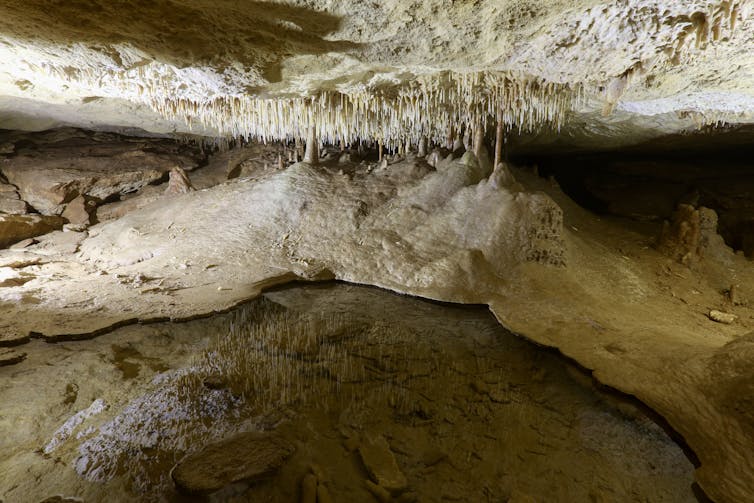
Developing A 350,000 Year Climate Record
One way to understand how wet it was in the past is to look at mineral deposits called speleothems, found in underground caves. These deposits, which include stalagmites and stalactites, build up over time as rainwater filters down through soil and limestone into the cave.
We can use the extent of speleothem growth over time to understand changes in water availability. More speleothem growth broadly reflects wetter conditions, while less growth suggests a drier environment.
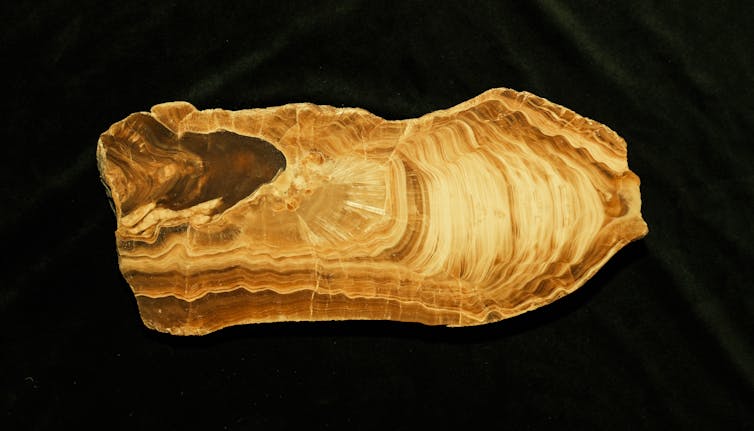
Our understanding of past changes in the climate and environment of the southern hemisphere has been limited by a lack of well-dated and long-term records.
To address this problem, we collected samples from speleothems in two cave regions in southern Australia, the Naracoorte caves in the southeast and the Leeuwin-Naturaliste caves in the southwest.
Using a dating technique based on the decay of naturally occuring uranium, we determined the age of more than 300 individual speleothem fragments from the caves. As a result, we produced a precipitation record spanning the last 350,000 years.
Wetter And Colder, Warmer And Drier
Our study revealed surprising yet extremely consistent trends. Over the past 350,000 years, wetter times always occurred within the cooler, glacial periods, while interglacials were consistently dry.
We also studied fossil pollen trapped within the same speleothems. It is harder to be a tree under the low atmospheric carbon dioxide of glacial periods, but moisture-demanding herbs and shrubs thrived during the glacial periods but were suppressed during interglacials, confirming the dating evidence.
Next, we used our new records from southern Australia as benchmarks for the subtropics around the southern hemisphere, and compared them with other published records from southern Africa and South America. We found wet glacials and dry interglacials were not confined to southern Australia, but in fact, formed a hemisphere-wide pattern.
Climate model simulations also showed a similar pattern over the last glacial cycle.
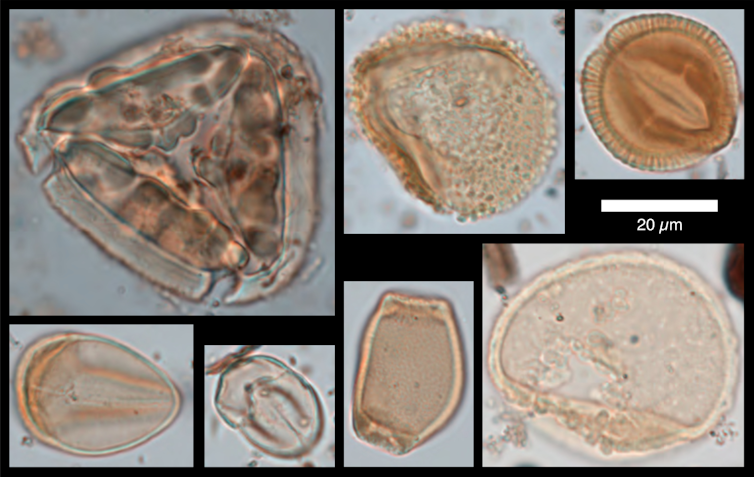
Stable Environments With Abundant Water
This new understanding of what conditions were like in the southern hemisphere during glacial periods will change how we interpret the movement and expansion of plants, animals and even humans in the past.
It was previously assumed that, during glacial periods, reduced rainfall forced many plants and animals that needed higher levels of moisture into small liveable zones called “refugia”.
However, our research suggests that – at least in the subtropical southern hemisphere – glacial periods were often times of relatively stable environments with abundant water, even if low levels of carbon dioxide meant plants were slow-growing and relatively unproductive.
Our research calls for a big paradigm shift in how we view past ice-age environments across the Earth.![]()
Rieneke Weij, Postdoctoral researcher in Geochemistry/Palaeoclimatology, University of Cape Town; Jon Woodhead, Professor emeritus, The University of Melbourne; Josephine Brown, Senior Lecturer, The University of Melbourne; Kale Sniderman, Honorary Research Fellow, The University of Melbourne, and Liz Reed, Senior Lecturer, School of Biological Sciences, University of Adelaide
This article is republished from The Conversation under a Creative Commons license. Read the original article.
George Gershwin’s ‘Rhapsody in Blue’ is a story of jazz, race and the fraught notion of America’s melting pot

February 12, 1924, was a frigid day in New York City. But that didn’t stop an intrepid group of concertgoers from gathering in midtown Manhattan’s Aeolian Hall for “An Experiment in Modern Music.” The organizer, bandleader Paul Whiteman, wanted to show how jazz and classical music could come together. So he commissioned a new work by a 25-year-old Jewish-American upstart named George Gershwin.
Gershwin’s contribution to the program, “Rhapsody in Blue,” would go on to exceed anyone’s wildest expectations, becoming one of the best-known works of the 20th century. Beyond the concert hall, it would appear in iconic films such as Woody Allen’s “Manhattan” and Disney’s “Fantasia 2000.” It was performed during the opening ceremonies of the 1984 Los Angeles Olympics, and if you ever fly on United Airlines, you’ll hear it playing during the preflight safety videos.
I’ve spent nearly two decades researching and writing about this piece. To me, “Rhapsody” isn’t some static composition stuck in the past; rather, it’s a continuously evolving piece of music whose meaning has changed over time.
Programming “Rhapsody” for concerts today has become somewhat of a double-edged sword. A century after it premiered, it remains a crowd favorite – and almost always guarantees a sold-out show. But more and more scholars are starting to see the work as a whitewashed version of Harlem’s vibrant Black music scene.
A Cobbled-Together Hit
Whiteman commissioned Gershwin to write “Rhapsody” sometime in late 1923. But as the story goes, the composer forgot about his assignment until he read about the upcoming concert in a newspaper on Jan. 4, 1924.
Gershwin had to work quickly, writing as time allowed in his busy schedule. Manuscript evidence suggests that he only worked on the piece a total of 10 days over the span of several weeks.

Accordingly, he relied on the familiar melodies, harmonies, rhythms and musical structures that had started to garner him acclaim as a popular composer for the Broadway stage. This music was increasingly influenced by early jazz, as the improvised, syncopated and blues-infused sound of Black musicians such as Louis Armstrong made its way north from New Orleans. Gershwin also mingled with, and was influenced by, some of the great Harlem stride pianists of the day, including James P. Johnson and Willie “The Lion” Smith.
Despite being quickly cobbled together, “Rhapsody in Blue” ultimately sold hundreds of thousands of records and copies of sheet music. Gershwin’s own performances of the work on tour also helped boost its popularity.
But success also opened up the piece to criticism – particularly that Gershwin had appropriated Black music.
Black Musicians Feel Snubbed
This is not only a 21st-century critique by music historians. Even back then, some Black artists were miffed.
But rather than calling it out in print, they did so through their own art.
In 1929, blues artist Bessie Smith starred in a short film called “St. Louis Blues,” based on the song of the same name by composer W.C. Handy. It features an all-Black cast, including members of the Fletcher Henderson Orchestra and the Hall Johnson Choir. Instrumental and vocal versions of Handy’s song provide the sonic backdrop for this 15-minute film – with one very pointed exception.
Smith plays the part of Bessie, an unrequited lover to a duplicitous gambler named Jimmy. In the final scene, after a previous falling out, Jimmy and Bessie reconcile in a club. They embrace on the dance floor to the strains of “St. Louis Blues.”
But unbeknownst to the love-struck Bessie, Jimmy carefully picks her pocket and unmercifully shoves her back to her bar stool. After Jimmy flashes his newly acquired bankroll, the opening clarinet glissando of “Rhapsody in Blue” begins. During this brief, 20-second cue, Jimmy boastfully backs out of the club, bowing and tipping his hat like a performer acknowledging his ovation.
It’s hard not to see the subtext of introducing Gershwin’s famous piece at this moment: Just as Jimmy has robbed Bessie, the film suggests that Gershwin had pilfered jazz from the Black community.
Another musical response to “Rhapsody” emerged in 1927 from Gershwin’s stride pianist friend, James P. Johnson: “Yamekraw.” Publisher Perry Bradford billed the work as “not a ‘Rhapsody in Blue,’ but a Rhapsody in Black and White (Black notes on White paper).”
Of course, the “black notes” were more than just the score itself. Johnson demonstrates how a Black musician would approach the rhapsody genre.
Stuck In The Middle With ‘Blue’
Gershwin once described “Rhapsody” “as a sort of musical kaleidoscope of America – of our vast melting pot.”
The problem with the “melting pot” metaphor is that it asks immigrants to leave behind cultural practices and identities in order to assimilate into the majority population.
And that’s just what Whiteman’s musical experiment at Aeolian Hall a century ago was all about: He sought, as he put it, to “make a lady out of jazz.”
As the concert’s program read, “Mr. Whiteman intends to point out, with the assistance of his orchestra and associates, the tremendous strides which have been made in popular music from the day of the discordant Jazz … to the really melodious music of today.”
In other words, he wanted to fold the era’s popular jazz music into classical music – and, in doing so, draw out the inherent beauty in the beast, making it more acceptable to white audiences.
“Rhapsody in Blue” and other classical-jazz hybrid works like it would soon become known as “middlebrow” music.
This fraught term emerges from the space between the so-called “lowbrow” and “highbrow,” descriptors that locate works of art on a scale from pedestrian to intellectual. These terms originally related to the pseudoscience of phrenology, which drew conclusions about intelligence based on skull shape and the location of the ridge of one’s brow line.
Highbrow music, made by and for white people, was considered the most sophisticated.
But highbrow music could also conveniently elevate lowbrow music by borrowing – or rather, appropriating – musical elements such as rhythm and harmony. Merging the two, the low gets to the middle. But it could never get to the top on its own terms.
If Gershwin’s “Rhapsody” is meant to be heard as a “musical kaleidoscope of America,” it is important to remember who’s holding the lens, what music gets added to the mix, and how it has changed once admitted.
But it’s also important to remember that 100 years is a long time. What the culture values, and why, inevitably changes. The same is true for “Rhapsody in Blue.”![]()
Ryan Raul Bañagale, Associate Professor and Chair of Music, Colorado College
This article is republished from The Conversation under a Creative Commons license. Read the original article.
Your Experiences Matter – Please Share Them With Us: National Seniors
- Healthy ageing
- Connections with people, animals, and places
- Ageism
- Dementia
- Financial wellbeing and planning, including questions about inheritances
- Advocacy questions, this time focusing on private health insurance, COVID measures, and vaccination.
- CONFIDENTIAL. Your answers will be completely confidential. No information will be made available that would identify you in any way.
- ETHICS APPROVED. The Bellberry Human Research Ethics Committee has reviewed and approved the survey in accordance with the National Statement on Ethical Conduct in Human Research (2007) – incorporating all updates. This statement has been developed to protect the interests of people who agree to participate in research studies.
Aged Care Ratings System Judged A Failure
How Ovarian Tissue Freezing Could Prevent Menopause-Possibly Forever
Australians love to talk about a ‘fair go’. Here’s what it meant before we became a nation

“Fair go” is an expression we hear a lot in Australia. Activists use it to demand social justice, companies use it to promise customers a good deal, and politicians invoke it to persuade us that they understand the plight of ordinary people.
Most political commentators and academics who write about the fair go associate the phrase with Australia’s famed egalitarian traditions, including equality of economic opportunity, universal political rights and the provision of a safety net via minimum wages and welfare programs.
Yet the fair go expression is sometimes used in ways that are distinctly inegalitarian. Former prime minister Scott Morrison repeatedly declared his belief in “a fair go for those who have a go”, suggesting the concept only applies to hardworking, “deserving” Australians. Morrison’s comments drew the ire of critics who argued he was subverting the original egalitarian meaning of the fair go phrase, along with the Australian culture of benevolence to the needy.
So who is right about what a fair go means to Australians? Are some uses more faithful to our “fair go traditions” than others?
Origins In The Sports Pages
In our research project, we went back to the earliest recorded mentions of the fair go phrase in colonial-era newspapers to understand the original uses and meanings of this phrase, focusing on the period between 1860 and 1901.
We found the most common uses of the fair go expression did not refer to equality, benevolence and social justice. Instead, the phrase was mainly used to describe spirited efforts in competitive sports such as horse racing, boxing and sprinting. We found this in an article published in New South Wales in 1889:
They were stripped of shoes and everything and had a fair go with the hurdles out about 18 yards.
In sport, a fair go could also mean trying your hardest, as opposed to “pulling” a race or “throwing” a match, such as in this piece from 1892:
With a dishonest jockey aboard […] an owner never knows whether he is to get ‘a fair go’ or not.
A fair go could also refer to a thrilling, close match that entertained spectators, or a lucky win for gamblers, as in the expression “having a fair go for their money”. The fair go phrase was also used in politics in the context of closely fought elections, such as in Western Australia in 1900:
[…] he can depend on a fair go for it, for it’s a dead certainty he won’t gain the seat unopposed.
“Fair go” could also refer to violent power struggles. In an 1891 telegram sent during the Shearers Strike in Queensland, a union leader advocated achieving a fair go by force:
[…] if a little more devil was put into our actions the better it would be for us in the end. We have tried passive resistance and it appears to have failed. Let us try the other now, and have a fair go.

The expression was sometimes used to refer to fistfights in politics and beyond, such as this piece in 1897:
Fights between members of Parliament or city or municipal councillors are not of rare occurrence in Australia, but a fair “go” between lawyers with the “bare bones” is not often chronicled.
It was even used to describe violence in wartime, such as when an Australian soldier in the Boer war expressed a hope to a reporter that the enemy would “let him have a fair go […] with the bayonet”.
Different Contexts, Different Meanings
While the dominant meanings of the fair go in the 19th century referred to competition and power struggles, we also found uses that resonate more with egalitarianism, social justice and procedural rights. In an 1891 article about politics, a fair go could mean the right to speak:
You are a liar and the father of a liar. Why don’t you let me speak? This is my maiden speech and you might let me have a fair go.
The fair go phrase was also used to advocate for the principle of one person, one vote, as well as ranked voting.
In sport, a fair go was said to require impartial umpires who didn’t favour one side over the other. In the legal system, a fair go required the right to due process, such as the provision of warrants for arrests and adequate defence in the courtroom.
While these ideas resonate with contemporary concerns about equal rights, non-discrimination, and proper process in government, they represented the minority of uses of the fair go phrase in the 19th century. Uses of “fair go” to refer to benevolence to the poor and the need for a safety net were virtually absent in the period we studied.
These findings highlight that the fair go originally meant different things to different people, and in different contexts. In our recent research, we show that 19th-century uses of the fair go can be organised into six distinct meanings. These reflect the fact that the words “fair” and “go” have multiple meanings associated with both “justice” and “strength”.
These different interpretations are alive and well today, and can be used to critically assess public policies on contentious issues such as housing affordability and immigration.
Who is right about the true historical and contemporary meaning of the fair go? Our research shows no political ideology or party has a monopoly on the fair go. How we talk about the fair go reveals the ideas that shaped us as a nation, and the values that influence our political debates.![]()
Cosmo Howard, Associate Professor School of Government and International Relations, Griffith University and Pandanus Petter, Research Fellow Centre for Governance and Public Policy, Griffith University
This article is republished from The Conversation under a Creative Commons license. Read the original article.
What happens if King Charles can no longer perform his duties?
Anne Twomey, University of SydneyKing Charles III’s cancer diagnosis will turn minds to the question of what happens if he becomes unable to fulfil his constitutional duties. Buckingham Palace has announced he will continue performing his official paperwork and his weekly meetings with the prime minister throughout his treatment.
But what happens if he becomes seriously ill?
There are three options: counsellors of state, regency and abdication.
Counsellors Of State
First, King Charles can delegate some or most of his royal functions to counsellors of state, as happens most commonly when he is travelling overseas. Two counsellors of state act jointly in exercising royal powers such as assenting to laws, receiving ambassadors and holding Privy Council meetings.
The counsellors of state are the spouse of the sovereign and the next four adults in line of succession to the throne – being Queen Camilla, Prince William, Prince Harry, Prince Andrew and Princess Beatrice.
However, Prince Harry is excluded while he is outside the United Kingdom, and in practice Prince Andrew and Princess Beatrice are not called on to act as they are not “working royals”.
As this left only Queen Camilla and Prince William to perform the role, a law was passed in the UK in 2022 to add Princess Anne and Prince Edward to the list.
Counsellors of state may carry out most of the sovereign’s functions while he is ill, but they cannot dissolve parliament, except on his instruction, and they cannot create peers. Whether they can appoint a prime minister remains a matter of debate. Most significantly, they cannot exercise powers with respect to the King’s other realms, such as Australia.
Regency
The second option is a regency. This occurs if the King “is by reason of infirmity of mind or body incapable for the time being of performing the royal functions”. The sovereign does not control when or for how long a regency occurs. Instead, it is initiated by a declaration of three or more of: the sovereign’s spouse, the lord chancellor, the speaker of the House of Commons, the lord chief justice of England and the master of the rolls.
The UK’s Regency Act requires Prince William to be regent, as he is the next adult in line of succession to the crown. The regent has the powers of the King with respect to the United Kingdom, but cannot change the order of succession to the crown.
The Regency Act does not give the regent powers in relation to realms such as Australia and New Zealand. New Zealand resolved the problem by inserting a section into its Constitution Act which provides that whoever is made regent under the law of the UK may perform the royal functions of the sovereign with respect to New Zealand. Australia, however, has done nothing in this regard, so a British regent would have no powers with respect to Australia.
Abdication
The final option for an incapacitated monarch is abdication. This leads to difficult questions about how an abdication would operate in relation to each of the realms.
When King Edward VIII abdicated in 1936, it was achieved by both a signed instrument of abdication and the enactment of legislation to which the various realms, including Australia, assented. This is not possible today, as the UK can no longer legislate with respect to Australia.
Abdication would therefore raise difficult questions about whether there needed to be a separate abdication of the King of Australia, to trigger the application of the rules of succession that are now part of Australian law, or whether covering clause 2 of the Constitution, which defines the sovereign by reference to Queen Victoria’s “heirs and successors in the sovereignty of the United Kingdom”, would apply.
Because of the potential constitutional messiness of dealing with the King’s role in his 14 realms beyond the United Kingdom, it is likely abdication would be avoided.
Consequences For Australia
If King Charles were incapacitated and counsellors of state or a regent were appointed, would this cause any real problem in Australia?
The King’s only remaining substantial powers with respect to Australia are the appointment and removal of the governor-general and the state governors. The governor-general’s term is expected to expire in the middle of the year. If King Charles were then seriously ill and unable to appoint a new governor-general, no one could do so, as neither counsellors of state nor a regent could do so.
Instead, the current governor-general, David Hurley, could choose to continue in office, as there is no formal termination of his office until he is replaced.
Alternatively, he could resign and his office could be filled on a temporary basis by a state governor as administrator, as is the usual practice when there is a vacancy in the office. If the office of a state governor becomes vacant, the lieutenant-governor, who is often the chief justice of the state, can exercise the governor’s functions.
However, if a regency were to continue for a long time – perhaps years – this could become unsustainable.
The other consideration is that if there is a regency, there is no power to dismiss a governor-general. So if a constitutional crisis arose, such as that in 1975 with the dismissal of the Whitlam government, the governor-general would know that he or she could act without the prospect of dismissal on the advice of the prime minister. This unbalances the constitutional pressures that are deliberately built into the system, giving a stronger hand to the governor-general and weakening the position of the prime minister.
The problem could be addressed in the same way as the rules of succession to the throne were changed in 2015 to remove gender discrimination. It would involve each state enacting a law requesting the Commonwealth to enact a law that recognised the authority of a regent to exercise the sovereign’s powers with respect to Australia.
While it is not essential to fix this problem, it would still be wise, as a matter of orderly constitutional housekeeping, to address it before any real difficulties arise.![]()
Anne Twomey, Professor emerita, University of Sydney
This article is republished from The Conversation under a Creative Commons license. Read the original article.
The royals have historically been tight-lipped about their health – but that never stopped the gossip
Lisa J. Hackett, University of New England; Huw Nolan, University of New England, and Jo Coghlan, University of New EnglandKing Charles III has been diagnosed with cancer. This is an unexpected announcement: it is unusual for the royal family to release details of medical conditions to the public.
“Don’t let the daylight in” was how British essayist Walter Bagehot advised the British monarchy to deal with the public in 1867. “[A]bove all things our royalty is to be reverenced […] its mystery is its life,” he wrote.
For Queen Elizabeth II this attitude framed her response to public information about the royals, quipping “never complain, never explain”. Maybe this explains why Princess Kate’s recent abdominal surgery has not been disclosed to the public, with media reports saying she is “determined to keep her medical details private”.
In revealing the fragility of the royal body much of the mystique about them as anointed by God fades away. But the royals’ health has, occasionally, been the subject of official news, and, more commonly, the subject of gossip.
Henry VIII’s ‘Soore Legge’
Henry VIII’s (1491–1547) health was well-documented and discussed in state-papers and diplomatic dispatches of the day.
In his early years, he was known for his robust health. In his later years, he would be described as “cursed” by his deteriorating health.
As Henry aged, his access to fine food led to an increase of weight. Doctors today might diagnose him with obesity, and it has been speculated by contemporary medical historians he suffered from hypertension and Type II diabetes.

This disease, which can lead to diabetic neuropathy and serious foot complications, could account for the persistent and odorous ulcers on his “sorre legge”, as described by his contemporaries.
Knowledge about Henry’s health was not widespread. The king had sequestered himself in his private apartments. Even his attending physicians did not keep notes, perhaps concerned about being accused of treason in the volatile politics of the time. Most of our knowledge today is gleaned from diplomatic reports sent by diplomats to their own leaders.
Queen Anne’s Lupus
Queen Anne (1665-1714) had 17 pregnancies, 11 of which resulted in miscarriages or stillbirths, with the remainder all dying in childhood. Despite the regularity of her failed pregnancies, her physician, John Radcliffe, repeatedly declared she was in good health and her miscarriages were due to “the vapours”, a vague diagnosis often attributed to aristocratic women.
It is now believed Anne may have been afflicted with the autoimmune condition lupus.
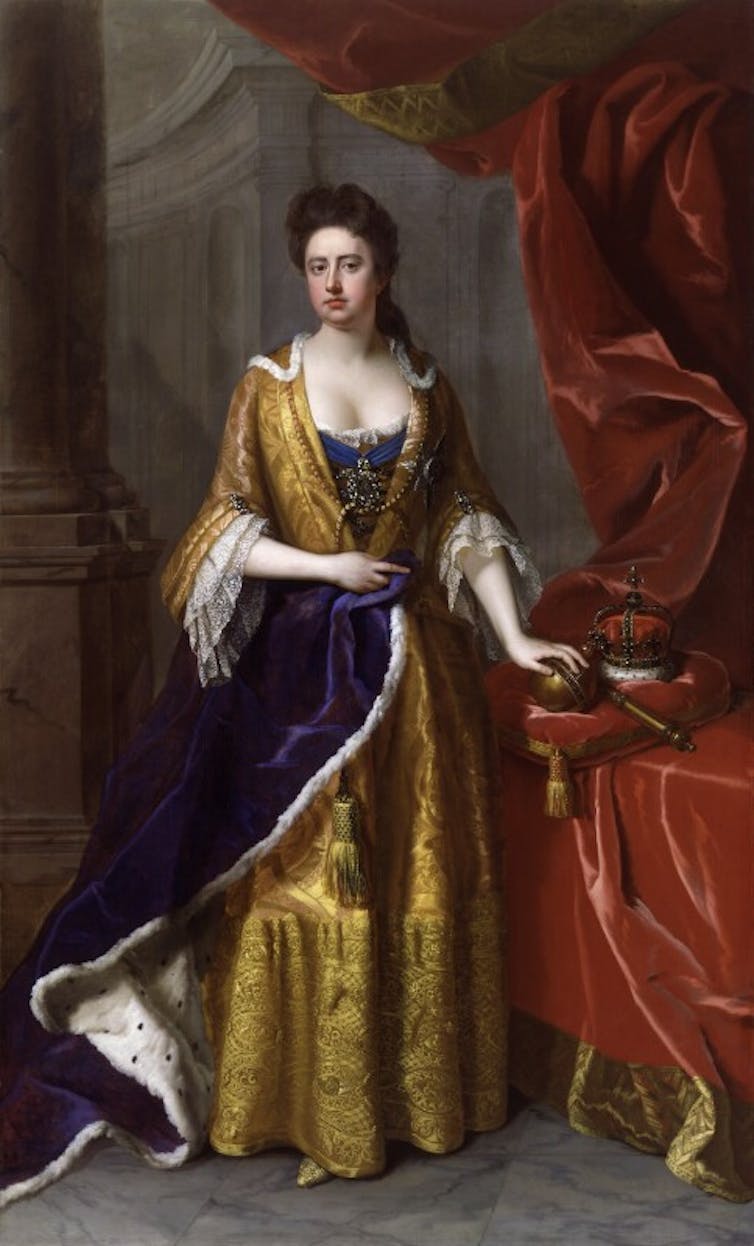
For Anne’s contemporaries, the name of the illness perhaps mattered less than the real political issue it presented: who would become monarch after her? With no heirs, there was real political fear her Catholic half-brother James Francis Edward Stuart (“The Old Pretender”) would claim the throne.
But the law excluded Catholics from the taking the crown, and ensured Anne would be succeed by her second cousin, George I of Hanover and Britain.
George III And Mental Illness
George III (1738–1820) famously suffered from bouts of mental illness, more recently been speculated to be caused by Porphyria, a hereditary blood disorder.
Throughout his illness bulletins were issued by his doctors informing the public of his condition.

These were kept deliberately vague, with the aim to reassure the public rather than divulge details. His repeated bouts of illness mean his health was a constant in the media of the time, with frequent, at times twice-daily, updates during episodes.
His illness called into question his ability to be monarch, a situation eventually resolved by the installing of his son, later George IV, as Prince Regent.
A Family Of Haemophilia
Queen Victoria has been called the “Grandmother of Europe” due to her many descendants. This also came with a deadly legacy, haemophilia, given the moniker “the royal disease”.
Haemophilia is an inherited disorder which mostly affects males, where the blood does not clot properly. This can lead to severe or spontaneous bleeding which can be dangerous if not treated properly. While the illness can be managed well today, in Victoria’s time little was known about it.
It is believed Victoria passed on the trait to three of her nine children, at a time when life expectancy for those who had the disease was just 13 years old. Two of her daughters were asymptomatic carriers, however her fourth son Prince Leopold (1853-1884) was afflicted with the disease.

While the royal family were careful to manage what information was publicly released about his illness, his status meant it garnered public attention. It was covered in medical journals of the time, and later in newspapers.
As knowledge of the illness grew, both the public and members of the royal family were able to use it to guide decisions on marriages to limit its spread.
A New Approach
In the days leading up to Elizabeth’s death on 2022, the media reported her as resting “comfortably” and provided no information on the nature of her illness. Even her death certificate failed to reveal her cause of death, other than as old age.
Charles has signalled he wants to do monarchy differently than his mother. After his recent prostate surgery, his office stated he wanted to inspire men to look after their prostates. Anecdotal evidence suggests more men have sought medical tests in response which is being called the “King Charles effect”.
Now, the announcement of Charles’s cancer diagnosis signals a new approach by the royals. ![]()
Lisa J. Hackett, Lecturer, Humanities, Arts and Social Sciences, University of New England; Huw Nolan, Animal Welfare scientist and pop culture researcher, University of New England, and Jo Coghlan, Associate Professor Humanities Arts and Social Sciences, University of New England
This article is republished from The Conversation under a Creative Commons license. Read the original article.
Finding a reasonably priced new car is almost impossible. And the second hand market is not much better

Despite most businesses around the world returning to some form of normal after the pandemic, supply chain problems continue to disrupt the manufacturing and availability of new and second hand cars.
This disruption has caused vehicle prices to sky-rocket, adding to cost-of-living pressures already being experienced by most Australians.
Car prices in Australia rose throughout 2023 with an average increase of almost 20% since April 2020, even faster than the consumer price index.
The increase has varied depending on the model, but the biggest increases – of about 25% – have been in the small car sector.
This resembles the situation in Europe where the prices of the cheapest models produced by the five biggest carmakers have increased by an average of 41% since 2019.
The Impact Of Supply Not Matching Demand
The availability and cost of buying new cars in Australia have been impacted by both demand and supply issues.
On the demand side, many new orders have been delayed by time lost during the lockdowns followed by strict social distancing requirements holding up work at all stages of the manufacturing process.
This has been worsened by new car demand increasing across all markets. In Europe, new vehicle registrations rose 11% in October 2023 for 14th consecutive month. The Federal Chamber of Automotive Industries in Australia also recorded breaking new vehicles sales in August 2023 with 15.4% increase compared to the same period in 2022.
There has also been an ongoing global shortage of semiconductors to make computer chips. Not only are these chips commonly used in household devices, they are essential as cars are increasingly automated and electric vehicles become popular.
Geopolitical Tensions
The shortage and associated hold ups, has been exacerbated by confict in the Middle East, particularly the Israel-Hamas war as Israel is a major supplier of chips to the world.
Shipping delays caused by the need to re-route car carriers due to attacks by Houthi rebels on ships operated by supporters of Israel in the conflict have also held up supply.
A shortage of the special RORO (roll on, roll off) shipping carriers used to transport cars has added to delays. While demand for car carriers has grown 37% since 2019, the fleet has barely grown.

Problems At The Australian End
When shipments do finally arrive at the Australian ports, they face port congestion. This is caused by several factors:
large amounts of cargo arriving at Australian ports and terminals at the same time as previously delayed exports are being sent offshore
higher demand for quarantine checks after pests and seeds were found in 1000s of vehicles being brought in from Asia and Europe last year
insufficient labour to conduct biosecurity checks and handle cargo
industrial action, such as the ongoing dispute at DP World-operated ports, affecting productivity.
A Second Hand Solution?
Understandably, when there is a shortage of new cars and prices are high, consumers have turned to second-hand cars which are already in the country. However, this has led to a supply-demand imbalance, reducing the availablity and increasing the cost of this once cheaper option.
The longer the wait for new cars and the higher the costs, the greater the pressure on the second-hand car market.
Some strategic customers may worsen the problem by registering to buy several different cars and then only buying the first one that arrives, therefore jacking up the demand and slowing down the process. They may also demand a high price for their used car, putting a vehicle out of reach for some would-be buyers.
It Will Take Time To Resolve
Supply will gradually catch up with demand, therefore easing the problem. But the current global geopolitical tensions and industrial action on the wharves, makes it difficult to predict when this will happen.
In the short term, the Albanese government may need to intervene to deter unhealthy trading practices. This could be achieved in the short term by imposing higher taxes on people who register to buy more cars than they need for personal use.![]()
Vinh Thai, Professor, RMIT University
This article is republished from The Conversation under a Creative Commons license. Read the original article.
Dr. Scamps Offering Free Anti-Scam Seminars
Prime Minister Launches Pop-Up Display Celebrating 40 Years Of Medicare

.png?timestamp=1707757944500)
Minister For Health And Aged Care Speech – 6 February 2024
Changes are coming for Australia’s aged care system. Here’s what we know so far
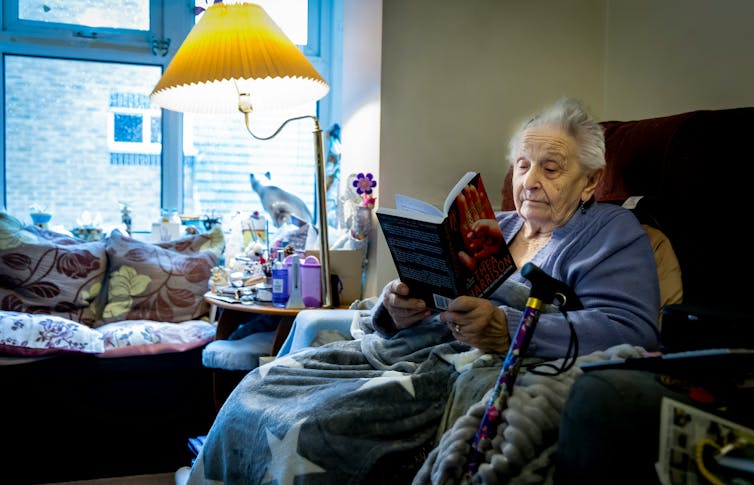
Australia’s subsidised aged care services now help around 1.5 million older people to receive care and support. Taxpayers contributed A$28 billion to the various programs in 2022-23. And yet the system is governed by an act that was first passed in 1997.
A lot has changed over the past two and a half decades – more people are living longer with chronic conditions and impairments that necessitate care, more of that care helps people stay in their own home, older people have more choice and control, and quality and safety are subject to tighter regulation and improved enforcement.
These and many other reforms are welcome. But as a result, the 1997 Aged Care Act has become a patchwork of change upon change. So when is the new act due, and what does it aim to achieve?
What We Know So Far
Following the report of the Royal Commission into Aged Care Quality and Safety, the government is rewriting the act with a view to it commencing on July 1 2024 – less than five months from now.
Parts of an initial draft of the act have been released for public consultation. The proposed act adopts a rights-based approach to caring for older Australians, and consolidates and simplifies multiple pieces of existing legislation.
Some of the improvements will include:
establishing a complaints commissioner to increase the independence and transparency of investigating aged care complaints
increasing whistleblower protections so older people, their families and aged care workers feel comfortable about exposing unacceptable treatment from a provider
streamlining access to aged care through a single-assessment process, rather than older people having to be assessed by different organisations depending on their particular care needs.
But several significant issues have yet to be addressed. The partial draft of the act lacks any provision relating to the proposed fees, payments and subsidies, or about how people with different needs will be prioritised and how aged care places will be allocated to them.
The act also makes many references to the government making rules about how the aged care system will actually operate. As always, the devil is in the detail but the rules have not yet been made public.
The new act also attempts to address the fundamental concern that Australia’s Constitution doesn’t provide the federal government with powers to make laws specifically for “aged care”. This is unlike the government’s powers over banking, marriage, the age pension and many other matters.
Instead, the act attempts to patch together a range of other powers, such as for providing sickness and hospital benefits and making binding international treaties (including disability support) under its external affairs powers.
It is unclear whether this approach will make the system too complex, compared with seeking agreement from the states to refer their powers to the federal government, or to enact a common set of laws on which both levels of government agree.
Federal Parliament will have the final say on what the act will contain and when it is passed.
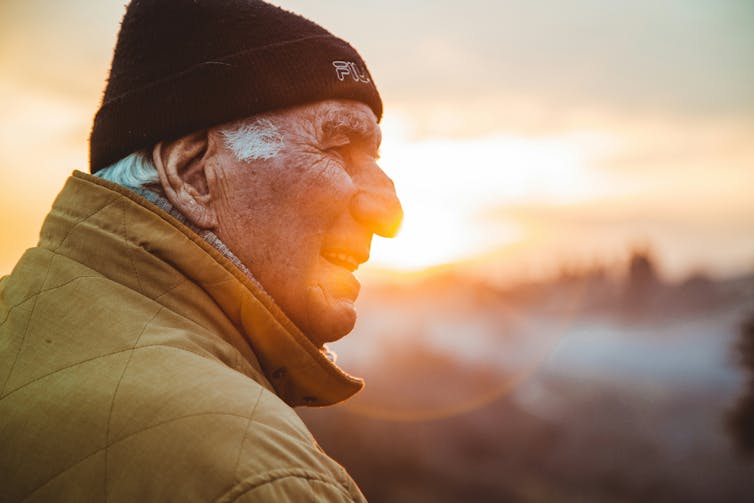
How Does This Fit With Other Recent Changes?
The new act aims to provide an enduring structure that brings the current aged care system, including recent reforms, into a single consistent regulatory regime.
The newly introduced residential care workforce standards, for instance, will be carried over to the new act. They include the requirement for 24/7 cover by registered nurses so nurses are always available to care for a resident when needed, at any time of the day or night.
The new levels of care minutes that nurses and other personal care workers must provide to residents will also be part of the new act.
The act will also include the Star Ratings for individual aged care homes. These help inform residents about the quality of the care their homes provide.
Will This Be It For A While?
The recent changes to aged care are not the end of the decade-long reform journey.
In the immediate future there will be changes to payment arrangements for care as the government responds to the – yet to be released – report of the Aged Care Task Force.
Following that, a new Support at Home program is being designed to consolidate and streamline the current home care packages, short-term restorative care and respite care. Having already been deferred twice in recent years, the current proposed start date is July 1 2025.
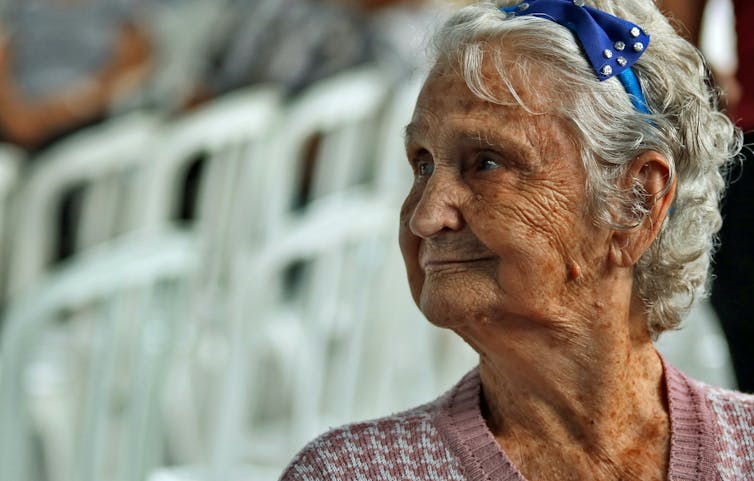
The drafting of a modern, simplified act is an important opportunity to provide the best legislative regime for caring for older Australians.
But such an opportunity comes only once every decade or two. While the new legislation needs to put older people at its centre, it must also facilitate a system that is sustainable and sufficiently robust to support them to access subsidised care when they need it.
The broad framework is there, but there are less than five months to get the details right.![]()
Michael Woods, Professor of Health Economics, University of Technology Sydney and Eugenia Tsihlis, Senior Research Assistant Law Health Justice, University of Technology Sydney
This article is republished from The Conversation under a Creative Commons license. Read the original article.
The surprisingly Australian history of Chinese dragon parades

Tomorrow will usher in the lunar Year of the Dragon. Families and friends will gather to feast, red packets will be gifted to youngsters, and dancing Chinese lions accompanied by strings of crackers will scare away evil spirits and bring good fortune to businesses.
In celebration of the new year, much-loved Chinese dragons will parade on Australia’s streets, including Sun Loong in Bendigo and the Millennium Dragon in Melbourne.
While dragon parades are popularly viewed as displays of Chinese or Cantonese tradition and culture, their history demonstrates how deeply Australian they also are.
Our historical research shows that until relatively recently Australia’s dragon parade tradition was closely associated with Chinese-Australian philanthropy and engagement with Australian civic life, rather than with Chinese spiritual practice.
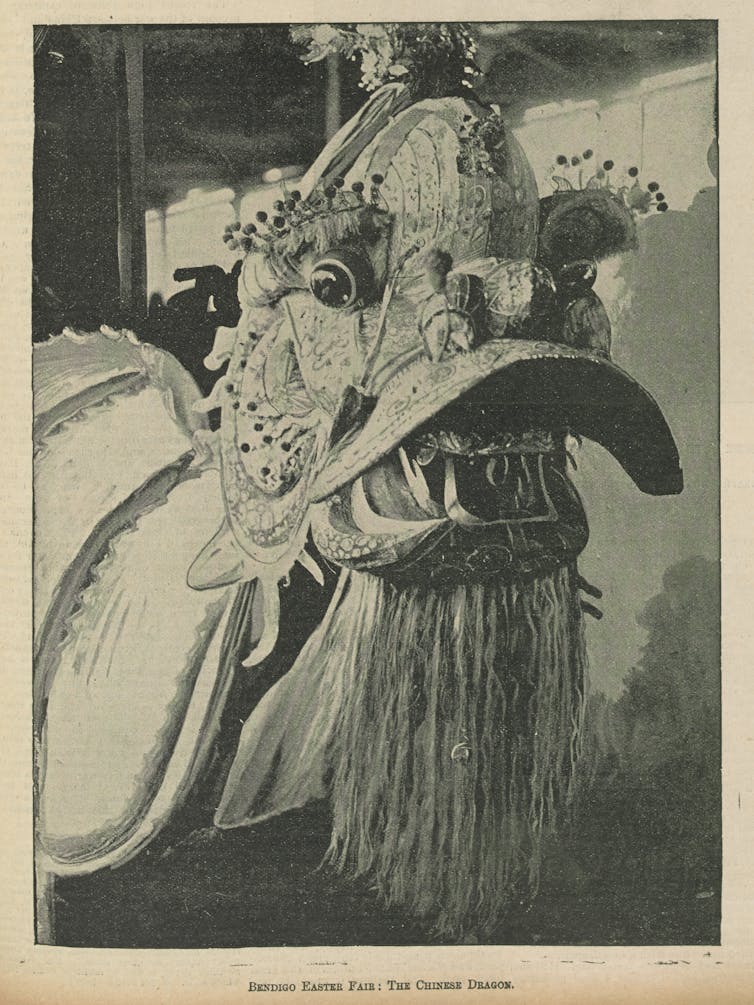
The Earliest Dragon Arrivals
Australia’s Cantonese immigrants and their descendants have long used dragon processions as ostentatious displays of their culture. Some of the organisers of dragon parades have ancestry dating back to the 19th-century gold rushes. The history of these dragons is almost as old.
The first dragon, nicknamed the “Duck Bill” dragon, was imported from Southern China to Bendigo more than 100 years ago and paraded from 1892 to 1898.
Nearby, Ballarat’s first dragon – also the oldest surviving dragon – was purchased in 1897. It was paraded until the 1960s. Ballarat’s dragon is held at Sovereign Hill.
The “Moon Face” dragon was Bendigo’s second dragon, paraded for just one year in 1900. Then, in 1901, Bendigo imported its third dragon, “Loong”. Remarkably, Loong was paraded for more than 100 years (circa 1901-2019) and now resides at the Golden Dragon Museum.
Melbourne also got its first dragon in 1901, which was paraded until about 1915. It’s now held at the See Yup Temple in South Melbourne.
Bendigo’s Chinese communities, their descendants and friends maintained a continuous dragon parading tradition. Ballarat and Melbourne’s fell away – only to be revived in 1954 to mark the visit of Queen Elizabeth II.
Meanwhile in southern China, where these parades originated, the tradition almost died out after the Cultural Revolution.
A Valued Part Of Local Fundraising
Australian streets have provided a stage for a variety of processions, with public holidays used to stage open-air fundraising activities (particularly for hospitals). Chinese communities were as keen as everyone else to assist with fundraising, display their culture and participate in festivities.
Historian Pauline Rule has shown that Chinese communities have contributed to public fundraising displays in rural cities since at least 1866.
Bendigo’s Chinese community has helped raise funds for the Bendigo Hospital at its annual Easter fair since 1879. In 1884, the organising committee of Castlemaine’s charity parade specifically sought the involvement of the local Chinese community.

The Popularity Of Dragons
Dragons were expensive and valued, and as such were also loaned to other communities for fundraising displays. In 1897, Bendigo’s Duck Bill dragon travelled to Sydney to participate in the Queen Victoria Diamond Jubilee fundraiser. Then, both Bendigo’s Moon Face and the Ballarat dragon, as well as costumes from Bendigo, Beechworth and Castlemaine, were loaned to raise funds for the Melbourne Women’s Hospital in May 1900.

That so many Victorian communities could purchase dragons demonstrated their prosperity and joint commitment to Australia philanthropy and public life. It perhaps also encouraged a friendly intercity rivalry.
Processional dragons were so popular that some communities that couldn’t access one would make their own imitation ones.

Royal Welcome
By the time the Duke and Duchess of York arrived in Melbourne to open the first federal parliament on May 6 1901, Chinese participation in public processions in Victoria was common. Of the five Chinese dragons brought to Victoria in the 19th century, three participated in Federation celebrations.
As John Fitzgerald shows, many Chinese Australians were as excited about the possibilities of Federation as other Australians. They “shared a grand vision of what Australia might become in the century ahead”. To mark the royal visit, welcome arches were constructed in Melbourne, Ballarat and Perth.
Thanks to early photography, we can identify the two dragons that paraded in Melbourne. Several photographs show Bendigo’s Loong was one of these.

Only a few long-distance photographs of the other dragon survive.

They show that, while the dragon’s beard is positioned differently and some decorations are missing, the striped horns and head match the Melbourne dragon held at the See Yup Temple in South Melbourne. According to a 1903 newspaper article, Melbourne’s Chinese Bo Leong Society had specifically purchased this dragon for the 1901 celebrations, at a cost of 250 pounds.
The third dragon involved in the festivities, the Ballarat dragon, was used to decorate the Chinese arch that welcomed the royal couple during their visit to Ballarat.

A Legacy In Australia
Astoundingly, these three Federation-era dragons – three of the five oldest surviving imperial dragons in the world – still survive today.
Traditionally, when dragons reach the end of their life they are ritually burned. That these dragons were not is another expression of their Australianness. For immigrant Chinese communities, they have acquired special value as examples of cultural practices of distant homelands. Their cultural difference and beauty also appeal to others.
Each dragon is significant in its own right, but together they are remnants of a significant history of Chinese Australians’ participation in local fundraising and celebration.![]()
Sophie Couchman, Honorary Research Fellow, Museums Victoria Research Institute and Leigh McKinnon, Research Affiliate, School of Philosophical, Historical, and International Studies, Monash University
This article is republished from The Conversation under a Creative Commons license. Read the original article.
Study Finds Strongest Evidence To Date Of Brain's Ability To Compensate For Age-Related Cognitive Decline
How Albanese could tweak negative gearing to save money and build more new homes
Peter Martin, Crawford School of Public Policy, Australian National UniversityThere are two things the prime minister needs to get into his head about tax. One is that saying he won’t make any further changes no longer works. The other is that negative gearing doesn’t do much to get people into homes.
Anthony Albanese seemed to have taken the first point on board when he spoke to The Insiders on Sunday.
Rather than promising flat out not to change the rules around negative gearing, he merely said he was
supportive of the current rules, we have not considered changes to them
But he was less careful when it came to the virtues of negative gearing. He said there was
a whole lot of analysis that says they encourage investment in housing, the key when it comes to housing is housing supply.
His official advisers in the treasury don’t think negative gearing does much to increase the supply of housing – or, if they do, they omitted it from the six-page briefing note headed “negative gearing”, prepared to help the treasurer answer questions about it in parliament.
Our Rules Reward Bad Management
Negative gearing is a particularly Australian tax benefit, which – unlike in other countries – benefits dud landlords: those who can’t make money by renting out properties.
If they lose money (by paying out more in interest, maintenance and other expenses than they are receiving in rent) we let them offset that loss, not only against income from other investments, but also against income from their wage or salary.
It means they can cut their wage for tax purposes, cutting the tax they pay on it. And at the same time, they can hang on to a property they can later sell for a profit, which will be taxed at only half the normal rate, thanks to Australia’s 50% discount on capital gains.
It isn’t allowed in the United Kingdom or the United States. There, if you are a landlord who can’t make money, you can offset your losses against profits from other investments – but not against your wage.
In Canada you can offset rental losses against wages, but there must have been an “an intention to make a profit”. That would probably rule out most Australian negative gearers.
Most Gearers Don’t Build Homes
In Australia, an astounding one million of us negatively gear – more than one in nine taxpayers. In 2020-21 they claimed losses amounting to $8.7 billion – 3.5% of the income tax collected – meaning that if they didn’t do it (if they didn’t claim for what seem to be deliberate losses) the rest of us could pay less tax.
What Albanese said on the weekend was half right. Negative gearing encourages investment. Most months, more than one in three new home loans is for an investment property.
But most of those loans don’t increase supply – the thing Albanese says matters.
That’s because the overwhelming bulk of investor home loans go to “investors” planning to buy existing homes – to bid against and likely beat would-be owner-occupiers.
In December 2023, only 23% of the loans to investors was used to build a home or buy a newly-build home. In November only 19%.
As a means of getting more homes built, negative gearing leaks like a sieve. As a means of ensuring Australians continue to rent, rather than buy, it’s effective.
In the 20 or so years since the headline rate of capital gains tax was halved, supercharging negative gearing, the proportion of Australian households renting has climbed from 26% to 30%. If those extra renters become owners, an extra 400,000 Australians would be in homes they could call their own.
How To Get Better Value From Gearing
The really bizarre thing is that Albanese has it in his power to ensure negative gearing does exactly what he said it did – supercharge the building of houses.
All he would need to do is what Labor promised to do in 2016 and again in 2019. In those elections, Bill Shorten went to voters promising to limit the use of negative gearing to newly-built homes.
As Shorten put it, taxpayers would
continue to be able to deduct net rental losses against their wage income, providing the losses come from newly constructed housing.
The sieve would no longer leak. Every dollar of tax lost to a negative gearer would help build a home.
What would have happened if Shorten had got his way: if Australia both focused the use of negative gearing and cut the capital gains discount as he had proposed?
Modelling just published in Australian Economic Papers finds the share of households who own their home rather than renting it would have climbed 4.7%.
That’s security worth having, especially if it is accompanied by more homes.
An Idea Whose Time Is Coming?
Australia’s Treasury has begun publishing estimates of the cost of the present unfocused system of negative gearing. Its latest, released last week, puts the cost at $2.7 billion per year, to which should probably be added a chunk of the $19 billion per year lost as a result of the capital gains concession.
The estimates are new. Until Jim Chalmers became treasurer, his department didn’t publish estimates of the cost of rental deductions.
Chalmers is far from the first treasurer to be curious about what the concession does. Scott Morrison expressed concern about the “excesses” of negative gearing.
And Morrison’s predecessor, Joe Hockey, said on leaving parliament that negative gearing should be skewed towards new housing, so “there is an incentive to add to the housing stock rather than an incentive to speculate on existing property”.
Albanese is normally cautious. But as he is showing us right with his rejigged Stage 3 tax cuts, there are times when he is not.
If he really wants to throw everything he has got at building more homes, he knows what to do.![]()
Peter Martin, Visiting Fellow, Crawford School of Public Policy, Australian National University
This article is republished from The Conversation under a Creative Commons license. Read the original article.
Cheaper Medicines For Advanced Melanoma And Multiple Sclerosis
University Of Sydney Receives $35 Million Grant To Fight Blindness With Manufactured Corneas
Pop-Up Display Celebrates And Educates On 40 Years Of Medicare
$20 Million For Research Into Childhood Brain Cancers
- promote collaboration between countries and across the research sector to develop new research approaches
- work to improve priority populations’ access to clinical trials.
The Medical Costs Finder Awareness Campaign Is Now Live
- find the typical costs for common private health treatments in different locations across Australia
- understand and plan for the costs of private treatment early in the journey
- access tips to confidently discuss medical costs with a specialist.
- Fact sheet – A guide for GPs – Referrals to Medical Specialists (GP)
- Printable poster – Planning a private health procedure?
- Stakeholders kit
- So, you need to see a specialist?
- A guide to out-of-pocket medical costs – helping you plan for the cost of medical treatment – Also translated into Arabic, Traditional Chinese, Simplified Korean Chinese, and Vietnamese.
- A guide for patients – choosing a specialist
Mortgage and inflation pain to ease, but only slowly: how 31 top economists see 2024
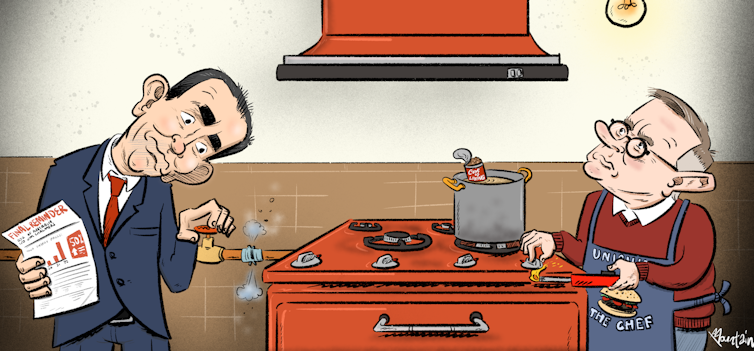
A panel of 31 leading economists assembled by The Conversation sees no cut in interest rates before the middle of this year, and only a slight cut by December, enough to trim just $55 per month off the cost of servicing a $600,000 variable-rate mortgage.
The panel draws on the expertise of leading forecasters at 28 Australian universities, think tanks and financial institutions – among them economic modellers, former Treasury, International Monetary Fund and Reserve Bank officials, and a former member of the Reserve Bank board.
Its forecasts paint a picture of weak economic growth, stagnant consumer spending, and a continuing per-capita recession.
The average forecast is for the Reserve Bank to delay cutting its cash rate, keeping it near its present 4.35% until at least the middle of the year, and then cutting it to 4.2% by December 2024, 3.6% by December 2025 and 3.4% by December 2026.
The gentle descent would deliver only three interest rate cuts by the end of next year, cutting $274 from the monthly cost of servicing a $600,000 mortgage and leaving the cost around $1,100 higher than it was before rates began climbing.
Six of the experts surveyed expect the Reserve Bank to increase rates further in the first half of the year, while 20 expect no change and three expect a cut.
Former head of the NSW treasury Percy Allan said while the Reserve Bank would push up rates in the first half of the year to make sure inflation comes down, it would be forced to relent in the second half of the year as unemployment grows and the economy heads towards recession.
Warwick McKibbin, a former member of the Reserve Bank board, said the board would push up rates twice more in the first half of the year as insurance against inflation before leaving them on hold.
Former Reserve Bank of Australia chief economist Luci Ellis, who is now chief economist at Westpac, expects the first cut no sooner than September, believing the board will wait to see clear evidence of further falls in inflation and economic weakening before it moves.
Inflation To Keep Falling, But More Gradually
Today’s Reserve Bank board meeting will consider an inflation rate that has come down faster than it expected, diving from 7.8% to 4.1% in the space of a year.
The newer more experimental monthly measure of inflation was just 3.4% in the year to December, only points away from the Reserve Bank’s target of 2–3%.
But the panel expects the descent to slow from here on, with the standard measure taking the rest of the year to fall from 4.1% to 3.5% and not getting below 3% until late 2025.
Economists Chris Richardson and Saul Eslake say while inflation will keep heading down, the decline might be slowed by supply chain pressures from the conflict in the Middle East and the boost to incomes from the tax cuts due in July.
Slower Wage Growth, Higher Unemployment
While the panel expects wages to grow faster than the consumer price index, it expects wages growth to slip from around 4% in 2023 to 3.8% in 2024 and 3.4% in 2025 as higher unemployment blunts workers’ bargaining power.
But the panel doesn’t expect much of an increase in unemployment. It expects the unemployment rate to climb from its present 3.9% (which is almost a long-term low) to 4.3% throughout 2024, and then to stay at about that level through 2025.
All but two of the panel expect the unemployment rate to remain below the range of 5–6% that was typical in the decade before COVID.
Economic modeller Janine Dixon said the “new normal” between 4% and 5% was likely to become permanent as workers embraced flexible arrangements that allow them to stay in jobs in a way they couldn’t before.
Cassandra Winzar, chief economist at the Committee for the Economic Development of Australia, said the government’s commitment to full employment was one of the things likely to keep unemployment low, along with Australia’s demographic transition as older workers leave the workforce.
Slower Economic Growth, Per-Capita Recession
The panel expects very low economic growth of just 1.7% in 2024, climbing to 2.3% in 2025. Both are well below the 2.75% the treasury believes the economy is capable of.
All but one of the forecasts are for economic growth below the present population growth rate of 2.4%, suggesting that the panel expects population growth to exceed economic growth for the second year running, extending Australia’s so-called per capita recession.
The lacklustre forecasts raise the possibility of what is commonly defined as a “technical recession”, which is two consecutive quarters of negative economic somewhere within a year of mediocre growth.
Taken together, the forecasters assign a 20% probability to such a recession in the next two years, which is lower than in previous surveys.
But some of the individual estimates are high. Percy Allen and Stephen Anthony assign a 75% and 70% chance to such a recession, and Warren Hogan a 50% chance.
Hogan said when the economic growth figures for the present quarter get released, they are likely to show Australia is in such a recession at the moment.
The economy barely grew at all in the September quarter, expanding just 0.2% and was likely to have shrunk in the December quarter and to shrink further in this quarter.
The panel expects the US economy to grow by 2.1% in the year ahead in line with the International Monetary Fund forecast, and China’s economy to grow 5.4%, which is lower than the International Monetary Fund’s forecast.
Weaker Spending, Weak Investment
The panel expects weak real household spending growth of just 1.2% in 2014, supported by an ultra-low household saving ratio of close to zero, down from a recent peak of 19% in September 2021.
Mala Raghavan of The University of Tasmania said previous gains in income, rising asset prices and accumulated savings were being overwhelmed by high inflation and rising interest rates.
Luci Ellis expected the squeeze to continue until tax and interest rate cuts in the second half of the year, accompanied by declining inflation.
The panel expects non-mining investment to grow by only 5.1% in the year ahead, down from 15%, and mining investment to grow by 10.2%, down from 22%.
Johnathan McMenamin from Barrenjoey said private and public investment had been responsible for the lion’s share of economic growth over the past year and was set to plateau and fade as a driver of growth.
Home Prices To Climb, But More Slowly
The panel expects home price growth of 4.6% in Sydney during 2024 (down from 11.4% in 2024) and 3.1% in Melbourne, down from 3.9% in 2024.
ANZ economist Adam Boyton said decade-low building approvals and very strong population growth should keep demand for housing high, outweighing a drag on prices from high interest rates. While high interest rates have been restraining demand, they are likely to ease later in the year.
In other forecasts, the panel expects the Australian dollar to stay below US$0.70, closing the year at US$0.69, it expects the ASX 200 share market index to climb just 3% in 2024 after climbing 7.8% in 2023, and it expects a small budget surplus of A$3.8 billion in 2023-24, followed by a deficit of A$13 billion in 2024-25.
The budget surplus should be supported by a forecast iron ore price of US$114 per tonne in December 2024, down from the present US$130, but well up on the US$105 assumed in the government’s December budget update.
The Conversation’s Economic Panel
Click on economist to see full profile.
Download the answers as XLS PDF![]()
Peter Martin, Visiting Fellow, Crawford School of Public Policy, Australian National University
This article is republished from The Conversation under a Creative Commons license. Read the original article.
Safety First As NSW Public Schools Trial New Purpose-Built AI Tool For Students
- The app is privately secured which ensures data is controlled by, and only visible to, the department. This safeguards against potential breaches of data security and privacy issues associated with the use of publicly available generative AI apps.
- Department control of NSWEduChat app means that the responses generated are aligned with NSW and Australian curriculums and the department’s values and policies.
- The app only responds to students’ questions that relate to school activities and education-related topics and uses content filtering and topic restriction. It has embedded safeguards to monitor and remove inappropriate content.
- It does not reveal full answers to students. NSWEduChat encourages critical thinking by asking guided questions and inviting students to reason on the outcome of their questions, instead of providing direct answers.
- It also provides higher-quality, more accurate support for free that is currently only available through premium-paid AI tools.
NSW Government Continues To Engage With GPs On Payroll Tax
Indigenous trailblazer Lowitja O'Donoghue dies aged 91

Aboriginal and Torres Strait Islander readers are advised this article contains the name and images of a deceased person.
One of Australia’s most highly-regarded Indigenous leaders, Dr Lowitja O’Donoghue, has died aged 91.
O'Donoghue, a Yankunytjatjara woman, was the inaugural chair of the Aboriginal and Torres Strait Islander Commission from 1990 to 1996, and a leading figure in debates over Indigenous rights and policy for multiple decades.
She suffered, and triumphed over, the privations and struggles of so many Aboriginal people, including being removed from her mother as a toddler and handed over to missionaries.
After facing initial resistance to her desire to enter nursing, because she lacked the required scholastic qualification, she became the first Aboriginal trainee nurse at the Royal Adelaide Hospital.
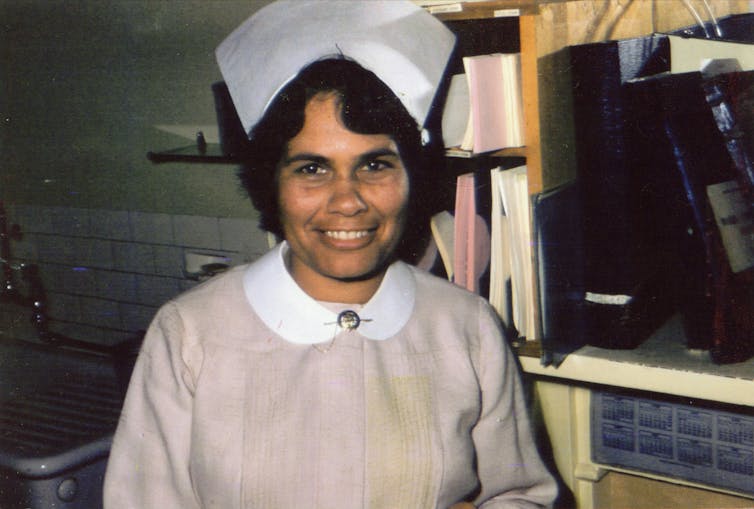
Later she was the first woman to be a regional director of an Australian federal department.
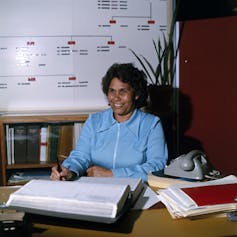
She was involved in Indigenous causes ranging in scope from the 1967 referendum to the native title legislation of the 1990s.
In 1984 she was Australian of the Year; in 1999 she became a Companion of the Order of Australia – the top honour – “for public service through leadership to Indigenous and non-Indigenous Australians in the areas of human rights and social justice”.
She turned down Paul Keating’s offer of the governor-generalship. She told The Australian, “I told him, ‘I’m a republican. And so are you.”
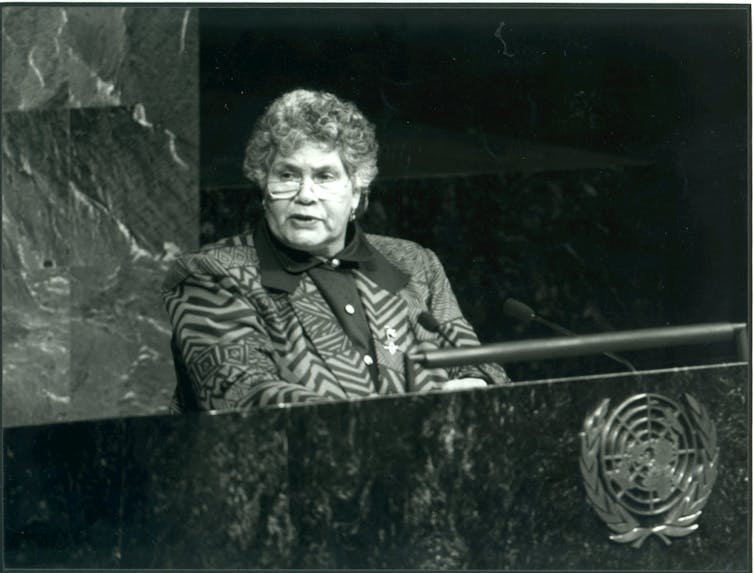
Her family said in a statement announcing her death: “Aunty Lowitja dedicated her entire lifetime of work to the rights, health, and wellbeing of Aboriginal and Torres Strait Islander peoples”.
‘A Giant For Our Country’
Prime Minister Anthony Albanese described O'Donoghue as “a figure of grace, moral clarity, and extraordinary inner strength.
"With an unwavering instinct for justice and a profound desire to bring the country she loved closer together, Dr O’Donoghue was at the heart of some of the moments that carried Australia closer to the better future she knew was possible for us, among them the Apology to the Stolen Generation and the 1967 referendum. She provided courageous leadership during the Mabo debates and as chair of the Aboriginal and Torres Strait Islander Commission,” Albanese said.
“Dr O'Donoghue knew that our best future was a shared one built on the strong, broad foundations of reconciliation.”
The Minister for Indigenous Australians, Linda Burney, said: “Lowitja was not just a giant for those of us who knew her, but a giant for our country.”
“Lowitja’s leadership and tenacity has been an inspiration for generations of Aboriginal and Torres Strait Islander Australians, including myself.”
Indigenous leader Tom Calma described O'Donoghue as “a real hero for Aboriginal and Torres Strait Islanders and for many other Australians. She always had all Australians in mind.
"She was a mentor of mine in my early days. She taught me how to be a good public servant and to operate ethically.”
Noel Pearson said O'Donoghue was “a leaders’ leader”.
“There were two ATSICs, one under Lowitja and the other after,” Pearson said. “It failed at the national level after Lowitja’s term as chair expired, but it was always a force for good in the regions and communities.
"Without Lowitja’s ATSIC we would never have defended Eddie Mabo’s great legacy and negotiated the Native Title Act and Indigenous Land Fund.”
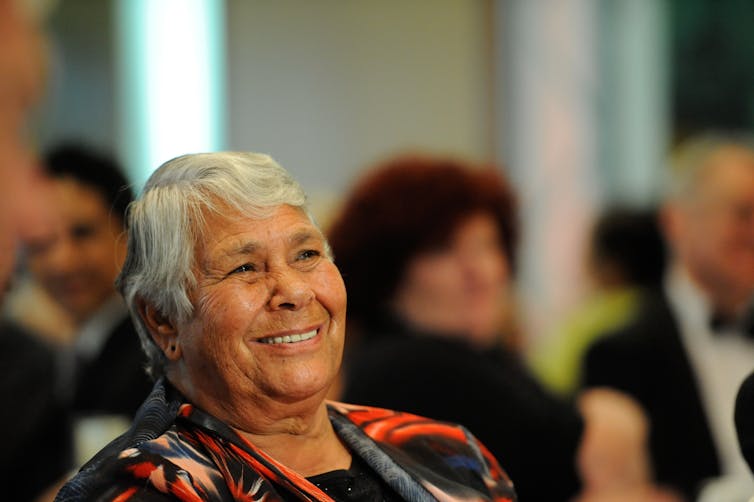
Lowitja Institute patron Pat Anderson said she was “a national treasure”.
“Courageous and fearless in leading change, Lowitja was continually striving for better outcomes for Aboriginal and Torres Strait Islander peoples. She will remain in my heart as a true friend and an inspiration to Australians for years to come.”
Keating Pays Tribute
Keating said in a statement that O'Donoghue “led the Aboriginal and Torres Strait Islander Commission with great power and ambition.
"Upon my beginning to give effect to the High Court decision in Mabo, early in 1992, she, at her own initiative, assembled the leadership of her nations’ Land Councils to form an Aboriginal representative group to negotiate a Native Title Act, with me as Prime Minister, leading the Commonwealth government initiative.
"It was the first and only time the Aboriginal community of Australia was brought into the Commonwealth Cabinet Room for what became a deep and eight month consultation in the design of the Native Title Act.
"The consultation which gave effect to an Aboriginal voice speaking and representing a national community in designing a law to recover their expropritated traditional lands. A voice Lowitja put together out of insight and courage.
"The success of the Native Title Act can be measured by the fact that through its operation, Aboriginal people now have title to approximately 46% of the Australian land mass and when all the claims are heard by the Native Title Tribunal in the now ensuring years, Aboriginal title is likely to extend to around 65% of the continent,” Keating said.![]()
Michelle Grattan, Professorial Fellow, University of Canberra
This article is republished from The Conversation under a Creative Commons license. Read the original article.
How Lowitja O'Donoghue’s activism and leadership changed advocacy on Indigenous affairs in Australia
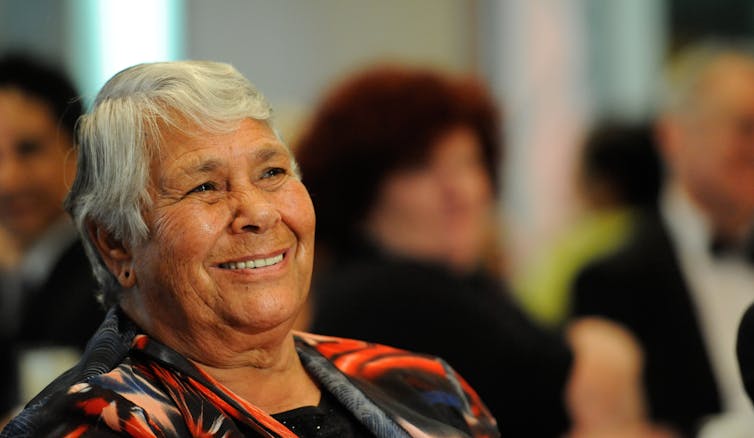
Aboriginal and Torres Strait Islander readers are advised this article contains the name and images of a deceased person.
In the many tributes that have flowed since the announcement of Lowitja O’Donoghue’s death on February 4 at age 91, many commentators have noted her leadership and commitment to public life over many years.
Of her many public roles, chairing the Aboriginal and Torres Strait Islander Commission (1990-2005) across the first six years of its life stands out. No other Indigenous leader has occupied a similar position before or since.
What can we learn from her leadership?
An Activist And Trailblazer
Removed, marginalised and discriminated against from birth, in a country that refused to recognise her identity or aspirations, O'Donoghue’s political maturation came early when she moved to Adelaide to become a trainee nurse in the 1950s.
There she joined the Aborigines Advancement League and helped spearhead campaigns for civil rights.
In 1967 she joined the Commonwealth Department of Aboriginal Affairs, rising to become regional director from 1975-79. In 1977, O'Donoghue was appointed the inaugural chair of the National Aboriginal Conference (NAC) and subsequently appointed as chair of the Aboriginal Development Commission.
She was also chair of Aboriginal Hostels Ltd from 1982-90 and a founding member of the Council of Aboriginal Women of South Australia.
In 1984, she was commissioned by Aboriginal Affairs Minister Clyde Holding to consult with Indigenous communities about a new consultative organisation to replace the NAC. A key recommendation of her report was the establishment of regional assemblies across Australia, a model that became central to ATSIC.
Inaugural Chair Of ATSIC
O'Donoghue was regarded as the logical choice for inaugural chair of ATSIC. A statutory body, combining representative, advisory and administrative functions, ATSIC was unlike all previous representative bodies for Indigenous Australians.
She steered a board of 17 regional commissioners, along with an extra two commissioners appointed by the minister. There were also between 600 and 800 regional councillors (including chairpersons) in 35 regions across Australia, prosecuting a national position while catering to regional concerns.
She liaised with a chief executive and the minister, and an administrative wing of about 1,000 public servants. She and the board administered 50% of the federal government’s budget in Aboriginal affairs, dispensing something in the order of 6,000 grants to about 1,500 incorporated Indigenous organisations by the mid 1990s.
O’Donoghue took to the task with gusto and hope. Her first order of business was steering a national Aboriginal response to the 1991 report of the Royal Commission into Aboriginal Deaths in Custody, which she described as the “most important social document of the 20th century”. She attended as many regional council meetings as she could and, in an historic cabinet meeting in 1991, was among a small group that presented a report to Paul Keating on Aboriginal priorities.
Negotiating Mabo
Not long after this, O'Donoghue was required to steer ATSIC’s response to the Mabo decision. This was no small task, as it unleashed a torrent of discontent across Australia and resistance in many quarters.
O’Donoghue, ATSIC and other Aboriginal representatives developed a list of bedrock demands. Compromises were made, but under O'Donoghue’s determined steerage, ATSIC hung on to several demands, notably the retention of the threatened Racial Discrimination Act.
This was a highlight of her career, not least because it demonstrated that ATSIC was no “toothless tiger” and showcased the acumen of a rising Aboriginal political sector.
Later, ATSIC pushed for the development of a social justice package in order to cater to “the dispossessed” – the majority of Aboriginal people unable to benefit from native title law.
After extensive community consultation in conjunction with the Reconciliation Council, an historic document was produced, Recognition, Rights and Reform, calling for institutional , structural, collaborative and co-operative change.
Social justice was predicated on moving from welfare to rights, from dependency to autonomy and from government assistance to self-determination. A major theme in the report was a desire to redefine Indigenous Australians’ relationship with governments. ATSIC measured all its programs in terms of social justice. With this document, they hoped to achieve it by 2001.
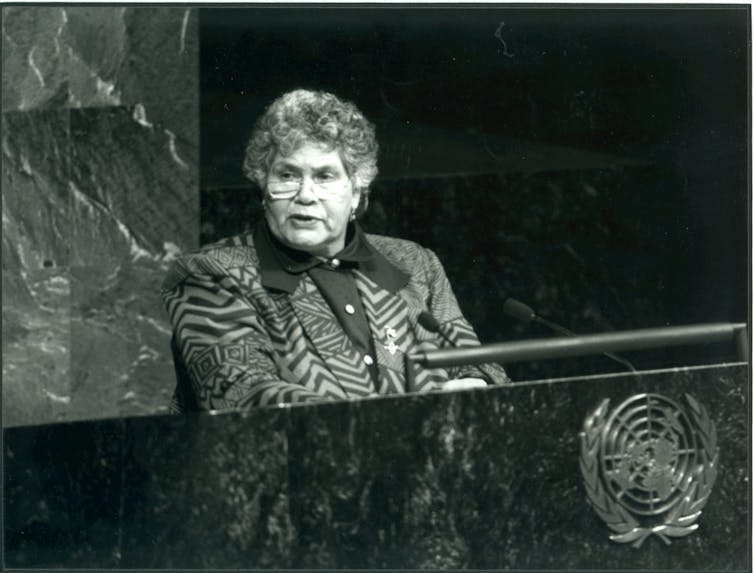
Taking Indigenous Advocacy Around The World
In O'Donoghue’s papers in the National Library of Australia are several large bound volumes of her published speeches during her time at ATSIC, the writing and delivery of which constituted an important part of her advocacy. Particularly impressive is the diverse audiences she pitched to: the Royal Institute of Public Administration, various industry and professional associations, business and economic forums, health professionals, politicians and public servants.
She always impressed on her audience the immense task of ATSIC, reminding them of its political and financial constraints, and arguing that it would take time to turn around 200 years of dispossession.
She regularly spoke at the UN. In 1993, the international year of the world’s Indigenous peoples, she spoke at the World Conference on Human Rights at Vienna. She told her audience not to underestimate the serious nature of human rights abuses in Australia, noting that “as Aboriginal people we ask no more than the basic human right of being given the opportunity to determine our own future”.
In his PhD thesis on Indigenous engagement with the UN, Indigenous scholar Graeme La Macchia shows how in the development of the United Nations Declaration on the Rights of Indigenous Peoples, member states became anxious about words like self-determination. He shows how O'Donoghue held firm, arguing that nothing short of political self-determination and economic empowerment would suffice for the world’s Indigenous people.
A Profound Legacy
In her farewell address, O'Donoghue described her time at ATSIC as intense, exhilarating and, at times, exhausting.
The final months of her tenure were marred by a hostile relationship to an incoming Coalition government looking to reform ATSIC, and a constant repetition of ATSIC’s alleged accountability crisis in the public domain, what she described as “the myth of the wasted millions”.
This did not detract from the fact that this Yankunytjatjara woman from Central Australia rose to become the longest-serving leader of the longest running Indigenous political organisation of the postwar era.
ATSIC was a pioneering institution, observed across the globe. We should know and remember her considerable contribution to this important part of our political history.![]()
Alison Holland, Associate Professor, Macquarie University
This article is republished from The Conversation under a Creative Commons license. Read the original article.
Genetic Discrimination In Life Insurance Must End: AMA
NASA is looking for commercial Mars missions. Do people still want to go to Mars?
Steven Tingay, Curtin UniversityMars has been a source of myth, lore and inspiration since antiquity. It is also an interesting place to research – a legitimate candidate for us to find some form of alien life.
Since the 1960s, Mars has been a popular destination for space missions. Now, for the first time, NASA has invited the private sector to submit proposals on commercial Mars missions.
These missions would range from carrying various payloads to the red planet, to providing communications relay services. No talk of a Mars astronaut just yet.
But do people still want to go to Mars? Absolutely. One question is, what is the best way to get people there? Another question – should we?
Modern Exploration Of Mars
Since 1960, there have been 50 missions with scientific and technical objectives related to Mars. Thirty-one of these have been deemed successful, which is not a bad strike rate.
There have also been plenty of spectacular failures, like the crash of the Schiaparelli lander in 2016.
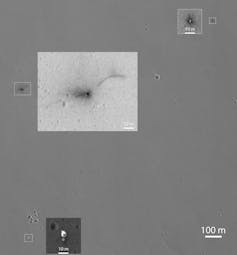
These missions have returned a wealth of information about Mars – its atmosphere, orbit, geology and more. According to some parts of the internet, they have also returned amazing images of “faces” on its surface, “doors” in rocky cliffs and “fossilised bones”.
In all cases, geologists had more mundane explanations (rocks). But such public interest shows that Mars truly occupies our imaginations.
A typical interplanetary space mission costs at least a billion US dollars, so the world’s major space agencies have spent no less than US$50 billion on Mars over the years. And this is just to send cameras, rovers and landers. To send people to Mars would be next level.

A Better Way To Do Business?
NASA is starting to explore different ways to undertake space missions. For decades, NASA and other space agencies around the world have spent large sums on in-house planning, development, prototyping and production for space missions.
In the 2020s, the technologies that enable and support space exploration are increasingly being developed in the commercial world. An example most people will be familiar with is Elon Musk’s SpaceX. Many of the SpaceX objectives have Mars and beyond as the ultimate goal – “making humanity interplanetary”.
The development of the Falcon rockets by SpaceX, Starlink satellites, and the Starship rocket could not be further from NASA’s historical model. Where the NASA approach has been conservative, SpaceX makes lots of changes fast, iterates quickly, and learns quickly from failure.
And SpaceX is not alone. There is a growing industry of commercial providers of access to space, particularly in the United States.
NASA’s current roadmap involves going “back to the Moon” to re-establish a human presence with the Artemis program, then on to a human presence on Mars. In this roadmap, the concept of leveraging commercial providers has taken hold.
Instead of in-house development, NASA is moving in favour of specifying requirements and then assessing the solutions commercial providers might supply in a competitive process.
Pros And Cons
It appears that now, even compared to 20 years ago, such an approach has become much more viable, as demonstrated by SpaceX. In theory, it could be cheaper and more efficient.
Likely the bigger positive effect will be the substantial stimulus to the commercial sector. With companies innovating to meet the requirements of space missions, the technology spin-offs will potentially have more economic and social impact than getting to Mars itself.
There is a good history of this from the development of technologies for space and from mega-science projects more generally.
However, it is very early days and the commercial approach has to prove itself. There is always an argument that once you start to cease in-house development at a place like NASA, capabilities start to gradually decay. Time will tell. The first steps – reaching the Moon – will go a long way in testing the approach.
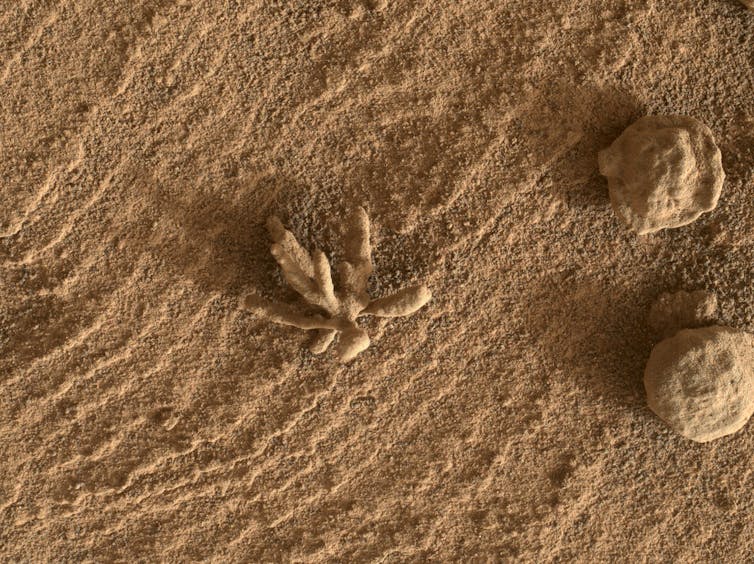
But Should Humans Go To Mars?
Mars entered the modern psyche as a place of mystery, promise and danger. This was illustrated vividly more than 100 years ago by H.G. Wells in the novel The War of the Worlds. The number of books, songs, TV shows and movies about Mars is enormous, containing some great (and not so great) art.
Should humans go to Mars? Musk wants to do it, sure. In the 2010s, the Dutch Mars One startup selected 100 volunteers to travel to Mars on a one-way ticket and raised millions of dollars before going bankrupt in 2019. There will always be some cross-section of society wanting to live on Mars.
Some will argue that before humans become interplanetary and start to “mess up” another planet, we should make sure Earth is looked after. Others point out that space exploration should do more to include sustainability.
Despite this debate, if the history of human exploration is anything to go by, you only need a tiny fraction of the population to be motivated enough to do it. If they also have the capital, it will happen.
I can’t see that Mars will be much different.![]()
Steven Tingay, John Curtin Distinguished Professor (Radio Astronomy), Curtin University
This article is republished from The Conversation under a Creative Commons license. Read the original article.
Millions of Australians have a chronic illness. So why aren’t employers accommodating them?
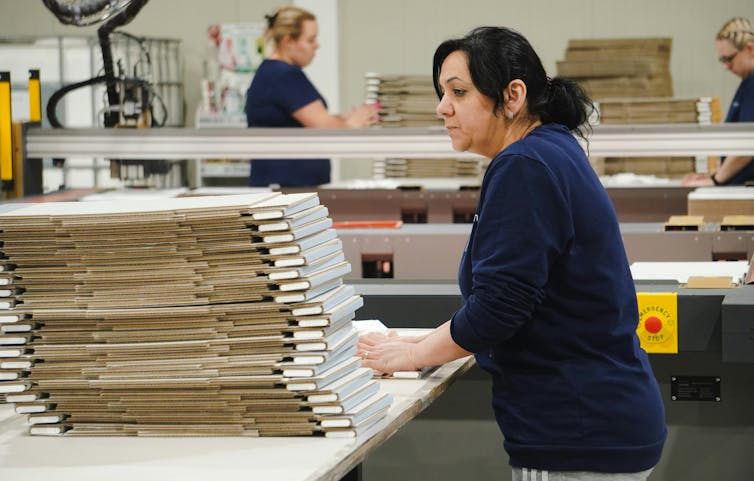
More than 20 million Australians have at least one long-term health condition, 63% of whom are in the workforce.
The causes of chronic illness are complex and are often unconnected to a person’s work. But at times, the continued exposure to work stressors can lead to or exacerbate chronic health conditions including musculoskeletal disorders, heart disease, anxiety and depression.
Our research found 73% of people believed their chronic illness was at least partially caused or worsened by their job. Almost one in five people believed work entirely caused or worsened their illness.
These findings accord with data from Safe Work Australia which indicates health conditions (particularly mental health) account for an increasing proportion of serious workers’ compensation claims.
Our research also found people with chronic illness were likely to report various forms of workplace discrimination, including being rejected from a job (63%), being treated unfairly in the workplace (65%) and harassment (52%).
So what are employers getting so wrong? And what are the solutions to improving working conditions for people with chronic illnesses?
Employers’ Responsibilities Have Grown
In 2022, Safe Work Australia updated its work health and safety regulations to include specific guidelines on the management of “psychosocial” hazards in the workplace.
A psychosocial hazard is anything that can cause psychological and physical harm, including the design or management of work and workplace interactions or behaviours.
Common examples include job demands, low job control, poor support, lack of role clarity, exposure to traumatic events, harassment and bullying. The failure to eliminate or minimise psychosocial hazards can cause work-related stress, resulting in poor health outcomes for workers.

Organisations need to improve their engagement and management of chronically ill workers to meet their legal obligations.
How Employers Are Getting It Wrong
Few organisations have sophisticated approaches to managing employees who are chronically ill. And managers often feel ill-equipped to effectively support chronically ill employees.
Instead, there is a tendency to rely on outmoded human resource and occupational health and safety systems originally designed to accommodate short-term absences and acute illnesses.
Return-to-work policies tend to fall short because they assume a phased and linear return to full working capacity. This is often not the case for people with chronic illness, whose symptoms may be degenerative or fluctuate over time.
Chronically ill workers are rarely considered in organisational diversity and inclusion policies and procedures. At best, they may be incorporated into umbrella disability policies, which can be problematic as people with chronic illness do not necessarily self-identify as “disabled”.
Many chronically ill workers fly under the radar. This is partly because organisations don’t collect this data but it’s also due to the often invisible nature of chronic illness. Someone living with conditions such as long COVID or endometriosis, for example, may present as unimpaired to their colleagues. However, they will often be dealing with complex, fluctuating symptoms that are largely invisible at work.
Workers may also choose not to disclose their illness due to fears of being stigmatised, treated differently, or passed over for promotion. Our research on leaders living with chronic illness found only 18% fully disclosed their illness to their employer. Almost three-quarters of leaders with chronic illness (73%) deliberately hid their illness at work.
What Can Employers Do?
Here are three ways employers can begin to proactively meet their obligations to workers with chronic illness.
1. Make adjustments
Workers with chronic illness sometimes experience fluctuations in their condition which can impact their ability to complete tasks or meet deadlines. It may be necessary for managers to consider sensitively discussing a revised work schedule, the delegation of time-sensitive tasks, or discuss implementing reasonable adjustments to improve workflow.
These can be challenging conversations, but engaging with them directly means employers can allocate the resources they need to meet their business objectives, while also reducing employee experiences of overwhelm.
2. Accept reasonable requests
Workers with chronic illness may require reasonable adjustments, such as flexible working, to enable them to perform to the best of their ability.
Take these requests at face value and minimise the administrative hurdles associated with approving such accommodations. Failing to do so is likely to erode trust, entrench feelings of not being supported and increase an employee’s psychological distress.

3. Train managers
Managers may sometimes deny a request for a reasonable adjustment based on the belief that this creates a precedent for all team members. Decisions like these can compound feelings of stress, as they may be experienced as a lack of procedural fairness by employees living with chronic illness.
With appropriate training, managers are more likely to recognise that chronically ill workers are generally not seeking “special treatment”, but ways to work more effectively within their changed capacities.
By recognising the value of employees of all abilities, and proactively and systematically addressing the needs of their chronically ill workforce, employers can minimise extended workplace absences and improve the productivity of their workforce. ![]()
Peter Ghin, Research fellow, Future Of Work Lab, Faculty of Business and Economics, The University of Melbourne and Susan Ainsworth, Professor of Management and Marketing, The University of Melbourne
This article is republished from The Conversation under a Creative Commons license. Read the original article.
No more BMI, diets or ‘bad’ foods: why changing how we teach kids about weight and nutrition is long overdue

How many of us recall having to calculate our body-mass index (BMI) as children at school, prompting comparisons of our weight with that of our peers? Or perhaps we remember references to calories and diets in the classroom.
Now, the Australian curriculum is changing how children and young people are educated about their bodies and what they eat, in a bid to prevent eating disorders.
Hundreds of references to terms including BMI, weight, calories and diets have been removed from school resources by the Australian Curriculum, Assessment and Reporting Authority, replaced with terminology such as “balanced nutrition”.
As a clinical psychologist specialising in the treatment of children and young people with body image and eating disorders, I welcome these changes. Given what we know about the links between weight stigma and the development of eating disorders, they’re long overdue.
Weight Stigma Starts Early
Weight stigma and diet culture are rife in our society.
People will often use words such as “fat” and “guilt” to cast shame over their own or others’ body size and food choices. On the flip side, the latest diets and other weight loss techniques are regularly hot topics of conversation among friends and colleagues.
Evidence shows this sort of talk around children and young people can be very damaging, in some cases contributing to the development of disordered eating. So in the school environment we need to be especially mindful of the language we use around people’s bodies and food.
Children learn about their bodies and nutrition when they start school, and this can be where a lot of misinformation (such as being fearful of certain foods because they’re deemed to be “bad” for us) and stigma begins. Peer teasing for size, weight and shape is common and increases the risk of a child or young person developing an eating disorder.
I treat many adults who have severe eating disorders partly as a result of growing up in a society that overvalues thinness, promotes dieting for weight loss, and shames people who are overweight or obese. Much of this appears to have come from the influences of their schooling.
Fostering Positive Body Image
We’ve known for a long time that early intervention through educating our children about well-being and positive mental health strategies is important to reduce the incidence of severe mental health conditions.
For eating disorders specifically, positive role modelling by adults around how we talk about our own and others’ bodies is crucial.
This can include describing people for their interests and qualities rather than their appearance, and teaching children about gratitude and respect towards each other.
Research shows learning about body acceptance and appreciation is important for both males and females in developing a positive body image. Those children and young people who have a positive relationship with their bodies and food are much less likely to develop eating disorders.
Teachers have an important role in educating our children about body respect and having a healthy relationship with their bodies and eating.
This can be achieved through actions including avoiding comments about people’s appearances, talking about food for its function in our bodies, and not attaching moral values (such as “good” or “bad”) to the foods we eat. Indeed, the curriculum overhaul warns teachers against using these descriptors.
How To Talk About Food With Kids
Learning about the importance of feeding our bodies and listening to our body’s needs is important for children.
We need to talk about food for its function in our bodies (such as carbohydrates for energy and fats for our brain). We should talk about foods we eat to help us concentrate and fuel our bodies as well as making us strong and helping us feel well.
The curriculum changes appear to be designed to connect nutrition to physical and mental health in these ways.
Food should also be presented as an enjoyable and a social activity (for example, sharing food with others).
Everyone’s appetite is different at different times and that’s OK. Helping children understand how to respond to their appetite and knowing when they’re hungry and full is important, as we know this helps with issues such as restrictive and binge eating, two common disordered eating behaviours.

Everyone Has A Role
Hopefully we are on the way to saying goodbye to the harm of weight stigma and diet talk in schools.
The biggest challenge is that we live in an appearance-obsessed world with a diet culture and many people have a fixed way of thinking about food and bodies that’s hard to shift. As adults we have to work really hard to be better role models.
While teachers play a crucial role, children also need other adults to go to who make them feel understood and accepted. Being a positive role model means listening to children’s concerns, and being be mindful of the way you talk about yours and others’ bodies, as well as the sort of language you use around eating and food.![]()
Vivienne Lewis, Assistant professor – Psychology, University of Canberra
This article is republished from The Conversation under a Creative Commons license. Read the original article.
Disclaimer: These articles are not intended to provide medical advice, diagnosis or treatment. Views expressed here do not necessarily reflect those of Pittwater Online News or its staff.